By KATIE PROUT P. 12
When police lie in court p. 20
Over the last four years, more than 150 people have died from opioidrelated overdoses on the CTA—but CTA officials aren’t keeping track.


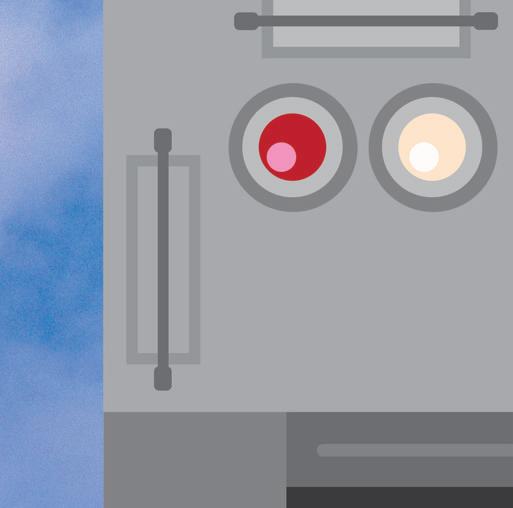






Verse inspired by Lehman Brothers p. 25

FREE AND FREAKY SINCE 1971 | OCTOBER 5, 2023
Singer Yvonne Gage p. 36
Comedian Liz Miele p. 30
























































































THE BODY CONFIDENT QUEENS

WEDNESDAY, OCTOBER 18










VIP COCKTAIL HOUR 6-7PM

GENERAL 7-11PM
EPIPHANY CENTER FOR THE ARTS 201 S ASHLAND AVE
DRESS CODE: YELLOW OR GOLD




CHICAGOREADER.COM/UNGALA

THE TRENCHIES



featuring
SEE STARS AT THE
ALYSSA LOW BLESSTONIO
DJ IGGY
LADY D
NAIRA NOTAPLANTSHOP
ROCKSTAR EV
RTST
SPARKLMAMI
YANNA CELLO
WITH SUPPORT FROM:
PETER COTTONTALE
DRESS CODE
For this year’s UnGala Celebration, we are requesting that guests wear shades of Reader yellow in their attire.







This can be a monochrome look (all yellow or gold everything, from head to toe), OR all black with yellow or golden accents (think scarves, hats, shoes, pocket squares, ascots).















Whatever you decide, we want you to SHINE.
See you soon!
The Reader
Scan the QR code to check out our style guide and to purchase your UnGala tickets today!

















DOM HILL / UNSPLASH
CHRISTIAN SOLER / UNSPLASH
THIS WEEK
LETTERS
04 Editor’s Note You talk, we listen.
CITY LIFE
06 The To-Do Chicago events you should know about.
COMMENTARY
24 Joravsky | On Politics A law review article clarifies that Trump should not be on the ballot.
25 Isaacs | On Culture The language of tropes in The Lehman Trilogy
ARTS & CULTURE
08 Street View A community organizer leans on community for his style.
FOOD & DRINK
10 Sula | Restaurant Feature Laimoon normalizes wood-fired pita at the next Monday Night Foodball.
NEWS & POLITICS
12 Prout | Opioids What’s the plan when someone overdoses on the CTA?
20 Justice Judges’ adverse credibility findings for police who lie on the stand.
THEATER
30 Stand-up Liz Miele breaks it down.
32 Plays of Note American Psycho: The Musical with Kokandy Productions and El Baile de los Números with Teatro Tariakuri
FILM
26 Comic J. Kent on clothes and the social construction of gender.
34 Preview The People’s Joker makes its local debut at CIFF.

MUSIC & NIGHTLIFE
36 Yvonne Gage The jazz-R&B singer is living her best life.
40 Chicagoans of Note

Manae Solara Vaughn, multiinstrumentalist and sound engineer
44 Shows and Records of Note Previews of concerts including Eris Drew at the Viva Acid fest, Botch, Genesis Owusu, and the two-night Astral Autumn Daze.

48 Early Warnings Upcoming concerts to consider
48 Gossip Wolf Chicago indie rock mourns Ryan Deffet of Space Gators, Elastic Arts presents the eighth Afrofuturist Weekend, and more.
OPINION
49 Savage Love Dan Savage gives advice to a finisher.
CLASSIFIEDS
Gaggy Awards
A new awards show spotlights Chicago nightlife stars.

28 Cra Work Bascule launches a line of sustainable soaps.

29 Cardoza | Pollution Exhibition “The Blue Paradox” highlights the plastics problem.

35 Movies of Note Dicks: The Musical’s desire for cult-classic status is its downfall; PAW Patrol: The Mighty Movie is a charmless sequel.
Hashtag Chigeria
Nigerian American producersinger-rapper the GTW releases archival tracks.

The unsung lives of Black women

Pearl Cleage’s Flyin’ West at the Nacirema Society
CEO AND PUBLISHER SOLOMON LIEBERMAN ASSOCIATE PUBLISHER AMBER NETTLES EDITOR IN CHIEF SALEM COLLO-JULIN MANAGING EDITOR SHEBA WHITE ASSOCIATE MANAGING EDITOR SAVANNAH HUGUELEY
PRODUCTION MANAGER KIRK WILLIAMSON
SENIOR GRAPHIC DESIGNER AMBER HUFF
THEATER AND DANCE EDITOR KERRY REID MUSIC EDITOR PHILIP MONTORO
CULTURE EDITOR: FILM, MEDIA, FOOD & DRINK TARYN ALLEN CULTURE EDITOR: ART, ARCHITECTURE, BOOKS, LITERARY ARTS KERRY CARDOZA
NEWS EDITOR SHAWN MULCAHY ASSOCIATE EDITOR AND BRANDED CONTENT SPECIALIST JAMIE LUDWIG DIGITAL EDITOR TYRA NICOLE TRICHE SENIOR WRITERS LEOR GALIL, DEANNA ISAACS, BEN JORAVSKY, MIKE SULA
FEATURES WRITER KATIE PROUT
SOCIAL JUSTICE REPORTER DEBBIE-MARIE BROWN STAFF WRITER MICCO CAPORALE SOCIAL MEDIA ENGAGEMENT ASSOCIATE CHARLI RENKEN
VICE PRESIDENT OF OPERATIONS ANN SCHOLHAMER CHIEF DEVELOPMENT OFFICER DIANE PASCAL
VICE PRESIDENT OF PEOPLE AND CULTURE ALIA GRAHAM
DIRECTOR OF MARKETING AND STRATEGIC COMMUNICATIONS CHASITY COOPER MULTIMEDIA CONTENT PRODUCER SHAWNEE DAY
DEVELOPMENT ASSOCIATE MICHAEL THOMPSON TECHNOLOGY MANAGER ARTURO ALVAREZ OFFICE MANAGER AND CIRCULATION DIRECTOR SANDRA KLEIN
VICE PRESIDENT OF SALES AMY MATHENY SALES TEAM VANESSA FLEMING, WILL ROGERS DIGITAL SALES ASSOCIATE AYANA ROLLING MEDIA SALES ASSOCIATE JILLIAN MUELLER
ADVERTISING ADS@CHICAGOREADER.COM
CLASSIFIEDS: CLASSIFIEDS.CHICAGOREADER.COM
NATIONAL ADVERTISING VOICE MEDIA GROUP 1-888-278-9866 VMGADVERTISING.COM
JOE LARKIN AND SUE BELAIR
DISTRIBUTION CONCERNS distributionissues@chicagoreader.com 312-392-2970
READER INSTITUTE FOR COMMUNITY JOURNALISM, INC.
PRESIDENT AND CHAIRPERSON EILEEN RHODES TREASURER REESE MARCUSSON
SECRETARY KIM L. HUNT DIRECTORS ALISON CUDDY, DANIEL DEVER, MATT DOUBLEDAY, VANESSA FERNANDEZ, TORRENCE GARDNER, ROBERT REITER, CHRISTINA CRAWFORD STEED
READER (ISSN 1096-6919) IS PUBLISHED BIWEEKLY BY THE READER INSTITUTE FOR COMMUNITY JOURNALISM 2930 S. MICHIGAN, SUITE 102 CHICAGO, IL 60616 312-392-2934, CHICAGOREADER.COM
COPYRIGHT © 2023 CHICAGO READER PERIODICAL POSTAGE PAID AT CHICAGO, IL ALL RIGHTS RESERVED. CHICAGO READER, READER, AND REVERSED R: REGISTERED TRADEMARKS ®
2 CHICAGO READER - OCTOBER 5, 2023 ll
Jobs
Research
Professionals & Services
Matches 51 Auditions 51 Community 51 Public Notices
Adult Services
50
51
51
51
51
CHICAGO READER | OCTOBER 5, 2023 | VOLUME 52, NUMBER 26 TO CONTACT ANY READER EMPLOYEE, EMAIL: (FIRST INITIAL)(LAST NAME) @CHICAGOREADER.COM THIS WEEK ON CHICAGOREADER.COM ON THE COVER: ILLUSTRATION BY AMBER HUFF
IN THIS ISSUE
Patric McCoy’s “At First Glance” celebrates the complexities of being a Black man in Chicago
The third installment of the photographer’s seminal collection opens at Blanc Gallery on October 14
Starting October 14, Blanc Gallery will present the third installment of Patric McCoy’s seminal collection of Black male vernacular photography, “At First Glance.” Curated by Viktor L. Ewing-Givens, this collection of largely black-and-white images provides a photojournalistic glimpse into both the personal and the political landscape of Chicago’s not-so-distant past.
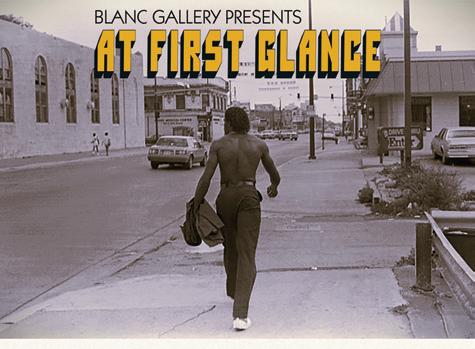
Set against the backdrop of the early 1980s, when Harold Washington served as the city’s mayor and the country was coming to grips with the AIDS epidemic, “At First Glance” introduces us to a cast of characters, including street hustlers, businessmen, and lone wanderers asleep on park benches. Despite their differences on the surface, they are united by how they individually navigate the beautiful complexities of being a Black man in America.
Equipped with a 35mm camera and a mission to photograph anybody who asked, McCoy captured a wide variety of Chicagoans on his frequent bike rides between the city’s South Side and downtown. The profundity and power of the resulting images don’t come from intentional attempts at political strategy or grand gestures of cen-
Paid Sponsored Content






























tralizing systemic oppression. Instead, their potency comes from their authentic simplicity and candor as they delicately explorate the liminal space between erotic and mundane.



McCoy’s photos never tell us what to see. Rather, they invite us to question how we see our brothers, fathers, lovers, comrades, and sons. As such, he expanded upon the legacies of James Van Der Zee and Roy DeCarava, whose images of Harlem challenged preconceived notions of being Black in segregated America, and Gordon Parks, who cataloged the daily lives of Black Americans during the Civil Rights Era.
Today, McCoy’s archive is recognized as a part of a photographic tradition in contemporary art that celebrates Black men beyond pure documentation or tedious cliché. A retired environmental scientist who served in the U.S. Environmental Protection Agency’s (USEPA) regional office in Chicago, McCoy never pursued photography on a professional level, but his undeniable technique, framing, and poetic vision has captivated the arts world. Over the years, his images have appeared in exhibitions with acclaimed photographers, including Chicago’s Derrick Woods-Morrow.
Building on two previous exhibitions of McCoy’s work at Wrightwood 659 and Hyde Park Historical Society, “At First Glance” will include large-scale photo prints on a variety of materials, including muslin and aluminum. The exhibit will also feature a short film made by Jalen Hamilton and a selection of pieces from McCoy’s extensive art collection, which spans more than 50 years of work—predominantly by Black artists from Chicago.
With a closing date of November 25, “At First Glance” is Blanc’s









final exhibition of 2023. The show is a wonderful opportunity to pay homage to a local artist whose practice and perspective open up a series of portals into a wider context of Chicago. “At First Glance” is a memorial to the many forgotten Black men who died during the height of the AIDS epidemic, as well as a celebration of the sights, sounds and feeling of the era and the people who colored it with their rich complexity.
“At First Glance” runs at Blanc Gallery (4445 S. Martin Luther King Dr.) from October 14 through November 25. For more information, visit blancchicago.com.
OCTOBER 5, 2023 - CHICAGO READER 3
This content sponsored by Blanc Gallery
Community Letters m
Re: “Lose your car, but keep the debt,” in the September 7, 2023 issue (Vol. 52, No. 24)

We had a car STOLEN from the City for being parked “too long,” even though it was moved and had a note on it. They towed it anyway. —Steve Tobin, via Facebook
Re: “Brandon Johnson’s first hundred days as Chicago mayor,” in the August 24, 2023 issue (Vol. 52, No. 23)
Lori Lightfoot would have paid to get such a fluff piece from you guys. How about a side-by-side bullet list comparing the two? —Jerry Caldwell, via Facebook
Re: a #ReaderRewind social media post featuring the August 2012 article “Chicken of the trees,” about squirrel as a food source, written by Mike Sula
This was one of the most disturbing articles I have read. I hate it, feel disgusted.
—Donna Pajerski, via Facebook
The Reader responds

Thanks for giving it a try, Donna! Thankfully the James Beard Foundation disagreed when it awarded Mike Sula the 2013 M.F.K. Fisher Distinguished Writing Award for this article. —Salem Collo-Julin
Find us on socials: facebook.com/chicagoreader twitter.com/Chicago_Reader instagram.com/chicago_reader linkedin.com search chicago-reader
The Chicago Reader accepts comments and letters to the editor of less than 400 words for publication consideration.
m letters@chicagoreader.com
EDITOR’S NOTE
While we were putting this issue together, the Reader celebrated what we would consider our 52nd birthday.
On October 1, 1971, the brand-new newspaper Chicago Reader was available to the public. That first issue raises a lot of questions if one were to read it with jaded, 50-plus years later standards. It’s only 16 pages long, including the front and back covers. There’s inexplicable space and twoinch margins on some pages, making it look less “art-directed” and more “Hey, this looks cool right here.”
You have to wait until page seven before you can learn who’s responsible for this thing you’re reading. There’s a small masthead, in the middle of the page, that includes the names of only five people. The then-publisher, Robert Roth, is listed with his telephone number. No area code necessary—it’s 1971, and Chicago was barely out of the lettering prefix on one’s phone number phase.
And then a second paragraph: “Editor: Bob McCamant. Managing editor: Nancy Banks. Advertising manager: Anne Schultz. Circulation director: Tom Rehwaldt.”
As I sit here wrestling with layout, proofreading, and heading to deadline with the issue you’re currently reading, I wonder how much higher my blood pressure medication dosage might be if we only had five people on sta .



That early group (more than five when you include friends and volunteers, as people told us when we revisited those years with Reader alumni for our 50th anniversary issues in 2021) made a solid 16 pages. A two-part cover: on the top, a photo placeholder for a great photo essay about Maxwell Street that you’ll find on page eight. The bottom of the cover is the beginning of an insane but well-reported story about dealing with crank calls. You can’t get more Chicago in the early 70s than that combination, in my opinion.
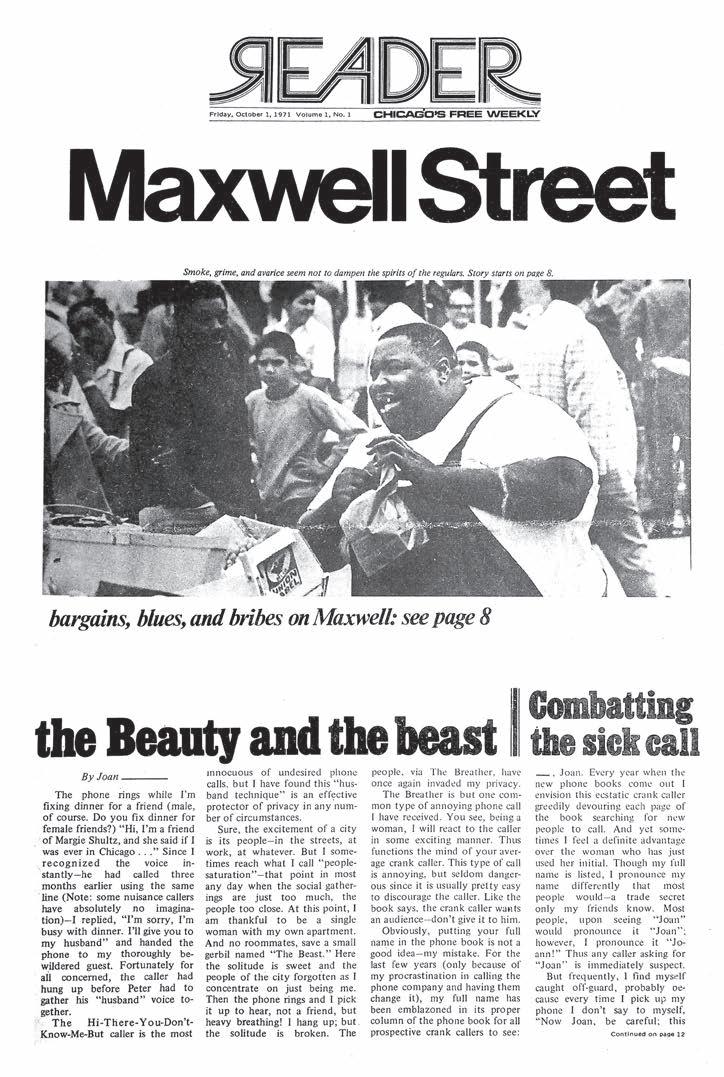
I often tell people that I’m pretty sure that
the founders of the Reader didn’t know that a Reader sta like the sta we have in 2023 was possible in 1971. But how great that they decided that something was important enough out of the ideas that they were sharing with each other to pass along to the rest of our city. And the legacy of that first issue is one of the things that guides me in my job here, as we
build the legacy of the 21st century version of the Reader.
This issue includes the return of our Letters column, both in print and online. How are we doing? Let us know. v
—Salem Collo-Julin, editor in chief m scollojulin@chicagoreader.com
4 CHICAGO READER - OCTOBER 5, 2023 ll
The fi rst issue of the Chicago Reader CHICAGO READER ARCHIVES





OCTOBER 5, 2023 - CHICAGO READER 5 PLAY Game odds available at Illinoislottery.com © Konami Digital Entertainment
CITY LIFE
The To-Do
Upcoming events and ongoing activities you should know about
By MICCO CAPORALE
Uhhh . . . how is it October already? I swear it was just July. Starting the month with 80-degree days has me thinking, “Wow, what can’t this month do?”
Well, if you’re looking to make it a Boptober, might I suggest checking out Viva Acid , which runs October 5-9. Now in its third year, the festival provides workshops, panel discussions, and listening events that celebrate the culture, craft, and history of acid house.
Viva Acid is spread across several local shops and venues, including Gramaphone Records , Smart Bar, and Q Studios, and most of the activities are free. In addition to some killer listening opportunities, like a night with rave legends Woody McBride, Mike Dearborn, and Hyperactive, standout learning opportunities include a history of urban development and acid house, and discussions of the idea of “safer spaces” and cultivating them and dance music in a post-pandemic world. Oh, and there’s an exhibition of old house flyers, too! vivaacid.com
Looking to make it a Rocktober? Our music section has no shortage of suggestions, but personally, I’m looking forward to seeing Tennessee- based party-punk weirdos Snõõper at Empty Bottle (1035 N. Western) on Sunday, October 8. Snõõper are known for lo-fi aes thetics and playful stage shows featuring things like animation, puppetry, and oversize paper-mache props.
It’s made them stalwarts of the fabled “egg punk” aesthetic—a term coined by terminally online idiots like myself to chart newer bands who continue an artier, o eat tradition associated with bands like the Flying Lizards and Devo.

In many ways, Snõõper are to Nashville what the band Clickbait are to Chicago. Opening for them is a delicious who’s who of exuberant midwestern punks: Citric Dummies, Cruelster, and
Consensus Madness. Show kicks o at 9 PM and is open to those 21 and older. Tickets are $15. emptybottle.com
Want a Frocktober? Pick up new threads and more at the Garfield Park Neighborhood Market on Saturday, October 14, as well as Saturday, October 28. Both days, it’s happening in the Hatchery plaza (135 N. Kedzie) and features a host of local vendors. While most of it centers on food like fresh meat and produce from local farmers, every market day offers surprising delights from Chicago-based makers including altered, upcycled clothing that will leave you feeling fancy fresh. If you’re just grocery shopping, note that LINK cards are accepted, and the market offers up to $25 in LINK matching—for every LINK dollar you spend up to $25, you will receive LINK Match vouchers to spend on fruits and vegetables. It’s open 10 AM-2 PM, and these are the last two of the season, so don’t sleep on this!
instagram.com/gpccouncil
Trying to make it a Schlocktober? There’s no shortage of campy Halloween festivities, but right now my sights are set on the Elsewhere Bazaar, a self-described “psychic faire and mystical market” at Whim! (1225 W. Belmont) on October 15. Come for palm readings, tarot decks, and spooky, spunky wares; stay for a witchy cocktail menu and a talk from occult magician (and the event’s organizer) J.A. Doyle as well as some live entertainment in one of the most photogenic places in the city right now to catch neon-painted murals illuminated by black light. Cauldrons start brewing at 11 AM and bubble all day. Tickets are $13 ($7 in advance) and available to those 21 and older. search Elsewhere Bazaar at eventbrite.com
What about a Cocktober? That same night, Take One is showing at Music Box at 9:30 PM. Take One is a gay docu-porn made by di-
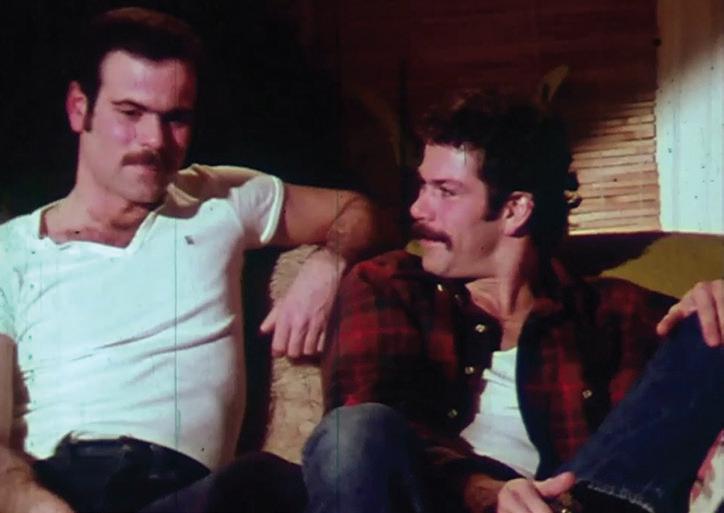
rector Wakefield Poole of Boys in the Sand fame. Poole’s background as a choreographer a orded him an artful eye that helped legitimize erotic movies as a serious point of artful consideration. While Poole died in relative obscurity, his creative pursuits coupled with his connection to the post-Stonewall gay underground in New York helped the mainstream arrival of 70s porno chic, as well as establishing adult entertainment as an aboveground
revenue stream. In this film, different men confess their fantasies, then live them out in various beautiful, surreal, complex ways. If you miss this screening, don’t worry—there’s another chance to catch the flick on Sunday, November 5. Tickets are $14 and available to those 18 and older.
musicboxtheatre.com v m mcaporale@chicagoreader.com
6 CHICAGO READER - OCTOBER 5, 2023 ll
calendar
Snõõper are coming to Chicago to change hearts and minds on October 8. DOUGAL GORMAN
A still from the documentary Take One COURTESY THE ARTIST

OCTOBER 5, 2023 - CHICAGO READER 7
CITY LIFE
MENTIONED
Imagine Englewood if: imagineenglewoodif.org
Syd Brisco: instagram.com/syd.brisco
Savant & Scholar: savantandscholar.boutique
Street View
Open book
For this youth mentor, clothes need to tell a story.
By ISA GIALLORENZO
“Idefinitely try to mix in traditional Indigenous types of clothing—whether it’s African, Indian, [etc.]—with modern streetwear,” says Boukhepra Heqitef, 30. When he was photographed on his way to meeting a friend in Hyde Park, Heqitef was wearing an African mudcloth dashiki top and many other statement items that spoke to his personal history.

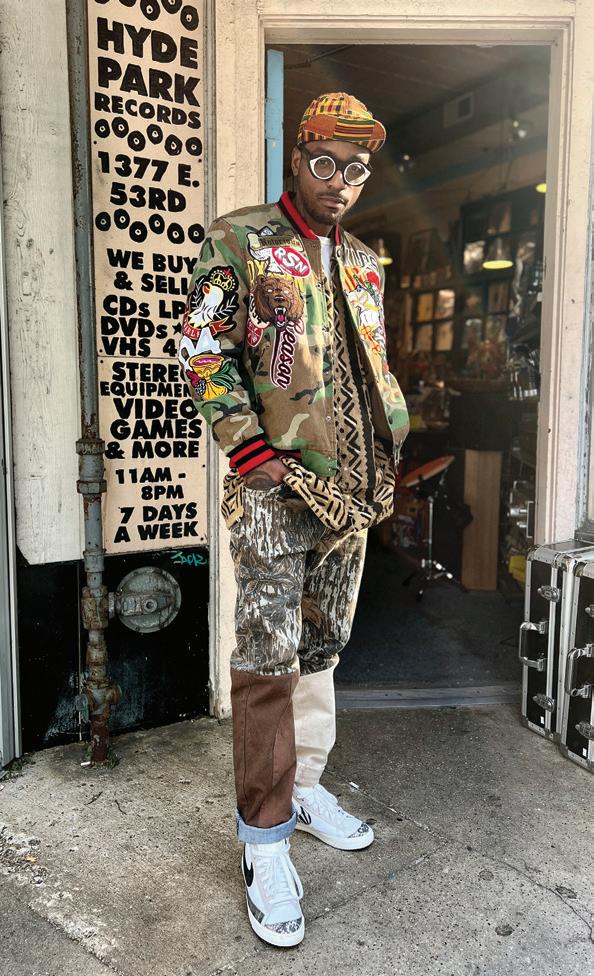
“My look today was put together very quickly this morning, but I’m wearing a jacket that was gifted to me from a friend that I saw wearing the jacket. And I was like, ‘I like [that] jacket. You should give it to me.’ And they were like, ‘Here.’ So I have the jacket now,” he explains.
“These pants were actually made by a friend of mine, Syd Brisco. She takes denims [apart], then puts them together, and repurposes them. She makes really dope stuff,” Heqitef says about the Chicago-based multidisciplinary artist and designer.

Jamel Marshall, another one of Heqitef’s chums, was responsible for the striking eyeglasses that Heqitef was wearing. The glasses were made by the brand Marshall founded, Savant & Scholar.
“I used to run into Jamel coming from downtown some years ago. He [would sometimes] show me sketches of glasses that he was going to make,” Heqitef says. “Then every time I would see him after that, he had made some sort of progress [until] I ordered the prototypes.”
After a few tweaks here and there, Heqitef got his special frames. “I try to wear [Marshall’s] stu because I know him, and I saw where he began before he blew up. And he inspired me to want to enter into the eyewear space as well,” Heqitef adds.
Though they also have a customized look, Heqitef’s Nike Blazers came as is. “When I saw them, I just had to get them. I thought they seemed made just for me,” he remembers.
A program coordinator at Imagine En-
glewood if (IEi) Heqitef is also one of the organization’s youth mentors. According to its website, “Imagine Englewood if is the longest-serving nonprofit in Englewood dedicated to creating safe and empowering spaces for youth in the Greater Englewood community. IEi strengthens the Greater Englewood community by teaching local youth and their families positive communication skills, healthy living, and environmental awareness.”
Clearly, Heqitef’s outfit represents many of those tenets. “I just gave you my story. A lot of the stuff that I wear has a story behind it,” he says. “Something like the jacket I got from someone or the pants that my friend made or the glasses that I have—it’s not just about how things look to me, it’s about what it means to me when I wear it.” v
m letters@chicagoreader.com
8 CHICAGO READER - OCTOBER 5, 2023 ll
Links to Heqitef’s art and music can be found at instagram.com/boukhepra ISA GIALLORENZO
The Bitch Speaks of Crazy
the graceful riots crown themselves crazy!
a halo of glocks, the weapons form ready to buck, & i’m stocked up too. some blessings can’t be seen through kerosene wings. how they roll to a height my sister in chaos can’t control.
her head there—where her roots should be.


boss lady, look how she ferries the wild weight. eyes haunting, neck gold-framed as if to say, you calling me crazy? i make more sense than your whole life savings & your mama’s baby. said i’d straight die for this power:


thigh-high, heel-click, fierce living.
this trigger, how it flowers & leaves her eyes open making wine of a brain. no one will visit this installation of genius & girl, sprawled rose of a life wet on concrete. shattered seed of me/of she—this theft is not our weakness.
By Arianne Elena Payne
even in death she won’t retreat, fires in every form. machine, statue, ocean— her blood: a lantern & everything disturbs air for a glimmer. quiet as it’s kept, spirits long for this life of exclamation marks. ugly as it gets, we make stars out of crabs & burn the bucket.
could give a fuck if you don’t know





what this batshit means. i get to name me, a heavy blessing. the chatter signals no vanity will save us. you say insanity & my bed is made a Black comfort. give me a swamp, i’ll plant fantasy: sweep the ground with my tail, season salt water for fun, make bitches with the sirens & we’ll never have to run.
Arianne Elena Payne is a Black writer, multidisciplinary creative, and aspiring historian from Chicago, Illinois. She is a 2023 PEN America Emerging Voices Fellow who has received the 2022 GraybealGowen Poetry Prize, the 2022 Virginia Downs Poetry Award, and the 2019 Frederick Hartmann Poetry Prize. Her work has been featured in Voicemail Poems, TORCH, Shenandoah, and Hooligan Magazine. Situated in the complexities and lyricism of Blackness, girlhood, and geographies of resistance—her work strives to take Black people and their histories seriously.
Poem curated by Cortney Lamar Charleston. Cortney Lamar Charleston, originally from the Chicago suburbs, is a Cave Canem fellow and the author of Telepathologies (Saturnalia Books, 2017) and Doppelgangbanger (Haymarket Books, 2021). He serves as a poetry editor at The Rumpus and on the editorial board at Alice James Books.

A biweekly series curated by the Chicago Reader and sponsored by the Poetry Foundation.
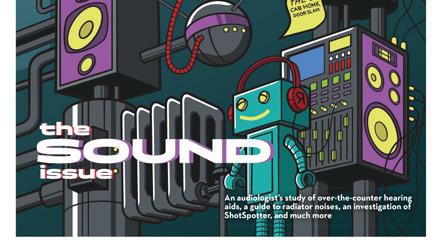
































Hours



Wednesday & Friday: 11:00 AM–5:00 PM

Thursday: 11:00 AM–7:00 PM

Saturday: 10:00 AM–5:00 PM
Open Door: Chris Aldana + Czaerra Galicinao Ucol, Dior J. Stephens + jason b. Crawford



Thursday, October 12 7pm CT







The Open Door series highlights creative relationships and collaborations in the Midwest, inviting two featured pairs to share work that opens up poetry as a porous category.
Learn more at PoetryFoundation.org
OCTOBER 5, 2023 - CHICAGO READER 9
ReplaceRetirementRisk,Fees,&Losses CREATEYOUROWNBANK™ 30S.WackerDr.,Suite1260,Chicago,IL60606 ERICK.WILLIAMS GET EDUCATED EMPOWERED&EQUIPPED TOWIN! TOPOFTHETABLE 312.724.7755 www.ERI.global •EarnUninterruptedCompoundInterestandDividends! •EliminateAllDebt,in9YearsorLessIncluding Mortgage(s)andStudentLoan(s)! •EnjoyTax-FavoredGrowthandDistributionofMoney! •AccesstoCashValuePriortoAge59-1/2, WithoutPenalty! •ReducetheAmountofInterestYouPay! •RepositionYourTax-Deferredand TaxableAssetstoTax-Free! •Self-FinancePurchases! Providing arts coverage in Chicago since 1971. chicagoreader.com
After Doechii SavingWithGuarantees
FOOD & DRINK
rants in terms of food and kitchen culture, but it was the latter, he says, that impacted his development the most.
“Thinking outside of the box and never putting limitations on anything was really the ethos,” he says. “Like, you can do anything if you think about it long enough. Trying things out, eventually, you can make it work. I felt like nobody was thinking about food like that, at that time.”
Equally formative, but perhaps less tangible, were the lessons he absorbed as a tyke, running around his grandmothers’ kitchens banging on pots and pans as his aunts rolled grape leaves or kibbeh; or curdled and strained yogurt for the cheese known as shanklish, pickled in olive oil and vinegar.
POP-UP PREVIEW
Laimoon normalizes wood-fired pita at the next Monday Night Foodball

Check out Brandon Dumot’s extraordinary Middle Eastern menu at the Reader’s weekly chef pop-up at Ludlow Liquors.
By MIKE SULA
Brandon Dumot tra cs in soft, warm five-inch saucers of astonishment, pillows of char-stippled pita bread that gently exhale steamy gusts when he pulls them from the fire. They taste like they’re alive.
Most of us are so accustomed to plasticshrouded factory flatbread—dead bread—that when you first encounter a fresh one, licked by live fire and kissed by smoke, it can feel like time stops and nothing exists but your own pleasure.
“Whenever you get one that’s exceptional, it’s a little bit shocking,” says Dumot.
You could say the same thing about his silky hummus, or his creamy white labneh with the density of ice cream and a sharp tang softened by a dusting of nutty, herbaceous za’atar.

Dumot began developing this particular set of skills in Lincoln Park when he was the opening sous chef at Galit, Zach Engel’s extraordinary modern Israeli restaurant, where the wood-burning oven is the heart of the open kitchen.

But that was only the last great restaurant he worked for before striking out on his own this summer under the name Laimoon, a virtual Middle Eastern restaurant and pop-up for which he draws from his childhood and nearly two decades grinding in some of the city’s most challenging kitchens. Since arriving in Chicago after graduating from the Culinary Institute of America, he’s worked for Andrew Zimmerman at Sepia, Thomas Lents at Sixteen, and Michael Carlson at Schwa, to name a few. These were all radically di erent restau-
That was just north of Pittsburgh where his grandparents’ Syrian Orthodox church published cookbooks from its members’ home recipes. Something rubbed off on him. He lost interest in business school after he took a job to pay his way at an Italian restaurant where the chef and owner religiously stuck to scratch cooking—so much that by the time they pushed him toward culinary school, he was well beyond the skill level of most of his classmates.
When he landed at Galit, it seemed the job was tailored specifically for him. “I was working in all these fine-dining restaurants and learning a ton and really getting all the fundamentals. But there wasn’t anywhere that I thought was doing elevated Middle Eastern food in the city. It just seemed like the perfect opportunity for me to combine family background and my work background.”
The first year was intense and exhilarating— both familiar and foreign. He recalls catching the comforting scent of the warm spice blend baharat, while confronting new territory like the labor-intensive, laminated Jewish Yemeni bread kubaneh. But during the pandemic, the shift to to-go orders and outdoor dining eliminated the guest interaction that fueled him. “I couldn’t just put food in cardboard boxes any longer. It wasn’t really making me happy.”
He found work for a while for a corporate hospitality consulting company, but before long he started thinking about cooking the food he wanted for himself for others. “After
10 CHICAGO READER - OCTOBER 5, 2023 ll
SANDY NOTO FOR CHICAGO READER
Brandon Dumot constantly tweaks his woodfi red pita recipe to pair perfectly with his silky hummus and labneh.
Find more one-of-a-kind Chicago food and drink content at chicagoreader.com/food.
LAIMOON AT MONDAY NIGHT FOODBALL
Mon 10/9 at 5 PM




Ludlow Liquors, 2959 N. California ludlow-liquors.com
FOOD & DRINK
having eaten fresh-baked pita bread every day for two years, you miss it. You get addicted to having that fresh hummus and fresh pita every day. That’s my soul. People started asking me to make them stu .”
He started experimenting with his own pita recipe in his home convection oven, but after cooking with fire, it wasn’t the same. He tried to order an Ooni portable wood-burning oven—which became the standard for pandemic home pizza makers, so much so that it was sold out for a year. Then supply chain issues slowed it down further—his first model was marooned on the container ship Ever Given in the Suez Canal for months before the manufacturer canceled the order.
When an oven finally arrived after a twoyear wait, he began tweaking, something he still does each week. He uses a blend of Janie’s Mill Turkey Red wheat and all-purpose flour, along with a bit of King Arthur bread flour, the combination yielding “a higher protein content,” he says, that “allows for longer fermentation time (two to three days) and more flavor development without compromising the structure.” They’re incredibly soft on the inside and slow to go stale—even though he won’t sell any of them past the day they’re baked.
Laimoon is Arabic for “lemon,” an acid Dumot relies upon in its many forms: zested, juiced, and preserved. He’s dialed in mezze too, like the hummus; the labneh; marinated feta; smoky baba ghanoush; and smoked carrot and red pepper muhammara; along with larger plates like chicken shawarma and merguez-spiced lamb kebabs. In June he appeared at his first pop-up at Kimski, his girlfriend and
partner Jasmin Spilotro running the front of the house while he tended to the Ooni.
For now, there’s catering, packaged preorders, and more pop-ups—frequently on the patio at Easy Does It in Logan Square where he debuted his serrano and cilantromarinated olives, which he tumbles over the fire in a cylindrical grilling basket. They’re a showstopper.
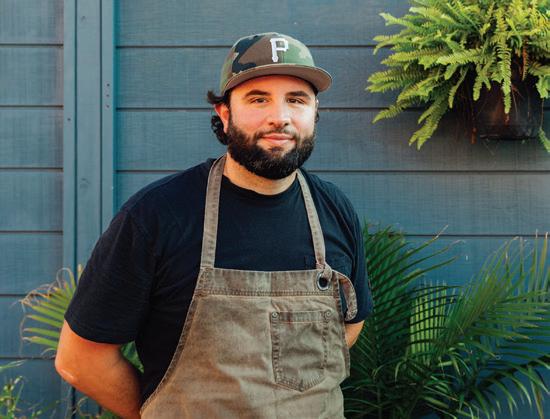
He’s hoping to package and place his mezze in wine bars around the city. And he’s definitely thinking brick-and-mortar down the road—maybe a falafel and shawarma shop, or who knows? “I’ll probably want to cook crazy tasting menus again at some point.”





That’s not before this Monday, October 9, when Dumot and Spilotro are introducing a brand-new fall menu at Monday Night Foodball, the Reader’s weekly chef pop-up at Ludlow Liquors, 2959 N. California in Avondale. They’ll be taking orders beginning at 5 PM until they sell out for endive salad with grapes and hazelnut dukkah; grilled mushrooms with hummus and Urfa biber chili oil; grilled sweet corn fritters with a Moroccan spice blend; chicken shawarma pita sandwiches; and baharat-spiced carrot cake.
“I want to take my experiences with my family, my childhood, the food that I used to eat, and combine that with everything that I’ve learned throughout my career,” he says. “And do everything the right way: not taking shortcuts. Sourcing the best product I can find, as responsibly as I can. And sharing it, getting to interact with people and seeing them enjoy it.”
OCTOBER 5, 2023 - CHICAGO READER 11
Brandon Dumot SANDY NOTO FOR CHICAGO READER
m msula@chicagoreader.com BUY NOW OR GET THE RED CARD: Under 30? RED = 6 ticket credits for $99. By
Directed by ensemble member AUDREY FRANCIS POTUS OR, BEHIND EVERY GREAT DUMBASS ARE SEVEN WOMEN TRYING TO KEEP HIM ALIVE OCT 26 – DEC 3 Featuring ensemble members Celeste M. Cooper, Sandra Marquez, Caroline Ne and Karen Rodriguez A laugh-out-loud look at the women in charge of the man in charge TICKETS START AT $20 $15 FOR STUDENTS steppenwolf.org 312-335-1650
v
SELINA FILLINGER
NEWS & POLITICS
Lives on the line
OVERDOSES ON PUBLIC TRANSIT
Over the last four years, more than 150 people have died from opioid-related overdoses on the CTA—but CTA officials aren’t keeping track.
By KATIE PROUT
I’ve developed ongoing relationships with sources I consider experts on the subject: people who use drugs and people who are unhoused. Allan, who I’ve known for a year, is both. That morning over co ee, Allan said the man was discovered at the end of the line, though he couldn’t remember whether the stop was Forest Park or O’Hare. The man was Black, he continued, and looked both as though he’d overdosed and like he’d been there “for awhile.”
bikes spray-painted white at fatal intersections. These aren’t just reminders that someone’s life mattered: they also acknowledge that the death, in fact, occurred. Why didn’t I hear about this one?
Like many unhoused Chicagoans, Allan stays on the train when it’s cold. One morning toward the end of last winter, we met up at a McDonald’s. When I asked how his stay on the train had been lately, Allan, a pseudonym, said that two days before, he’d ridden the Blue Line with a dead man. I’ve been reporting on drugs and overdose deaths in Chicago since 2020. Over the years,
This wasn’t the fi rst time I’d heard about an overdose on Chicago Transit Authority (CTA) property: during my reporting, others had told me about witnessing overdose deaths and near deaths on buses and trains. But this one stayed with me, and not just because it took until the end of the line, when CTA workers sweep the train to make sure unhoused riders get off, for a dead person sheltering there to be discovered. It’s because this city is strewn with memorials: plaques to famous men, makeshift memorial piles of stu ed animals and candles for homicide victims, and
In order to address a problem, you have to admit it exists. While the CTA is on the record identifying drug use, and thus, drug users, as a problem of “public safety” on its rails, nowhere publicly have I seen them acknowledge the pattern of overdose deaths occurring on their property. I fi rst reached out to the CTA over email this July, asking them if they tracked opioid overdose-related deaths. I didn’t get an answer to that question until August. The answer was no. But by then, I had already started trying to fi gure out the numbers on my own.
According to data provided by the Cook County Medical Examiner’s O ce (MEO), 158 died from opioid-related overdoses on the CTA between 2018-2022. Breaking it down, there were 23 overdose deaths on the CTA in 2018. That number dropped to 13 deaths in

2019. In 2020, the fi rst year of the pandemic, the number more than doubled, rising to 31. In 2021, that number stayed the same: 31 deaths. But in 2022, 60 people died from overdoses on a CTA train, in a train station, or (in four cases) on a bus, doubling from the previous year. In total, from 2018 to 2022, the number of people overdosing on CTA property more than doubled, mirroring the increase in Cook County overdose deaths that almost doubled during that same period of time.
At least 28 people died opioid overdose-related deaths on CTA property between January 1 and July 31 of this year. I say at least because of the time it can take to run toxicology reports: MEO didn’t release the fi nal tally of opioid-related overdose deaths in Cook County for 2022 until July 2023.
Let’s look again at 2022, the year 60 people su ered opioid overdose-related deaths on the CTA, or a little more than one person every six days. The CTA has publicly stated that they receive all of their crime information from the Chicago Police Department
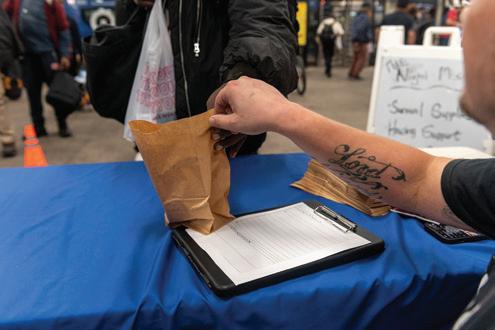
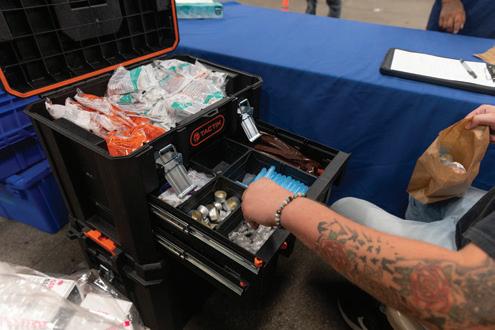
12 CHICAGO READER - OCTOBER 5, 2023 ll
Two evenings a week, outreach workers from the Night Ministry distribute Narcan and other harm reduction supplies on CTA property. GONZALO GUZMAN FOR CHICAGO READER
HERE IS HOW I CAME TO 158 DEATHS:
• I chose to focus on 2018-2022, a time range that encompassed the pre-, mid-, and “post”-pandemic Chicago Transit Authority (CTA). It also encompasses most of former Mayor Lori Lightfoot’s time in office, and gives me something to measure Mayor Brandon Johnson’s administration against, when the time comes.
• Data obtained through public records and Freedom of Information Act requests were fact-checked by the Reader and the Cook County Medical Examiner’s Office (MEO). Much of it was not standardized—a case might list every detail down to the train car number, or a generalized location like “Clark and Lake CTA station,” which serves multiple train lines—or simply unverifiable. The data provided by the MEO comes from the Chicago Police Department and the Office of Emergency Management & Communications.
• The final number refers to CTA trains, train stations, and four bus deaths only; it excludes any cases that occurred at or near Metra stations, Greyhound stops, and the Union Station complex downtown. That doesn’t mean they didn’t occur on the CTA, since some of these locations were near CTA bus routes, only that, given the limited data tracked, we weren’t able to confirm it.
• An additional 91 people appear to have died on a CTA bus route or at a bus stop. Because bus stops are cared for by the Chicago Department of Transportation, I excluded bus data unless notes said an overdose specifically happened on a bus.
ACRONYM KEY:
In order of mention:
CTA: Chicago Transit Authority
MEO: Medical Examiner’s Office
CPD: Chicago Police Department
FOIA: Freedom of Information Act
CRA: Chicago Recovery Alliance
CDPH: Chicago Department of Public Health
OEMC: Office of Emergency Management and Communications
CPL: Chicago Public Library
WSHOTF: West Side Heroin/Opioid Task Force
(CPD). According to CPD’s public-facing data portal, four homicides occurred on CTA trains in 2022. (An additional four are listed as “CTA property” and one is “CTA bus.”) From the data I received from the MEO via a Freedom of Information Act (FOIA) request, I determined five people died from homicide on the CTA trains or train stations. I sent an email to CPD, requesting help understanding the discrepancy, but never heard back. Sticking with CPD’s four train homicides, in 2022, it was 15 times more likely that someone would die on a CTA train from an overdose than from homicide.
In recent years, the CTA has come under intense public and political pressure to respond to an increase in violent crimes (generally tracked as aggravated assault, aggravated battery, criminal sexual assault, robbery, and homicide) on their property: crime, it’s fair to note, that is neither unique nor isolated to the CTA. And the CTA has taken action to address these concerns. There are now more than 33,000 security cameras on CTA property and dozens of K-9 units (unarmed private security guards with dogs) throughout the transit system. In 2022, the CTA spent almost $24 million for private security services. Through CPD’s Voluntary Special Employment Program, o -duty o cers get paid overtime to patrol CTA (the CTA then reimburses the City). The special revenue Chicago Police Detail Fund allocates $30 million to pay these CPD o cers over the course of a three-year agreement that ends in 2025. In August 2023, the CTA released a statement announcing that rates of violent crime “continue a downward trend” when compared to both August 2022 and earlier this year. But correlation doesn’t necessarily mean causation. “Police omnipresence is not the most e ective way to reduce violent crime nor does it address housing instability or substance use,” wrote Sam McCann and Aaron Stagoff-Belfort in Vera, citing a 2021 Slate report analyzing 29 years of police spending in hundreds of cities. Time will tell if this is a result of CTA e orts with CPD, CTA e orts with the social service organizations they partner with, or something else. Meanwhile on the CTA, preventable overdose deaths continue.
When you overdose on opioids, your breathing slows. So does your heartbeat. You’re no longer responsive to anyone’s attempts to wake you, and you can no longer speak. Your fingernails or lips might turn blue or purple, your skin pale
and/or clammy, your body limp. Without swift care, your breath and heartbeat could stop, and you could die.
An opioid overdose is a medical emergency, not a violent crime. It understandably requires a different approach—not more security cameras and more arrests, and not more dogs or more police. An overdose is also a matter of public safety, for both passengers using drugs and passengers who are not, says Jen Andel, overdose prevention specialist at the Chicago Recovery Alliance (CRA).
“We have a lot of people who experience an overdose and the cops end up coming—this is why a lot of people won’t call when they experience an overdose,” Andel told me in March. “It’s frustrating, because multiple entities in the Chicago area, in Cook County, have identified the CTA as a place where this need exists for overdose prevention and overdose training.” But, she continued, “There seems to be a focus on, ‘Let’s get the homeless and these people o of our trains. There’s syringe litter, and there’s this and that—’ well, you can easily fi x that problem. Make Narcan [the opioid-overdose reversal medication, generically called naloxone] available on your platforms. Put sharps containers out. Simple things like that.”
In “Meeting the Moment,” CTA President Dorval Carter Jr.’s 2022 plan to reinvigorate the CTA, the words “opioid,” “overdose,” “Narcan,” and “death” do not appear. “Narcotic” does, as in “CPD has assigned narcotic and gang personnel to increase patrols and active investigations at CTA rail stations.” “Drug use” and “drug abuse” do as well, under issues of safety and security, and in several mentions of expanding partnerships with social service organizations. In a 2023 press release titled “CTA Highlights Progress One Year After ‘Meeting the Moment’ Plan Launched,” there is one mention of substance use, highlighting the CTA’s up to $2 million dollar investment to expand outreach e orts by organizations focused on “those seeking shelter on the system and/or struggling with mental health or substance abuse.”
According to CTA spokesperson Kathleen Woodruff, CTA workers are advised to “notify emergency responders immediately, so that those trained emergency-response professionals can respond quickly,” whenever a rider appears to be experiencing a health crisis.
It took a while to get that quote from Woodru . I fi rst contacted the CTA for this story in July 2023, asking the following questions
OCTOBER 5, 2023 - CHICAGO READER 13 NEWS & POLITICS
IT’S LIKELY THAT 158 IS AN APPROXIMATE, POTENTIALLY CONSERVATIVE ESTIMATE. BUT IT’S A PLACE TO START.
NEWS & POLITICS
continued from p. 13
(edited for brevity):
• Do CTA workers receive any general fi rst aid training or training on how to recognize signs of an opioid overdose, and why or why not?
• Do CTA workers receive training on how to administer naloxone/Narcan? Are any CTA workers provided with naloxone/Narcan to carry while on the clock?
• The same questions go for CTA-a liated private security guards. If I need to ask their management directly, I’d be grateful if you could provide me with a contact or introduction.
• I know the Chicago Department of Public Health (CDPH) will be installing a Narcan vending machine at the 95th platform sometime soon. When it’s installed, will CTA and/or private security workers at that station be trained on how to recognize signs of an opioid overdose, and how to use Narcan?
• Does the CTA track when and where overdoses occur on its trains, buses, platforms, and stations, or work with another department (O ce of Emergency Management and Communications [OEMC], Chicago Fire Department) to do so?
Ten days after I sent my questions in July, I received a response from Woodruff in the last business hour of the fi nal day of my deadline window. “The CTA is pleased to partner with the City and CDPH to accommodate this machine at the 95th Red Line Station, and we continue to have active conversations regarding the future of this program on CTA. CDPH is the lead on the health products vending machines. Please contact CDPH for additional information about this project.”
On March 3 of this year, CDPH announced a plan to install five vending machines throughout the city, including one at the 95th Red Line station. There have been delays: originally the vending machines, which will be maintained by CDPH, were anticipated to go up by the end of summer. It’s October now, but it seems like they’re close: “We are excited to see the machines go live later this month,” CDPH spokesperson Anna Dolezal emailed me on October 3.
CDPH didn’t have information for me on whether employees at the CTA are or are not trained on overdose recognition and prevention or whether they carry Narcan. The same went for private security guards employed by the CTA. When I asked whether CTA sta
or private security guards who work at 95th would be trained on how to use the Narcan at their station, CDPH directed me back to CTA.
Several emails, several phone calls, and one month later, I received answers to my questions, shared over two emails from Woodru . CTA workers do not receive Narcan training, nor do they carry Narcan. Private security guards do not receive “medical response training,” nor do they carry Narcan.
“Workers from Haymarket, one of the social service agencies CTA has contracted with to provide outreach and support to the unhoused/homeless, DO carry Narcan,” Woodruff explained. As for the vending machine at 95th, “CTA workers will be informed of the location of the Narcan vending machine and its basic functionality,” Woodru wrote.
“The primary purpose of the health products vending machines is to make them available to persons in need. As CTA employees and security guards currently do, they will notify emergency responders of any situation involving sick or unresponsive customers.”
As a public safety tool, sharps containers protect everyone, and Narcan—like an EpiPen or AED defibrillator—can rapidly save a life. “The CTA has a few AEDs in employee/ non-public facing facilities. First aid kits are available at some stations,” said a CTA spokesperson over email in September. But adding overdose prevention tools requires considering overdose deaths as both a medical emergency and a matter of public safety, as worthy of funding and thought as any other crisis that dominates public discourse around the CTA. It’s true that the 60 opioid overdose-related deaths on the CTA in 2022 are only 3 percent of the total opioid overdose deaths in 2022 in Cook County. What makes them stand out is their public nature: These people didn’t die in isolation, but on public property, in highly tra cked public spaces. These deaths are technically visible, but culturally overlooked.
To reduce overdose deaths on the CTA, “train your operators on how to recognize and reverse an overdose,” said Andel. “Keep naloxone on your trains.” Her training, which includes tips on recognizing overdose signs (slow or shallow breathing, pinpoint pupils, an inability to speak or be roused), also teaches participants to, essentially, think beyond white people. “Common literature says a person’s gonna turn blue,” she explained to me. “Well, in a person of color, they might appear grayish or ashen. I make sure people are aware of that.” She mentioned that CDPH has
posted signs educating the public about opioid overdose on CTA property before—why not, she asked, add instructions on where to locate naloxone on the train and how to use it, too?
As with location, the specificity of data I received regarding cause of death varied. Some listed detailed breakdowns of the multiple drugs contributing to an overdose, while others merely listed “opioid(s) toxicity.” Of the 158 deaths on the CTA from 2018-2022, at least 142 involved fentanyl.
Much has been written and said about fentanyl since the rise of synthetic opioid overdose deaths began in 2013. Given that not all of it’s true, it’s worth it to briefl y go over what fentanyl is and isn’t. Fentanyl is a synthetic opioid, meaning it’s produced in a lab, rather than distilled from the harvest of opium poppies, the way heroin and morphine are. Fentanyl has been available via prescription since the 1960s. It’s manufactured legally, through pharmaceutical companies, and illegally, through illicit drug suppliers. Both favor it because it’s cheap to produce, and because its strength allows it to stretch much further—but that strength can, of course, be deadly.

Part of the drug’s toxicity comes from its increasing ubiquity. It’s unlikely that drugmakers are deliberately trying to kill people: they want returning clients, not a line of bodies that leads police to their metaphorical or literal door. But, because it’s both powerful and inexpensive, fentanyl gets added to counterfeit pills that aren’t being marketed as opioids but share some similar tranquilizing e ects—think ketamine or Xanax.
Fentanyl can be lethal, but only for those who inject it, ingest, or snort it. Overdose via fentanyl patch does occur, but is more rare, because it takes hours of contact for the drug to absorb into your skin. If you’re afraid to check on someone who has potentially overdosed because you’re afraid of touching fentanyl, don’t let those viral cop “fentanyl exposure” videos fool you. “The scientific literature shows, definitively, that brief contact with fentanyl is not sufficient for it to enter the bloodstream and cross the
blood-brain barrier to cause [. . .] overdose,” wrote Zachary Siegel for New York Times Magazine in 2022. A month before Siegel’s story, a clinical toxicologist copublished a case study “about the time he accidentally spilled a mammoth dose of pure liquid fentanyl all over himself at work; he simply washed it o , with no adverse e ects.”
If you live in Illinois, you are a orded multiple legal protections when responding to a potential opioid overdose. For example, the Illinois Drug Overdose Prevention Program Law “empowers non-medical professionals, including family, friends, and other community members, to administer naloxone to prevent a fatal opioid overdose without risking any civil or criminal liability,” according to information posted by the Illinois Department of Public Health. According to the same page, under the “Good Samaritan Law” (o cially the Emergency Medical Services Access Law of 2012) “both the person seeking emergency help and the person who overdoses are protected from being charged/ prosecuted for felony possession of fewer than three grams of heroin, fewer than three grams of morphine, fewer than 40 grams of prescription opioids, and di erent amounts of other drugs.”
And as for naloxone and Narcan? “People will say, ‘Oh, what if I give it and they’re not really overdosing?’ Nothing’s gonna happen to the person.’ Or they’re like, ‘Oh, what if a ten-year-old gets it and takes it?’ Well, nothing’s gonna happen to the ten-year-old either,” said Erik McIntosh, an acute care nurse practitioner at Rush University Medical Center I spoke to this summer. “It’s a really safe medication. And that’s why the FDA is releasing it.” This year, the FDA has approved two naloxone nasal sprays for over the counter use.
14 CHICAGO READER - OCTOBER 5, 2023 ll
Out of the 158 deaths, only five involved one drug (an opioid). The rest were determined to be polydrug overdoses, which can include non-opioids like xylazine, benzodiazepines, or alcohol. Narcan is still effective in polydrug overdoses that involve an opioid and something else. And if you don’t know for sure if someone overdosed or what they took, standard advice is to go ahead and administer it. “If you do give it, no harm, no foul,” said Stephan Koruba, a nurse practitioner and clinical supervisor for the Night Ministry, one of the organizations contracted by the CTA to provide outreach services on some CTA property. “If you don’t, people could die.”
Ninety-three of the 158 people who died on the CTA between 2018-2022 died on the Blue Line, or just under 59 percent. The next most common line was the Green (28), followed by the Red (22). There were three deaths on the Orange Line, one on the Pink, two that were either on the Red Line or the Brown Line (Belmont stop serves both), and five that I couldn’t identify (four at Clark and Lake, and one with no address that just said “found on train” in the note).

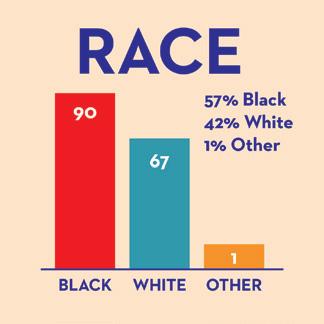



Why the Blue Line? There are a few possibilities. The Forest Park branch travels along the Eisenhower Expressway, nicknamed “Heroin Highway” by law enforcement for the access it provides drivers from the suburbs and elsewhere to drug spots on the city’s west side. The Blue Line itself travels through neighborhoods that see higher overdose-related deaths than many other parts of the city: Austin, West Garfield Park, and East Garfield Park. And while both the Red and Blue Lines run 24 hours, the Blue Line is longer. Not everyone who is unhoused also uses drugs, but many unhoused people stay on the Red and Blue Lines, because of its length and accessibility, when they have nowhere else they feel safe. The CTA knows this: in November 2022, they announced the aforementioned $2 million in funding to the Department of Family and Support Services through December 31, 2023, to expand upon existing social services outreach provided by Thresholds, Haymarket, and the Night Ministry on CTA trains and property.
Two evenings a week, the Night Ministry works on CTA property (Wednesdays at the Red Line stop on Howard, Thursdays at Forest Park on the Blue Line) but not in the trains, “and not on the platforms themselves, if a platform is defined as the area of the
station where passengers immediately enter and exit trains,” explained Burke Patten, the organization’s communications manager. This includes distribution of Narcan. Still, in 2022, outreach workers distributed 2,449 nasal Naloxone kits. So far in 2023, they’ve distributed 1,718 nasal kits and 234 injectable ones. Each kit contains two doses. It’s a remarkable amount, and it shows a remarkable need.
McIntosh, the acute care nurse practitioner I spoke to about Narcan, has worked at Rush since 2005.
“Probably weekly, I’ll have at least one patient I’m treating for either heroin withdrawal or alcohol withdrawal,” McIntosh told me when I called him early on a Friday evening this past July. “Frequently, I discharge my patients with Narcan. We have it delivered from the pharmacy.” What he didn’t realize, before boarding the Blue Line one night after finishing his shift in February 2022, was that through Rush, he could get Narcan for free to carry himself. “That night when I was on the Blue Line, I didn’t have Narcan. I do now.”
One of the pleasures of living in a city and sharing public space is the little connections you make with the people that are not quite strangers, even if you don’t know their names. Consider your fellow riders of the CTA. “Not my neighbors, but my Blue Line neighbors,” McIntosh explained. Since moving to the city, McIntosh has taken the same route on the CTA, to and from work, for 18 years. “I see them as a kind of an extension of my community. You’ll notice like, ‘Oh, hey, the guy that always wears the Texas hat. He’s not here. I wonder where he’s at?’”
One such person was a Hispanic woman in her 40s or 50s. Riding the train that night, he saw her again, but this time, “She was slumped over in her seat,” he told me, “almost falling out.”
“Ma’am, are you OK?” someone asked. Quickly, a crowd of people gathered around her on the moving train, wanting to help. McIntosh began a medical assessment. He felt for her pulse—it was still there, flickering. He rubbed her sternum with his knuckles, recommended when responding to a possible overdose, because if that uncomfortable sensation gets a reaction, then it’s not an emergency. She didn’t respond. Somebody threw him a Snickers bar, in case she was diabetic, but, lifting her eyelids, McIntosh could see her pinpoint pupils. And then there were the track marks on her hands.
OCTOBER 5, 2023 - CHICAGO READER 15 NEWS & POLITICS
HUFF
AMBER
NEWS & POLITICS
continued from p. 15
As the train pulled into the next station, McIntosh yelled out repeatedly, “Does anybody have Narcan?” No one did. As soon as the train stopped, McIntosh found the train operator, who was now standing on the platform, making, what he assumed, was an emergency call. He approached and asked if she had Narcan. “She’s like, ‘No,’” McIntosh told me, “and then she follows up with, ‘Even if I did, I couldn’t do anything with it.’ And I said, ‘Well, that’s not true.’ She got visibly frustrated with me, and started mumbling something.” McIntosh turned around and went back into the train car.
Ten minutes elapsed between realizing the woman was unresponsive to the parademics’ arrival. As they waited, her breathing was slowing down. “It was getting harder and harder to keep her head up,” McIntosh said. She was still unresponsive, still not opening her eyes. “I just thought if I had Narcan on me, or someone had Narcan, we could’ve administered it, and bought her time before the paramedics could get there.” He hasn’t seen her ride the train since.
Over the following weeks, McIntosh spent time writing down his experience—except for the date: his estimate of February 2022 comes from his email records. In March, he emailed a then-CTA board member his account, who replied saying he’d bring it up with the rest of the board. Some of this writing ended up printed in a Sun-Times Letter to the Editor: “As a nurse practitioner, I want CTA stations to have Narcan to prevent opioid overdoses.” Since that night, McIntosh has carried Narcan everywhere he goes. He tells other folks about Narcan: “my friends, my physical therapist; what it does, where to get it.” And he doesn’t look away when he sees someone who seems like they’re nodding out on the train. “I keep an eye on them, just to make sure they’re safe,” he said. “And if they’re not safe, there’s something I can o er them.”
Addiction is not particular. It’s found in every gender, every race, every class. “I certainly know if I ever ended up in that position, I wouldn’t want anybody to give up on me,” McIntosh told me. “And I think, having Narcan, that’s one of the statements it makes: I’m not giving up on you.”
“It seems to me like your angle is, you think the CTA should carry Narcan, correct? Forgive me, forgive me, but that’s the story you’re going to push, right?”
Brian Steele, CTA vice president of communications and marketing, asked me. His question was in response to one of my own: are CTA workers allowed to administer Narcan?
On September 22, I attended one of the CTA’s monthly regular board meetings in person. Public speakers praised the Red Line extension (“Our city is going to have so many wonderful opportunities for residents of the very far south”); said the CTA was not, in fact, “Meeting the Moment” (“The bus only comes every 20 minutes on Western now. You really expect people to rely on that?”); and requested ADA accessibility for the Red Line (“I’ve been here many times before”).
At 11 AM, as people began to stand and senior board members began to exit for their next meeting, I darted up to the front. “Mr. Carter,” I said, extending my hand, “Mr. Carter!” A foot from the doorway to the next room, CTA President Carter turned around. I introduced myself, mentioned that I was writing a story about overdoses on the CTA, and could I ask him a couple questions on the subject? “Sure,” he said, smiling pleasantly, “set something up with Brian.” I asked if it could be for the following week. He smiled again, nodding in the direction of where Steele stood at the far opposite door.
I introduced myself to Steele. Over the summer, two witnesses to a probable overdose on the opposite platform from them at the Pulaski Blue Line stop told me they offered to throw Narcan to the CTA worker standing next to the unconscious man. “I’m not allowed to use that,” they claim the worker said. (OEMC records show that, during the time frame the witnesses gave me, an emergency call was made reporting an unresponsive person at this stop. The responder asked if the man was breathing, but the answer was redacted.) I asked Steele if this was true, or some kind of misunderstanding. He said he’d have to look into it, then switched to answering my question with questions: how did they know it was an overdose—were they medical professionals? If they thought someone was overdosing and they had Narcan, why didn’t they administer it themselves? And I was pushing to say that the CTA should carry Narcan, correct?
Repeatedly, Steele would interrupt me to point out it seemed like I had an agenda, a narrative I’d be pushing in my story: that I thought the CTA, and CTA workers, should carry Narcan. CTA workers, he said, needed support to focus on the jobs they were hired to do. They were not medical professionals,
and asking them to behave as such could take away from their ability to do their jobs, which was to make the CTA run smoothly. It was a matter of liability, he said, although I mentioned Illinois’s multiple laws protecting responders to potential overdoses; it could be a union issue, too.
I admitted that I was curious about the possibility of Narcan on the CTA, and especially given that there is one partnership to provide Narcan, between CDPH and a city department that’s not medical, already in existence. In 2022, CDPH and Chicago Public Library (CPL) made Narcan available in all 81 CPL branches. By December 2 of that year, “CDPH trained more than 300 librarians, at least one at every branch, on opioid overdose prevention and how to use Narcan.” Like CTA, CPL workers are unionized. The Narcan wasn’t really inside of the libraries, Steele replied. It was in the entrance vestibule. I pointed out that the vestibule was inside of the library.
Our conversation went on. I shared the numbers I currently had for both homicides and overdoses on the CTA in 2022 (higher than what is printed here; I said they were preliminary and still needed another factcheck). He expressed shock at both, and said that my number of overdose deaths was far higher than the number of emails he received that year, notifying him when an unresponsive person is found on the CTA.
Then I told Steele I had several individuals and harm reduction organizations on the record saying they’d attempted to contact the CTA to discuss overdose prevention partnerships, but never heard back. Steele said he remembered something once last year, through a customer service line. He suggested that people thought they contacted the CTA when they had actually contacted someone or something else. Overwhelmingly, people I talked to did not hear back from the CTA via o cial channels, but they did through unofficial ones: over LinkedIn from one staffer, and over a personal cell from another. Steele seemed surprised. “It sounds like you just have anecdotes,” he said. “You’re going to name these people, of course?”
Finally, I mentioned introducing myself to President Carter, who directed me to him. Steele said that he didn’t know if Carter was the right person, as he hadn’t been briefed.
I asked if I could interview Nancy-Ellen Zusman, chief of safety and security for the CTA. Steele wasn’t sure if she was the right person, either. I asked him who was. He told me he’d look into it.
The Monday after the meeting, I recounted my questions to Steele via email. Are CTA workers allowed to administer Narcan? If not President Carter or Zusman, who was the right person, and could I speak with them this week? Besides attending public board meetings, contacting CTA customer service, and contacting Government Community Relations to talk about overdoses and outreach, was there anything I missed, and for the last two, could Brian provide the best contact information to use?
Steele’s answers, edited for readability, are below.
Regarding the possibility of Narcan being available on the CTA, “There are myriad factors that must be considered,” he wrote. “But this is a dialogue in which we are fully engaged with the Chicago Department of Public Health, which is leading the city’s response to this issue, as well as other interested parties. CTA employees are not told by CTA that they can or cannot administer Narcan.”
“CTA is always willing to discuss issues with individuals and organizations. Indeed, CTA has had dialogue with some individuals about this subject,” he continued, in a change from what he shared at the board meeting. “As I mentioned, if any of the folks you spoke with can provide a name of the CTA sta er they spoke with, I can ask that sta er for more info about the gist of their conversation.” Steele didn’t provide any contact information for which the public could raise overdose-related inquiries, nor did he offer an interview with President Carter, Zusman, or anyone else.
The fact that these opioid-related overdose deaths happen in public on the CTA means that there is more opportunity for lifesaving intervention by the public— if the training, tools, and appetite are there.
Jen Andel, the overdose prevention specialist at the CRA, tried contacting the CTA shortly after joining the CRA in February 2022. According to her notes, she called at least two CTA sta . Because she has multiple names written down in her notes, she’s no longer certain which sta she did contact and which she didn’t, so she asked me not to share their names. “The CRA would be happy to collaborate with the CTA in any e ort to reduce overdoses on Chicago’s transit system,” John Werning, CRA executive director, told me. “We can commit to making naloxone, and other safer use materials known to mitigate overdose, readily available. If anyone at the
16 CHICAGO READER - OCTOBER 5, 2023 ll





OCTOBER 5, 2023 - CHICAGO READER 17 PRESENTING SPONSOR OCTOBER 14–15 openhousechicago.org ALL FREE. 170+ SITES. 20+ NEIGHBORHOODS. ENDLESS DISCOVERIES.
NEWS & POLITICS
CTA would like to explore this partnership, please reach out at (773) 367-3771.”
Thomas Nickels, harm reduction program manager for behavioral health nonprofit Healthcare Alternative Systems, told me he has notes from a previous employee confi rming she reached out to the CTA sometime in this year, but not specific days or persons. “All of my attempts have had no response,” said Nickels. “I had a number of phone calls trying to reach CTA from general listed phone numbers but never reached anyone at all.”
On behalf of the West Side Heroin/Opioid Task Force (WSHOTF), Sheila Haennicke reached out to April Morgan, chief of staff for the CTA Board, via LinkedIn on March 26, 2023. In her message to Morgan, Haennicke invited “any department or official looking at the issue of providing Narcan at stations and on trains” to the WSHOTF’s next “Narcan on the CTA” subcommittee meeting. “We are just forming and are fact-fi nding,” Haennicke wrote, so having input from the CTA, “such as information about how health emergencies in general are handled and any rules/regs around having employees provide first aid (which I’d like to see include Narcan),” would be helpful. “We’d love to have a point person to develop a relationship with and include in our conversations.”
The meeting was scheduled for March 29. On April 1, Morgan replied. “Hi Sheila,” she wrote. “Maulik Vaishnav, VP of Innovation, will be contacting you. If you don’t hear from him by the end of next week, please let me know.” Haennicke wrote back that day: Vaishnav had called her the day before. He told Haennicke that a Narcan vending machine was coming soon to 95th. “Thank you so much for the connection,” Haennicke wrote.
On June 19, 2023, Haennicke messaged Morgan again. The “Narcan on the CTA” group was busy planning their first action: it would be on International Overdose Awareness Day on August 31. “We’d like to do some outreach on the CTA trains and buses that day,” Haennicke explained. “I’d like to connect with someone at CTA to keep them updated and see if we can collaborate. I’ll defi nitely let Vaishnav know, but is there anyone else you think I should reach out to? Thanks!” Morgan replied the next day, promising to follow up with the best CTA contact for this idea.
On June 22, 2023, again on LinkedIn,
Haennicke forwarded her June 19 message about the International Overdose Awareness Day to Vaishnav. He said he’d look into it.
Three and a half weeks later, Haennicke wrote to Morgan again. It was nearing the end of July. “Hi April! I hope you’re doing well. I haven’t heard from anyone at the CTA. Were you able to locate a contact?” Two days later, Morgan responded, explaining that she had been told that someone else would be reaching out to Haennicke. She promised to follow up.
According to the next message Morgan sent, on July 21, Vaishnav passed along “to staff” the “information you discussed with him about outreach.” “Someone” would follow up by the end of the week: if they didn’t, Morgan wrote, “please let me know.”
I don’t know which sta Vaishnav may or may not have discussed opioid overdose prevention outreach with. Admittedly, given the futility of other attempts I’ve made for interview requests at the CTA, I have not reached out to Morgan for comment. Haennicke did provide me with the number Vaishnav used to contact her, which appeared to be a personal cell phone. Over the summer, I called it several times, leaving messages. I never heard back.
I emailed Pastor Fanya Burford-Berry, director of WSHOTF, for further comment. “The member organizations of the West Side Heroin/Opioid Task Force are not asking that the CTA shoulder the responsibility of overdose education and Narcan distribution,” she wrote back. “Rather, we are asking to be in partnership with the CTA. I truly don’t think they intend to be callous, but this is how they are appearing. I believe the CTA leadership may think if they ignore it it will go away. What CTA leadership does not understand is that this is our hope, too. We want to lessen the harm of chaotic drug use, and we want to end overdoses. However, overdoses will not end by ignoring them. We are all called in this city to meet this crisis, at this moment.”
Almost one year to the date before I did the same, Erik McIntosh walked into 567 W. Lake and up to the second-floor boardroom where the CTA hosts their monthly board meeting. After Secretary Gregory Longhini reminded public comment speakers to keep their comments to three minutes, McIntosh began. “A few months ago, after fi nishing one of my shifts at Rush, I boarded the CTA Blue Line to head home,” he said. Minutes into his ride, “a woman had gone unconscious and riders called the CTA operator for help.” To
CTA sta and to the board, McIntosh relayed virtually the same story he wrote in his Letter to the Editor, and the same story he later told me.
That September 2022 morning, President Carter was in attendance. According to the transcript, head of safety and security Nancy-Ellen Zusman was also present. (Over the summer, I wrote to the general CTA media email address to ask if I could interview Zusman. Kathleen Woodru replied, answering other questions I asked, but not that one. As mentioned previously, “drug abuse” was listed under safety and security issues in both “Meeting the Moment” and its follow-up.)
McIntosh told the room how he asked the CTA train operator if there was any Narcan and she said no. “We waited nearly ten minutes as this poor woman’s breathing slowed before EMS [Emergency Medical Services] eventually arrived.” After briefly explaining what Narcan is and how it works, McIntosh gave the CTA credit for other ongoing public health initiatives on their lines, including the Narcan vending machine that was yet to come and the CTA’s outreach partnerships with the Night Ministry and Loyola Medicine. “However, these services are not available 24/7, and it does not serve all CTA stations,” McIntosh pointed out. He continued:
“My ask is that the CTA make Narcan accessible to its riders by having Narcan available at CTA stations. This ask is not to increase the responsibility, workload or liability of CTA or its employees. In fact, the Illinois drug overdose prevention law empowers non-medical professionals including family and friends and other community members to administer Narcan without any civil or criminal liability. Through existing partnerships, the CTA can provide the Narcan and training free of charge. And, please, also consider Rush to be one of those partners.” According to McIntosh, no one ever followed up.
Haennicke, who spoke to the CTA on behalf of WSHOTF, is also the cochair of the “Narcan on the CTA” subcommittee. She’s a lifelong Chicagoan and longtime social worker who now lives in Oak Park, though she rides the CTA every day into the city to her job in communications. She knows how to keep records.
On July 4, 2022, she emailed feedback@transitchicago.com. “I am seeking the number of deaths that occurred on the CTA in 2021. Do I need to fi le a FOIA for this information?” The response, signed CTA FEEDBACK TEAM, included the CTA FOIA requests email address, and said they had forwarded her information
(including contact information) to a FOIA o cer. She never heard back, but it doesn’t matter, because she figured out how to do it herself.
Haennicke has the death certificate for her son, provided by the medical examiner, that shows David Haennicke died early in the morning of November 16, 2021, at age 29, from a fentanyl overdose. She has the responses to FOIA requests she submitted to both the CTA and the Village of Rosemont that show David was found, unresponsive but still breathing, by a CTA employee on the Blue Line at Rosemont. She knows the number of the train car he was found in, and that only five minutes elapsed between when he was found and when the paramedics arrived—a quick response time, she is the first to say. And she has a copy of the email she sent on December 16, 2022, to CTA President Carter, Brian Steele, and April Morgan.
“I do not blame the CTA for David’s death,” Haennicke wrote then. “He struggled for years with mental health issues and substance abuse.” Going on all the information she’d gathered, Haennicke felt certain that the CTA workers involved “all did what they [were] required to do.” But, Haennicke wrote, “I can’t help but wonder if David might have survived if the CTA sta er who found him was equipped to use the opioid overdose antidote, Narcan. I am writing to ask, ‘Is the CTA considering any effort to train drivers, maintenance, and security sta on Narcan administration?’ I hope your answer is ‘Yes.’”
That same day, Haennicke reached out to Morgan over LinkedIn for the fi rst time: the address she’d entered for Carter bounced back. Morgan provided her with the correct one, and Haennicke sent it again. Between December 2022 and July 2023, as Haennicke went endlessly back and forth with Morgan and others at the CTA, 35 people entered the CTA, overdosed, and died. One of them was a 41-year-old Black man, who was riding the Blue Line when he overdosed on a combination of opioids. He was found dead at Forest Park on March 13, 2023, two days before Allan told me his story. I can’t say for certain that this man and the one Allan saw are one and the same, but the details and timing match. As for Haennicke’s original email, in which she described the death of her son and pleaded for overdose-prevention action, neither Steele nor Carter ever replied.
18 CHICAGO READER - OCTOBER 5, 2023 ll
v
kprout@chicagoreader.com continued from p. 16
m

OCTOBER 5, 2023 - CHICAGO READER 19 12-week classes start September 25. 8-week classes start October 23. ccc.edu/apply HAROLD WASHINGTON • HARRY S TRUMAN • KENNEDY-KING • MALCOLM X • OLIVE-HARVEY • RICHARD J. DALEY • WILBUR WRIGHT We’ll help you achieve your dream, right from your neighborhood. LOVE IT. LIVE IT. ELIZABETH Student WILBUR WRIGHT COLLEGE
NEWS & POLITICS
outright dishonest testimony after swearing an oath to tell the truth on the witness stand.
Officers often enter the courtroom with a significant advantage: they know judges, juries, and prosecutors are more inclined to trust their word than that of a criminal defendant, and they are unlikely to face consequences for not telling the truth.

The result of such false testimony, as asserted by defense attorneys and legal advocates, is not only a blatant disregard for the due process rights of people facing criminal prosecution but also an increased risk of wrongful conviction, an unfortunate category in which Cook County leads the nation.
In September 2017, Cook County Judge Robin Shoffner presided over what appeared to be a routine DUI case, one of the thousands that pass through the county’s criminal courts each year, typically resulting in plea deals. But this case had a di erent outcome.
At the core of the case was a three-year veteran of the Cicero Police Department who claimed to have encountered more than 100 drunk drivers in his official capacity as an officer. He asserted that the defendant ex-
ON JUSTICE
Judges challenge police credibility in court
Between 2008 and 2022, judges found the testimony of 40 law enforcement officers in Cook County to be incredible or unbelievable, but few officers faced significant repercussions.
By MAX BLAISDELL
hibited signs of impairment when he pulled him over late one night as the defendant was driving home from his girlfriend’s apartment, according to a transcript from the hearing. Under oath, the o cer stated that he detected the scent of alcohol and that the defendant responded slowly to his questions, had slurred speech, and appeared unsteady when exiting the vehicle.
The defendant’s lawyer argued that the o cer’s account was false, and requested the judge dismiss the charges before a potential
trial. Sho ner agreed.
“I didn’t believe a word that was coming from his lips,” she remarked about the Cicero police officer, Juan Uribe, who testified in the case, according to the hearing transcript. “This o cer was the least credible o cer that I have ever heard testify.”
Sho ner’s frank denunciation of the o cer highlights what some judges, defense attorneys, and legal advocacy organizations consider an endemic issue in Cook County: police officers subtly distorting facts or providing
These are not isolated incidents. Between 2008 and 2022, judges found the testimony of 40 law enforcement o cers in Cook County to be incredible or unbelievable, according to an investigation by the Reader. Few faced significant repercussions. Of those found by judges to have provided false or questionable testimony, 31 were Chicago police o cers—20 of whom are still active duty members of the force. Collectively they have annual salaries exceeding $2 million. Although a few o cers were investigated by the department’s Bureau of Internal A airs or the city’s Civilian O ce of Police Accountability for potential Rule 14 violations—violations involving making false statements, whether written or oral—none received disciplinary recommendations.
These judicial rulings, known as adverse credibility findings, occurred in county and federal courts. They encompassed a variety of charges, from illegal firearm possession to the possession of small amounts of marijuana. Some revolved around critical issues like whether o cers had observed a gun in plain sight before conducting a search, while others focused on seemingly minor details, such as whether a defendant had crossed a white line at an intersection.
Adverse credibility findings do not necessarily constitute judicial rulings that o cers deliberately lied or committed perjury. Instead, the findings are recorded on the Cook County State’s Attorney’s O ce’s Brady list for the purpose of generating so-called disclosure notices. (A Brady list is a list maintained by prosecutors consisting of the names of law enforcement officers whose misconduct undermines their credibility. The practice of cre-
20 CHICAGO READER - OCTOBER 5, 2023 ll
NGUYEN TRAN FOR CHICAGO READER
Judicial rulings, known as adverse credibility findings, can encompass a variety of charges.
ating Brady lists stems from two notable Supreme Court cases, Brady v. Maryland (1963) and Giglio v. United States (1972), that established prosecutors’ duty to hand over to the defense any exculpatory evidence about the defendant and any impeachment information that could be used to challenge the credibility of the prosecution’s witnesses.) According to the o ce’s o cial policy, if any o cer on that list is called to testify in a criminal case, prosecutors are obligated to inform the defendant about the o cer’s previous credibility issues.
Former Cook County state’s attorney Anita Alvarez revealed in 2016 that her office had initiated reviews of some of these cases to consider bringing criminal charges against the o cers involved. However, according to court records examined by the Reader , none were ultimately charged with perjury. As for Kim Foxx’s tenure, her o ce wrote in a statement in response to the Reader’s inquiries, “We have not opened any investigations regarding perjury based upon testimony given during a hearing where a judge makes an adverse credibility finding.” According to the state’s current perjury statute, there must be evidence that the o cer knew the statement they were making was false, which is di cult to prove unless the o cer openly admits that their previous statement was false.
“Some of the things defy common sense. Some of it defies the laws of nature,” says a retired Cook County judge regarding testimony he heard from police o cers during his nearly two-decade-long career on the bench at the Leighton Criminal Courthouse on 26th and California.
During his tenure, the retired judge, who wished to remain anonymous, encountered a situation where a legal practitioner openly admitted to him that an officer’s courtroom testimony had been fabricated. The attorney attempted to justify it by stating that the ocer was “doing a lot of good work in the community.” The retired judge, however, refused to wave off the issue and publicly called out the o cer for not telling the truth. He repeated this stance on several other occasions.
In one instance, the retired judge recounts, a police officer testified that he witnessed a drug deal in the gangway between two homes. Unbeknownst to the o cer, the judge was well-acquainted with the neighborhood in question and knew that the homes were townhomes with no space for a gangway between them. To prove the o cer’s testimony false, the judge ordered a hearing reconvened
at the scene of the alleged crime. Before the participants even disembarked from the bus transporting them to the location, prosecutors acknowledged the officer’s account was implausible.
Some legal advocates wonder why judges aren’t more inclined to issue adverse credibility findings, given the recurring tendency of law enforcement officers to provide false testimony on the witness stand.
There are some recent examples in which cops were prosecuted, though it’s few and far between and often only when there’s considerable public attention on a case. Perhaps the most notorious and prominent examples of that willingness to make false statements are ex-Chicago police commander Jon Burge, who was convicted of perjury and obstruction of justice in 2010 in federal court for testifying falsely about his role in torturing people over the course of decades, from the 1970s through the early 1990s, and the three CPD officers charged in 2017 for falsifying police reports in an attempted cover-up of Jason Van Dyke’s 2014 killing of Laquan McDonald. Chicago police o cers have also faced perjury charges in less high-profile cases, such as Je rey Kriv, who stands accused of lying under oath 44 times to avoid paying dozens of tra c-related tickets.
But considering the substantial volume of criminal cases heard in Cook County each year, advocates argue the number of adverse credibility findings is remarkably low. Between 2011 and 2016, the most recent years for which county data is publicly available, prosecutors filed more than 225,000 felony cases, and judges conducted more than 15,000 bench trials. Among the latter, judges acquitted defendants in more than 6,000 cases. However, only a minuscule fraction—43 cases—resulted in adverse credibility findings.
Judges may hesitate to follow the retired judge’s example for several reasons. Some believe it’s better to remain silent to avoid appearing biased, according to the retired judge. Instead, when they find an o cer’s testimony incredible, they may choose the safe route:
granting a defendant’s motion to toss out evidence or finding the defendant not guilty in a bench trial without explicitly pointing out the o cer’s questionable testimony.
By making adverse credibility findings, judges risk setting themselves up for negative interactions with police officers or state’s attorneys they need to make their courtrooms run, says Naomi Johnson, director of research and program management at the Chicago Appleseed Center for Fair Courts.
The retired judge agrees this was the case. He says that, for his perceived activism from the bench, prosecutors had taken cases away from him, cops had complained to him outside the courtroom, and his fellow judges even launched a judicial inquiry against him.
Additionally, judges with backgrounds in law enforcement or from prosecutor’s o ces may have a natural tendency to believe and favor police o cers, even when a defendant’s testimony contradicts theirs. This is often due to a “teammate e ect,” Johnson says, where judges see themselves as part of the same team as law enforcement.
Another reason judges may hesitate to issue adverse credibility findings is the potential impact on an o cer’s career. Such findings can prevent o cers from testifying in future hearings, which can be a significant career setback if the o cer is also pulled from the street and assigned to desk duty.
Lastly, judges in elected positions may be reluctant to cross police o cers for electoral reasons, as law enforcement officers constitute an important voting bloc.
The fear of electoral blowback is not unfounded. Although there is no record of Chicago’s Fraternal Order of the Police Lodge 7, the largest law enforcement union in Cook County, supporting Sho ner’s challenger, James Shapiro, in the 2018 judicial election’s primary, she lost by more than 20 percentage points one year after issuing an adverse credibility finding, a rare occurrence among Cook County judges who usually retain their positions. (In 2022, for example, all Cook County judges up for retention won another term in o ce, and
in 2020 one judge lost her retention bid.)
Sho ner was later considered for appointment as an associate judge but was not selected for that position either, and is now a member of the Illinois Prisoner Review Board. She declined the Reader’s request for an interview and directed questions regarding her judicial tenure to Cook County chief judge Timothy Evans’s o ce.
“It’s really hard to prove something that is so in the shadows and that people don’t talk about openly,” Johnson says. Nevertheless, “the police union does have power and can encourage people to vote a certain way.”
Despite these challenges, the retired judge believes judges have a responsibility to establish a clear record of their reasoning when making judicial rulings, even if it means facing potential backlash.
“I felt that was a part of my mission: inform and enlighten,” he says.
The number of adverse credibility findings has varied over the years. In several recent years, zero such findings were made. But judges made 31 findings in the seven years since 2015, the same year body-worn cameras were first piloted by CPD. This suggests there may be a connection between the advent and widespread adoption of body-worn cameras and dashcams and the steep rise in Cook County judges willing to openly call into question the credibility of officers. Indeed, a pair of cases, argued by the same defense attorney, highlight their importance for judges making these rulings.
In June 2019, Chicago police officers Constantino Martinez, Clara Cinta, and Katie Blocker were called to testify about their arrest of Jermayne Akons. The three cops detained him in 2018 after they allegedly saw Akons and five other Black men standing outside an SUV while playing loud music and drinking alcohol, behavior the officers described in court as loitering.
As they approached, the o cers said they saw all six men quickly enter the SUV. Blocker, who joined CPD in February 2015, said she directly observed Akons take out a gun and put it under the vehicle’s front passenger seat. The o cers recovered the gun after ordering the men out of the SUV and searching it. Akons, who had no prior felony convictions, was charged with aggravated unlawful use of a weapon, according to court records.
Matthew Kaplan, an experienced criminal defense attorney who represented Akons, argued before the court that the o cers lacked
OCTOBER 5, 2023 - CHICAGO READER 21 NEWS & POLITICS
“IT’S REALLY HARD TO PROVE SOMETHING THAT IS SO IN THE SHADOWS AND THAT PEOPLE DON’T TALK ABOUT OPENLY,” JOHNSON SAYS. NEVERTHELESS, “THE POLICE UNION DOES HAVE POWER AND CAN ENCOURAGE PEOPLE TO VOTE A CERTAIN WAY.”
PRESENTED BY










continued from p. 21
probable cause to search the vehicle and sought to have the gun thrown out as evidence ahead of a trial.

The June 2019 hearing took place in Judge Steven Watkins’s courtroom and was the kind that often predicts a defendant’s fate. The issue at hand was whether the officers had the authority to conduct a search and make an arrest. (Officers frequently justify their actions by claiming they see evidence—such as drugs or a gun, as in this case—in plain sight.) If the defendant prevails, prosecutors are likely to drop the charges due to a lack of usable evidence. Conversely, if the defendant loses, they are more inclined to consider a plea bargain lest they face a potential guilty verdict at trial and a lengthier prison sentence.
“Unless this is Barnum and Bailey, there’s no way [six] grown, rather large Black people could all pack into a car at one time in the matter of five seconds,” Kaplan recalls in an interview about the case.

A transcript from the hearing shows he directed the court to examine video evidence taken from the o cers’ body-worn and dashboard cameras that contradicted the o cers’ sworn testimony.




Watkins sided with Kaplan and threw out the evidence a little over a month later.
“The detention of this defendant without a reasonable articulable suspicion that he had committed a crime is simply not there. He’s simply in a car, initially, outside of a car, committing no crime whatsoever,” Watkins said, according to the hearing transcript, explaining his reasoning.

“It was Blocker who claims that she saw the defendant reach down with a gun in his hand and place it under the seat,” he continued. “From the way it was testified to and described as well as to the video, I don’t find that credible or believable either.”
Watkins issued adverse credibility findings against all three o cers, landing them a spot on the state’s attorney’s office’s Brady list. Prosecutors soon dropped the case against Akons.
Incredibly, a year later, Kaplan represented a different client, Artez Jackson, who was arrested by Cinta and Blocker with a bag of ecstasy, some methamphetamine, and a gun in his possession. Prosecutors charged Jackson with two Class X offenses, the most serious felony charge, which, because of a prior conviction, carried a mandatory sentence of natural life in prison if he were found guilty.
Kaplan didn’t make the connection between Jackson’s case and Akons’s at first. But, in 2022, when he filed a motion that would’ve forced the two officers to appear in court, prosecutors finally turned over a disclosure notice that triggered his memory.
“I start paging through it, and then that set the bells o in my head,” Kaplan says. “These are the same o cers from that credibility finding, and I was the attorney that did the other one . . . As soon as I filed the motion and they gave me the notice of disclosure, I got them to come down.”


After initially o ering Jackson 18 years in exchange for a guilty plea, prosecutors lowered their o er to 12 years, then to eight, and finally to six years at 50 percent time served, according to Kaplan, which would’ve allowed Jackson to be immediately released for the time he’d spent in jail before trial.
When Kaplan got access to the body camera footage from the arrest and watched it, he realized how weak the state’s case truly was, beyond even the past credibility issues of the arresting o cers. Cinta and Blocker had again used a false pretext to search a vehicle. The two stopped Jackson after they said they observed him driving back and forth in two opposite directions. When they asked him about why he did so, Jackson said he was returning from his girlfriend’s house, a claim they told him they didn’t believe. They ran his license, which was valid, according to Kaplan, and in the process turned up no outstanding warrants.
It was then that the footage showed Blocker looking at Cinta and, according to Kaplan, said to her partner, with a recognizable wink and head gesture, “You smell weed, don’t you?” Never before in the tape had they said they smelled marijuana, Kaplan says. And yet, in the arrest report, Cinta wrote that they smelled cannabis when they first approached Jackson’s SUV and cited the odor as their basis for searching his vehicle.
Kaplan thinks if the o cers had testified, he might not have had a hard time convincing a judge to find the o cers incredible for a second time. But he never got the chance. Jackson took the deal on the table and pleaded guilty to felony possession of a firearm.
“These two officers should be removed from the department,” Kaplan says. “In my opinion, [the] first time might be a coincidence; [the] second time is not a coincidence.”
m letters@chicagoreader.com



















22 CHICAGO READER - OCTOBER 5, 2023 ll
A PRODUCTION OF
NEWS & POLITICS
REELINGFILMFEST.ORG | @REELINGFILMFEST | #REELING2023
v
OCTOBER 5, 2023 - CHICAGO READER 23 CHICAGO WRIGHTWOOD 17 ARTISTS EXPLORE THE PROMISE & DANGER OF OUR DIGITAL WORLD IN THIS AWARD-WINNING EXHIBITION YOUR TECHNOLOGY IS WATCHING YOU... WHATISIT LEARNING? OCT/13 - DEC/16 | wrightwood659.org THIS EXHIBITION IS PRESENTED BY ALPHAWOOD EXHIBITIONS AT WRIGHTWOOD 659. DIFFERENCE MACHINES: TECHNOLOGY AND IDENTITY IN CONTEMPORARY ART IS ORGANIZED BY THE BUFFALO AKG ART MUSEUM.
COMMENTARY
account of him violating the aforementioned section three of the 14th Amendment, which states . . .
“No person shall . . . hold any o ce, civil or military, under the United States, or under any state, who, having previously taken an oath . . . to support the Constitution of the United States, shall have engaged in insurrection or rebellion against the same.”
Well, we all know that Trump is a person, and he took the oath (he claims his inauguration had more people in attendance than Obama’s), and he “engaged in insurrection.”
ON POLITICS
Just call Rickey
The University of Chicago’s very own Professor Baude makes the case for bouncing Trump from the ballot.
 By BEN JORAVSKY
By BEN JORAVSKY
Ihave some advice for Chris Christie or any of the other Republican candidates looking to depose Donald Trump as the party’s presidential nominee.
Call an election lawyer and file a case to knock Trump o the ballot right here in Illinois for violating good ol’ section three of the 14th Amendment.
After all, even Trump can’t get elected if he’s not on the ballot. Though push come to shove, he would still probably try.
And if you’re a constitutional textualist, as most Republicans claim to be, you know as well as I do that Trump’s presence on the ballot would be an obvious and undeniable violation of the Constitution.
I say this with utter certainty having finally gotten around to reading “The Sweep and Force of Section Three,” a law review article written by conservative legal scholars William Baude and Michael Stokes Paulsen.
Reading that article was no joke. It’s 126 pages long with dozens of footnotes making reference to all sorts of convoluted decisions. Put it this way: reading that article is as close as I’ll ever come to attending law school.
Plus, I read it on my cell phone, while flaked out on the living room couch, my big toe throbbing with painful gout. I’m the modern-day equivalent of Lincoln reading law by the fire (though I’m not sure if Lincoln ever su ered from gout).
As I said, Baude and Paulsen are conservatives. Baude happens to be a law professor at the University of Chicago.
So if, by chance, we were to have a beer together at Jimmy’s Woodlawn Tap on 55th Street in Hyde Park, I don’t think we’d agree on much of anything. Other than . . .
The Bears suck—though that has nothing to do with the Constitution—and Trump is ineligible to run for president. Or any o ce. On
Oh, c’mon, MAGA, stop denying it. We all saw it with our own eyes. He instigated the insurrection with his January 6 speech and set up the bogus legal case for having him declared the winner by trying to strong-arm election o cials into throwing out votes that had gone for President Biden.
We even have a recording of Trump on the phone asking Georgia election o cials to “find the 11,780 [Biden] votes” he needed to “win” the state.
Can you imagine if there was footage of Michael Madigan, former chair of the Illinois Democratic Party, making a similar request to state election o cials on behalf of one of his cronies? Republicans would be screaming for charges, and I’d be joining them. Because it’s not much of a democracy if you’re allowed to just throw away your opponent’s votes.
Baude and Paulsen effectively lay out the case against Trump, supporting their argument with references to rebellions, judicial findings, and historical figures that I’d long forgotten or hadn’t known at all. Just to name one . . .
Caesar Gri n, a Black man, who was “tried, convicted, and sentenced to prison” in 1869 for “shooting with the intent to kill” in a case overseen by a Virginian judge named Hugh W. She ey.
Griffin “raised just one challenge to the validity of his conviction,” Baude and Paulsen write. “That Judge Sheffey (or, one might say, so-called Judge She ey) was legally disqualified by Section Three of the Fourteenth Amendment from serving.”
Judge Sheffey had been a member of the Virginia secessionist legislature even though he’d previously taken an oath to uphold the Constitution when he served in the pre-seces-
sionist legislature.
In other words, Judge She ey clearly violated section three, just like Donald Trump.
In many ways, this is a straight-up ballot-access case—something I know a few things about, having watched Chicago politics for many years.
There are rules and regulations a candidate must follow to make the ballot. You have to gather enough legally valid signatures. Must make sure your nominating petition sheets are properly bound. And notarized, and so forth.
And, of course, you can’t have “engaged in insurrection or rebellion,” at least not if you’ve previously taken an oath of o ce.
As Baude and Paulsen point out, a January 6 insurrectionist got kicked out of o ce. A judge in New Mexico ruled that one Couy Gri n (no relation to Caesar) could no longer serve as county commissioner in Otero County because he’d been one of the insurrectionists who took over the capitol.
If Commissioner Griffin has to follow the law, so must President Trump.
Most likely any e ort to remove Trump will go before the U.S. Supreme Court. I’m not sure those justices have the stomach to remove Trump from the ballot. But the only way to find out is to file a case.
That’s why I’m hoping Illinois joins Michigan, Minnesota, Colorado, and other states where such cases have been filed.
And I’m hoping one of the Republican presidential candidates files one, as they have the most obvious standing in such a case. At least, they have the most to gain.
Trump’s always bragging about his three MAGA Supreme Court nominees, Justices Amy Coney Barrett, Neil Gorsuch, and Brett Kavanaugh. They’re all self-proclaimed textualists, especially Gorsuch.
It would be priceless to watch Trump getting booted from the ballot by the three justices he helped put on the bench.
So, c’mon, Chris Christie—get on the ball. Better yet, call my old friend, political strategist Rickey Hendon. He knows a thing, or two, or three about ballot-access cases, having fought so many over the years.
Hendon versus Trump. Win or lose, that would make my day. v
m bjoravsky@chicagoreader.com
24 CHICAGO READER - OCTOBER 5, 2023
University of Chicago professor and legal scholar William Baude cowrote a recent law review article that states that Trump’s presence on the ballot would be a violation of the rules of the Constitution. COURTESY UNIVERSITY OF CHICAGO
ON CULTURE
Something about The Lehman Trilogy
“Can’t we sue this schmuck?”
By DEANNA ISAACS
Last week, the Tony Award-winning play The Lehman Trilogy opened in a TimeLine Theatre/Broadway in Chicago coproduction at Broadway Playhouse. The play is based on the novel Qualcosa sui Lehman by Stefano Massini, first published in Italy in 2016 and in an English translation by Richard Dixon in 2020.

If you’ve never read the book you might be fine with the play.
The Lehman Trilogy that is produced locally by TimeLine Theatre for Broadway in Chicago and selling tickets like a hot stock audiences flocking to it as if it were another Fiddler.

Amen to that!
You might not catch the whi of something nefarious there something you wouldn’t expect to make its way unannounced into the Broadway Playhouse at Water Tower Place in 2023.
And why would you?
With three so talented local actors charming your socks o as they morph into the three original Lehman brothers, their wives, their children, and everyone they meet— a multitude!
It’s Whitmanesque. Except for the German accents the Hebrew prayers and the circumcision which you will hear about immediately, in the very first lines.
The book that gave birth to this play (word for word in almost every case) has “circumcised Jew” as its second line. It’s the calling card dealt Henry Lehman oldest brother and first arrival on these shores in the 700-page blank verse poem which
“dares to tell the story of modern capitalism” (its book jacket says) wedding Jews to capitalism with all its flaws like this:
“Next to the Cotton Exchange they have opened the Co ee Exchange. Emanuel Lehman is part of it as are the Goldmans the Blumenthals the Sachses the Singers: Baruch HaShem for King Co ee!”
And this:
The “enormous New York [Stock] Exchange” is “a synagogue”; a Lehman son succeeds “thanks to the mitzvot of a banking Torah”; his sons grow up to “spell out the bank’s new Talmud”; and when the business fails, forty years after the last Lehman led it, the original three brothers (“an arm,” “a head,” and “a potato”) sitting around a conference table in some epilogue heaven observe “Shiva and sheloshim” and say “Qaddish.”
Along the way, the Lehmans (read Jews) blamed for everything from middlemen and tobacco to coal credit King Kong and nuclear weapons.
“Evil may well be bad . . . but it’s useful,” a lesson they teach.
The author, we’re told learned his Yiddish at Hebrew school in Italy an Italian not a Hebrew sent there because he didn’t behave which might explain a lot if true but doesn’t, even with the Tony in ’22, make it better if you’ve read the book.
“Can’t we sue this schmuck who stole and distorted our lives?” is what the “arm” would actually be asking the “head” at the table the long glass table in that epilogue boardroom.
But “The verdict has already been given”: In America —God bless it!— the dead can’t be libeled. Not even when the living are also defamed. v m disaacs@chicagoreader.com
OCTOBER 5, 2023 - CHICAGO READER 25
COMMENTARY
LIZ LAUREN
The Lehman Trilogy
Cartoon characters all.
ARTS & CULTURE
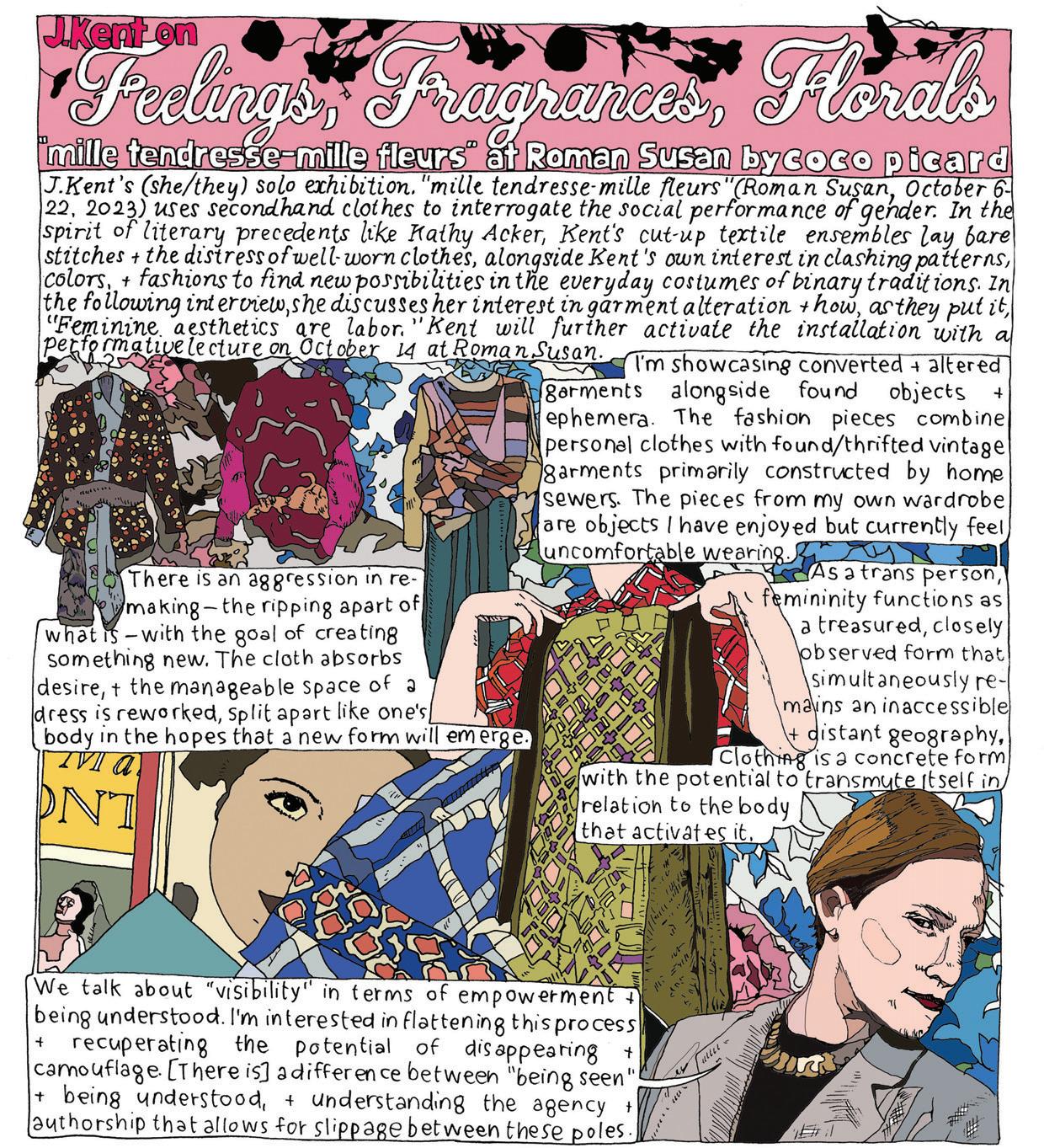
26 CHICAGO READER - OCTOBER 5, 2023 ll
Find out more about “mille tendresse-mille fl eurs” at romansusan.org. COCO PICARD

























OCTOBER 5, 2023 - CHICAGO READER 27 MUSIC 23/24 SEASON MONTEVERDI CHOIR + ENGLISH BAROQUE SOLOISTS DINIS SOUSA, CONDUCTOR J. S. BACH: MASS IN B MINOR BWV 232 October 20, 2023 / 7:30PM G. F. HANDEL: L’ALLEGRO, IL PENSEROSO ED IL MODERATO October 21, 2023 / 7:30PM 312.334.7777 | harristheaterchicago.org | 205 East Randolph Street 20th Anniversary Season Sponsor Irving Harris Foundation, Joan W. Harris HTP Mainstage Sponsor Alexandra C. and John D. Nichols Lead Performance Sponsor English Baroque Soloists. Photo by Slawek Przerwa Program Sponsor Claire and Michael O’Grady Nancy and
Performance Sponsor
Scott Santi
ARTS
CRAFT WORK
Small batches
Father-son team Ron and Jameel Bridgewater launch a line of sustainable soaps.
 By GONZALO GUZMAN
By GONZALO GUZMAN
Ajazz musician and a graphic designer launching their own line of custom soaps sounds like an odd proposal, but this father-son duo are combining traditional soapmaking practices with modern design for a unique collaboration centered around community.

Ron and Jameel Bridgewater, both originally from Urbana, Illinois, dropped their lavender and lemon tree body bars under Jameel’s brand Bascule in September, selling out within a few hours of launch. Described as a “bridge between our collective pasts and futures,” the brand focuses on small batches of handmade products with a goal of sustainability at every level.
“The foundation of my brand is figuring out new ways to advance making products, but also making them sustainable,” said Jameel. “Not just in the product but in how we are making them.”
Jameel has previously focused on wearable textiles, or what he calls “artistic explorations through garments,” by designing products around images he has taken or designed. For this first venture into home goods, the pair are combining Ron’s knowledge from a decade of research into soapmaking practices with Jameel’s eye for design to create a product they hope will resonate with customers.
Ron was initially inspired to pursue soapmaking to help his wife find products she could use on her sensitive skin. With a previous dream of being a homesteader, the 76-year-old jazz musician always had an interest in making products by hand. He searched the Internet for tutorials, looked through books at the library, and took a few workshops, but most of his process was trial and error.
“I made a batch of soap that was so bad that when you put it in water it would crumble,” Ron said, recalling an early failure.
About five years in, he perfected the process for an activated charcoal soap with the right combination of natural scents and oils his wife could use. He expanded to bath bombs
and deodorants, mostly shared with family and friends, until Jameel had an idea to dream even bigger.
Jameel studied graphic design at Columbia College Chicago, graduating in 2016, while simultaneously working as a graphic designer in the music industry. After four more years of freelance design work and landing a position at Universal Music Group in late 2020, he began to think about what he really wanted for the future.
“I did some inner research, some inner looking in trying to figure out what I actually wanted to do with the skills and things I’ve learned through my time in the industry with design, with my gifts,” said Jameel. “I started Bascule during the pandemic. It was me trying to focus on some things outside of work and find my purpose.”
Bascule, inspired by his last name and the bascule bridges famous in Chicago that use counterweights to raise and lower them, was created with community in mind. The first project was a documentary, Haneef , on Ron Bridgewater’s history as a jazz legend playing with the likes of Lena Horne, McCoy Tyner, Max Roach, Thad Jones, Mel Lewis, and other innovators of the genre. The film premiered at the DuSable Black History Museum and was released along with a baseball cap and two shirt designs, sold to raise money and buy equipment for a children’s jazz summer camp.
Subsequent projects included capsule collections made in collaboration with other creatives, but this soap will be the brand’s first launch of bath and home goods. Continuing his practice of working within his community, it feels like a natural progression for Jameel and Bascule.
“The foundation of the brand in general is working with friends and family and close community. Figuring out not just how to sell and get monetary growth, but community growth,” said Jameel. “We plan to do more programming and projects, inviting in community members and local artists to do
projects with us to celebrate culture, and also build funds to distribute to arts programs.”
Jameel recognized the value in the skill set Ron had developed and the product he had created for his mother. He thought about how a line of custom soaps made in small batches would not only be sustainable, but would allow them to build brand loyalty through human connection. Soap is an everyday part of your health and wellness routine, Jameel explained, but you don’t always know where the products you are putting on your body are coming from or how they are made.
He approached his father with the task of creating two body bars based on his own favorite scents: lemon and lavender. After several attempts they got the combination just right and Jameel designed the packaging using recycled and purposeful materials. The box is made of cardboard and cut at an angle to silhouette a bascule bridge, and a cotton bag wrapped around the bar doubles as a body exfoliator. He worked with Chicago photographer Daniel Delgado and stylist Mel Romanski to create imagery that evokes sculptural art pieces and elevates the soap beyond anything Ron could have imagined.
“I was blown away; he didn’t tell me he was doing it. He shows me these images and I’m like, ‘Are these my soaps?’” Ron said. “I can get the product, I can make it, I can research it, but when it comes to that next step of getting it out there, I’m not the one. Jameel is the one
who has the visions for how to package it, how to promote it, how to get it out, and what people actually respond to.”
“He’s the craft maker, the one that has all of this knowledge, this experience that I’m able to go in and highlight, which is beautiful,” Jameel said.
With the origin of Ron’s soapmaking stemming from the desire to create a product that met his wife’s specific needs, Jameel sees the core of this venture being custom orders. “I think made-to-order is the future in every industry if you want to focus on the customer and having them for a long period of time,” said Jameel. He plans to survey the initial group of customers and find out what their specific needs and wants are to develop the next drop of goods.
Moving forward, Ron and Jameel are excited for what other products will come out of community feedback and hope to one day create a studio where Black and Brown youth can pick up a craft that will allow them to generate income for themselves.
As they talked about future soap drops Jameel jokingly pitched his father a “revolutionary” soap you can eat in the shower, but Ron has something else in mind.
“We’re still developing, we’re still growing, we’re still learning about each other as father and son,” said Ron. “And now I’m just waiting for grandkids.”
m letters@chicagoreader.com
28 CHICAGO READER - OCTOBER 5, 2023 ll
Top: Jameel and Ron Bridgewater
Bottom: Bascule’s debut soap launch, styled by Mel Romanski
DANIEL DELGADO
& CULTURE R BASCULE Bascule.site instagram.com/bascule.site
v
Open run: daily 9:30 AM-4 PM, 9:30 AM-3 PM on Thu 10/12, Museum of Science and Industry, 5700 S. DuSable Lake Shore Drive, msichicago.org, adults $25.95, children 3-11 $14.95, free for members
REVIEW
How much plastic is in Lake Michigan?
“The Blue Paradox” shines a light on plastic pollution in our waterways.
By KERRY CARDOZA
Plastic has been found in the corpses of elephants in Sri Lanka, in human breast milk, in fish in Lake Michigan, in bottled water, in Antarctica. You’ve probably heard of the Great Pacific garbage patch, a floating mass of disintegrating plastic between Hawai’i and California that’s estimated to cover 620,000 square miles. Or the statistic that we ingest about a credit card’s worth of plastic each week.
The problem of plastics, particularly in our bodies of water, is the subject of “The Blue Paradox,” an immersive, educational exhibition on view at the Museum of Science and Industry. Sponsored by SC Johnson, the Wisconsin-based household product company (purveyors of Pledge, Windex, and Saran, among many other brands), and Conservation International, an environmental nonprofit, the exhibition explores “the pervasiveness of plastic pollution and the steps we can take to address it.” Since its debut as a pop-up exhibition in London, the show has been tweaked, with specific information added about plastic pollution in the Great Lakes and plastic use and recycling in Illinois and Chicago.
As I walked through the museum towards the exhibition, a marketing staffer told me how popular the show had become with social media influencers, a red flag for me, as I am allergic to the now-ubiquitous, hyper-commercial “immersive” exhibition. There are indeed immersive aspects to “The Blue Paradox,” but
rest assured they are in keeping with the nature of a science museum.
You enter the space through a blue-hued hallway, a projection of the ocean’s shoreline “splashing” onto your feet. Timed entry allows a set number of visitors into an enclosed room covered in screens, where awe-inspiring clips of bright sea life, crashing waves, fluorescent deep-sea creatures, and other nature scenes play all around you (cue the smartphone). Then the educational aspect starts, with a large screen in the next room showing a real-time depiction of the plastic stream entering the ocean. It tells us that the amount of plastic added to the ocean each year is equivalent to the weight of 665,000 Chicago city buses, or 888 pounds of plastic per second.

Other rooms, lit by glowing blue screens, facts streaming by on LED tickers, or backlit photos, are devoted to di erent themes: how animal life is impacted by plastics in the water, common questions about plastics, how much plastic is actually recycled each year. The final rooms feature interactive portals where you can, somewhat clunkily, calculate your plastic footprint, while statistics about Chicago’s plastic use and reuse play on a vast screen overhead. Here we learn that Chicago ranks as one of the “worst major cities in the United States,” with less than 10 percent of waste being recycled.
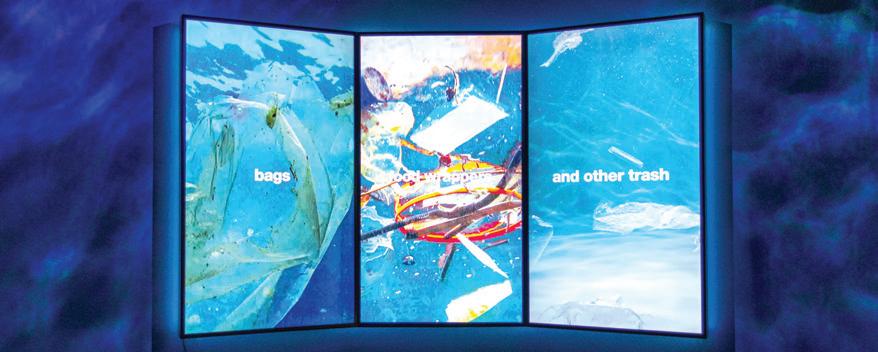
The plastic contamination of the Great Lakes is a serious issue. Collectively they
hold about 85 percent of the continent’s fresh water, providing drinking water for more than 40 million people. As the exhibition tells us, a gallon of tap water contains 34 microplastic particles on average. Microplastics are pieces of plastic that have broken down; they are typically less than five millimeters in length, or the size of a sesame seed. They could also be plastics that have leached from our clothes in the wash (fabrics like polyester, nylon, and acrylic contain plastic), bits of tire that have worn off vehicles, or industrial runoff. Researchers from the Rochester Institute of Technology have found that nearly 22 million pounds of plastic debris enter the Great Lakes every year. For Lake Michigan, the average annual plastic pollution “is approximately the equivalent of 100 Olympic-sized pools full of plastic bottles dumped into the lake.”
Throughout the exhibition, an emphasis is placed on the fact that government, industry, and individuals all have a role to play in increasing how much plastic is reduced, reused, and recycled. While it’s true that consumers aren’t without power—if everyone stopped buying single-use plastics tomorrow, eventually industry would have to respond—the real solution to the plastic “paradox” is to produce less of it. While single-use plastics are particularly evil, even recyclable plastic can only be reused a couple of times. (Whereas glass and metal can be recycled indefinitely.)
You’d be forgiven for casting a wary eye on SC Johnson as a sponsor for this show, though the company has some green clout. They’ve been outspoken about the need for stricter labels on “recyclable” products, create some of their packaging out of plastic rescued from the ocean, and use renewable energy to power some of their electrical needs. Less easy to find on their website is just how many plastic products they’re cranking out each year. Any expert will tell you that we can’t recycle our way out of this problem. Nor is this news: as NPR reported, the oil industry (from which plastic comes) knew in the 1970s and ’80s “that plastic could not be economically recycled” and so purposely “misled the public” its recyclability. While “The Blue Paradox” may falsely distribute the responsibility of solving this crisis to the public, in addition to governments and businesses, it is commendable that they’re drawing attention to the issue, which is only going to get worse. The U.S. currently produces more plastic waste than any other country, more than 46 million tons per year. By 2040, the exhibition notes, “there will be enough plastic in the ocean to bury every beach in the world under 30 pounds of plastic.” Oceans help regulate the climate, produce the oxygen we breathe, and contain 50 to 80 percent of all life on earth—ensuring its health seems imperative, not paradoxical. v
OCTOBER 5, 2023 - CHICAGO READER 29
COURTESY MSI ARTS & CULTURE R “THE BLUE PARADOX”
The plastic problem is the subject of “The Blue Paradox,” an immersive, educational exhibition at the Museum of Science and Industry.
kcardoza@chicagoreader.com
m
STAND-UP
Liz Miele breaks it down
The comedian talks about dyslexia, empathy, and inner rage.
By JACK HELBIG
Stand-up used to be a very white man domain. And the jokes you heard there were just the kind you would expect from a world dominated by verbally adept, passive-aggressive—or just plain aggressive— heterosexist white men: dick and sex jokes; ex-girlfriend jokes; racist, sexist, or homophobic jokes; jokes about getting bad service from waiters, baristas, airline personnel, customer service reps with accented English. Generally, anyone perceived to be powerless, or at least weaker, than the annoyed stand-up. Pretty
tiresome stu . And toxic.
But all that changed. God knows, there are still toxic men doing stand-up out there, and toxic man-loving audiences out there to laugh at them. But there are now a lot of non-cis men comics—women comics, comics of color, LGBTQ+ comics, comics who are neurodivergent—who sing a different tune, who don’t just stand there and shoot a stream of bitter, tired punchlines. Who tell stories, recount their lives, and deliver witty, telling critiques of the world.
And there are rooms for these comics to perform in, like the Den Theatre, that hosts a steady lineup of comics who would never have been given a chance in the bad old days, or would have been forced to be, say, the one chick on a program packed with white guys.
In October and November alone, the Den is presenting headliners Beth Stelling, Gina Brillon, Esther Povitsky, Liz Miele, Maria Bamford, Ziwe: The Black Friend Tour, and Jenny Yang.
We had a chance to talk to Miele, whose career was just taking o when the pandemic closed the clubs and shut down tours. Her response to the lockdown was to post videos of her stand-up routines and to record new material performed in front of small audiences. Since lockdown ended, Miele’s back on tour. We caught her a week before she recorded a new comedy special, Murder Sheets, on September 16 at the Bell House in Brooklyn (which at the time of publication had not yet been sold to a streaming service).

Jack Helbig: How did you become a stand-up?
Liz Miele: I started when I was 16 years old. So I grew up in Jersey and I discovered, like, you know, I loved comedies, and thought I wanted to be Sandra Bullock. I didn’t discover standup specifically until I was about 13, 14. And I just became obsessed. I watched everything that was on Comedy Central and everything that was on HBO.
I then thought you had to be an adult to do stand-up. And my best friend at the time bought me this how-to-do-stand-up book for my 15th birthday. My best friend also introduced me to a guy who had dropped out of high school and was a stand-up comic. He was 17 and an open-miker. But in my 14-, 15-yearold heart, I was like, “He’s doing it!”
So I started going into New York every weekend. It’s about an hour-and-a-half train ride from New Jersey. I convinced my parents to let me go four days a week, Thursday through Sunday, and just hand out flyers to get stage time, do open mikes, do whatever I could. I was 16 and 17, and didn’t look even that age at that time. I started in 2002, so I started a year after 9/11. And I’m a tiny girl, telling jokes at night in comedy clubs.
If I had a 16- or 17-year-old daughter, I would worry about her going into a city like New York City doing stand-up.
Yeah, I lied in the beginning. Then when I came clean, they were pretty supportive. But protective. The rule was I had to have an adult with me. Sometimes it was my friends’ parents, but a lot of the time it was my parents. And I’m one of five kids. My parents owned two veterinary hospitals, and worked 80-hour weeks.
I wouldn’t let them watch me because I didn’t want them to see what I had written about them. So my dad would sit in a Starbucks for two hours, and then if it went well, I would be in a good mood, and we’d take the train back, and I’d be hopping around and all excited. And if it didn’t go well, I would be a moody, bitchy teenager to my dad.
I did that for about two years and then when I got into college [The New School], and I was going to go to the city by myself anyway, my dad was like, you can only do stand-up on the weekends, and I was like, sure—and then I did stand-up every single night of the week.
Were you looking around for a creative outlet and then stand-up turned out to be the thing?
I think so. I always wrote stories, but stand-up made everything come together. I wanted to be funny, and I always liked writing and telling stories, but because I was dyslexic, I was really insecure about my writing. I think where the stars aligned was when I discovered stand-up was like, “Oh, I get to be funny and tell stories.”
But nobody has to read them on the page because I still don’t know how to spell, and my grammar is trash, and I live on run-on sentences, and all of a sudden none of that stu mattered because you’re now performing it, and nobody ever saw the physical form of it.
My dad is dyslexic. I’m one of five kids. We’re all some level of dyslexic.
Do you find your dyslexia helps you be more relatable to audiences?
I think I have a connection with people that might not connect with me otherwise. I know how to take larger ideas, whether you agree with me or not, and take you on a path to under-
30 CHICAGO READER - OCTOBER 5, 2023 ll
THEATER
Liz Miele in performance COURTESY LIZ MIELE
Liz Miele
Sun 10/22 7:15 PM, Den Theatre, 1331 N. Milwaukee, 773 - 697-3830, thedentheatre.com, $28 -$ 39 75 (two-drink minimum)

stand how I got there. I think I could have been a good teacher. They say good math teachers are usually the ones that math was hard for. I think, because school itself and learning itself is hard for me, when I’m trying to teach somebody something of mine, whether it’s a perspective or an analogy or just a new idea, I can break it down into bite-sized pieces that most people can understand because that’s how I learn.
Because a lot of your comedy is based on either observing what’s happening, or on little things that have happened to you in your life, do you have a notebook with you at all times?
If I don’t have my notebook with me, which is quite rare, I’ll type notes in my phone and then I’ll handwrite it later. Or if it’s like I’m driving or something, I’ll leave myself an audio message and then handwrite it later. I might not know what to do with it, and it might show up months or years later in a joke.
Do you have an example from your show?
So I recently posted from my Self Help Me special this situation where I was waiting in line at CVS and this woman asked to cut in line just because she had a greeting card. She was in a rush, and I was like, “Yeah, of course.” But then she proceeded to dump her life on me. And of course the whole time I’m talking to this woman, I’m being polite, but I can feel my mental rage build. As soon as she left, I found it so funny how this woman will never know how much I hated her. So literally, while she was checking out, I was writing down my feelings because I knew there was something there.
One of the things that’s really interesting about your onstage performing style is that you come o as both very strong and resilient, but also empathic. It’s like in your stories you are modeling how to process the craziness of life without becoming crazy yourself.
Yeah, I feel like I am an empathic person. But I think I also have a self-awareness of when I’m being ridiculous. That is both my observant comedic brain and also ten years of therapy.
Before in my routines, it was like, “I understand I’m being ridiculous, but everybody can go fuck themselves.” And now it’s like, “I know I’m being ridiculous, and I’m going to break down why, and then we’re going to make fun of other people, while still justifying why how we’re reacting is still correct in some fashion.”
I think all my jokes stem back to a basic strong emotion—fear, anger, disappointment, resentment, absolute glee, complete hysteria—these kind of strong emotions that we all go through even if they’re fleeting, [and ask] how I got there, why I got there, and why, even if I’m wrong, I feel that way.

How has your work changed over time?
I used to be really monotone, and everything was planned out before I ever went on stage. Over the years, I’ve been more brave and more trusting of my mind. If I was 90 percent prepared with a joke when I first started working on it, now I’m more like 30 percent prepared. I do a lot more editing on stage, and I kind of let it flow. I’ve allowed myself the freedom to let the audience response guide how deep and how far it’s gonna go.
What caused these changes in you?
I think learning to love myself, as cheesy as that is. I think therapy and accepting the flawed side of myself. I think I was scared that I was too much for audiences and it was too scary to be that vulnerable and to be that seen.
Have you performed in Chicago often?
A bunch. I do it every year. It’s one of my favorite cities. Cold as shit, and I’m cold every season, but I do enjoy it. I think there’s certain cities in America that have that rough-aroundthe-edges vibe that I have. That go-fuck-yourself vibe, like, “I’m going to tell you about something as it is and you can take it or leave it.” Clearly New York has it. I think Boston has it. And Chicago has it—where you can just kind of be your gross self. I mean gross like, “I’m not gonna sugarcoat my ideas or my feelings and I’m just gonna put it out there.” v
m letters@chicagoreader.com
Pro wrestling bursts onto the stage in a high-octane, immersive, 90-minute thrill ride.

It’s a night in the theater that you’ll never forget. Experience the heart-pumping action ringside, as the Goodman transforms into a professional wrestling arena—a perfect backdrop for the high drama and rich cultural history of lucha libre. Originally developed with Prism Movement Theater and produced in partnership with CLATA and the National Museum of Mexican Art as part of 2023 Destinos Festival, actors and luchadores (wrestlers) in masks representative of Aztec gods play out an exciting wrestling story about family, honor, tradition and redemption.
NOW THROUGH OCTOBER 29
Groups 10+: Groups@GoodmanTheatre.org
OCTOBER 5, 2023 - CHICAGO READER 31
THEATER GoodmanTheatre.org 312.443.3800
SPECIAL OFFER: Get $30 main
with
READER30 *Not valid on premium seating, on previously purchased tickets or in combination with other offers. Lead Funder of IDEAA Programming
WRITTEN AND DIRECTED BY CHRISTOPHER LLEWYN RAMIREZ AND JEFF COLANGELO
floor tickets
code
Illustration by Carolina Lopez Corominas
GOODMAN THEATRE IN ASSOCIATION WITH CHICAGO LATINO THEATER ALLIANCE (CLATA) AND NATIONAL MUSEUM OF MEXICAN ART PRESENT
Contributing Sponsor Co-Producers
THEATER
OPENING

R Wall Street bloodbath
Kokandy’s American Psycho is a slasher fashion show.
Last year for the Halloween season, Kokandy Productions presented Stephen Sondheim’s Sweeney Todd Now they’re back with another slasher songfest: American Psycho: The Musical, adapted from Bret Easton Ellis’s 1991 novel by book writer Roberto Aguirre-Sacasa and with a score by Duncan Sheik, whose original songs are interspersed with pop hits like “Everybody Wants to Rule the World” and “In the Air Tonight.” It’s definitely a case of style over substance this time around—Patrick Bateman, the bored rich investment banker at the center of Ellis’s story, has far less justification for his murderous rampages than barber Sweeney. But in director Derek Van Barham’s hands, the ensemble delivers a sardonic snapshot of 1980s excess and narcissism. (Yes, a certain Manhattan real estate mogul of the era who went onto, um, other things in more recent years is name-checked with admiration by Bateman.)
I confess I’ve never read Ellis’s novel and have only seen Mary Harron’s 2000 film starring Christian Bale as Bateman in bits and pieces, but I don’t think you need familiarity with the source material to enjoy what Kokandy has cooked up here. What it lacks in insight (breaking news: extreme consumerism and greed make soulless drones of us all!) it makes up for in wit and commitment to the disturbing worldview of Kyle Patrick’s creepily
charismatic Bateman. A strong supporting ensemble playing multiple roles and clever runway set design by G “Max” Maxin IV (who also designs the lights and projections) make us feel like we’re at a fashion show of the damned. —KERRY REID AMERICAN PSYCHO: THE MUSICAL Through 11/26: Thu-Sat 7 PM, Sun 5 PM; also Wed 11/22 7 PM, no performance Thu 11/23; Chopin Theatre, 1543 W. Division, kokandyproductions.com, $40 general admission, $50 reserved, students/seniors $30 (limited number of $15 student and artist tickets each performance).
R Math isn’t scary in El Baile de los Números

Teatro Tariakuri’s family show is joyful and lighthearted.
With Halloween just around the corner, what could possibly be spookier than bringing together two equally scary entities: witches and mathematics. However, in Teatro Tariakuri’s newest production, El Baile de los Números, the play’s theme is to destigmatize this fear around math and show the joy that numbers can bring. Under the direction of Karla Galván, the theater’s artistic director and founder, and performed by the theater’s Los Chilpayates youth ensemble of children ages 5 to 15, it’s a joyful and lighthearted product of what happens when a community makes the arts accessible and encourages kids to participate in them.
The 50-minute play, written by Tomás Urtusástegui,





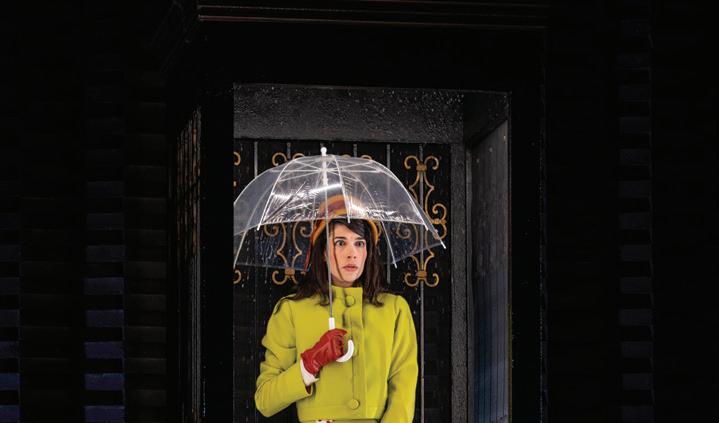
EURYDICE

 WRITTEN BY SARAH RUHL
DIRECTED BY BRADEN ABRAHAM
WRITTEN BY SARAH RUHL
DIRECTED BY BRADEN ABRAHAM
tells the story of an evil witch, Jasuda, who wants to get rid of all numbers. She kidnaps Addition, Subtraction, Multiplication, and Division. It’s up to the magician Renado to defeat her. Although audiences might agree with Jasuda, as she says no numbers means no woman will ever have to worry about her weight, they will truly understand the beauty of math by the time the show is over. A humorous play for audiences of all ages, witty dialogue and comedic behaviors are expressed flawlessly by all the actors—no doubt a sign of Galván’s effective direction and dedication to her theater and cast.
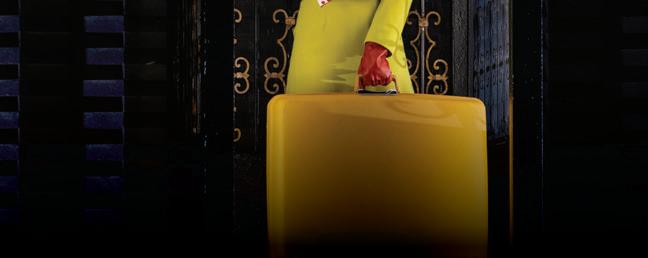
Through catchy musical numbers that the audience will find themselves singing along to, the talent of the young actors, and the educational message that some math problems in your school textbooks are really only there to scare you, El Baile de los Números (part of this year’s Destinos: 6th Chicago International Latino Theater Festival) is a must-see for all theatergoers. —JUSTICE PETERSEN EL BAILE DE LOS NÚMEROS Through 10/8: Sat-Sun 3 PM, Teatro Tariakuri, 3117 W. 63rd St., teatrotariakuri.org, $25, all ages, in Spanish with English subtitles
Eurydice loses its way
Sarah Ruhl’s take on Greek legend feels muddled at Writers.
At first, it seems like a match made in heaven. Or rather, Mount Olympus. But marriages between goddesses and mortals are complicated, and throughout Greek myth, their unions are defined by ultra-dramatic misfortunes.
So it goes with Eurydice and Orpheus, the former a minor deity and sea nymph, and the latter the musically gi ed mortal son of Apollo. (Point of clarification: Per the rules of Greek myth, the children of mixed marriages—one mortal and one god—are born mortal.) There are many versions of the myth of Orpheus and Eurydice, but Sarah Ruhl’s 2003 Eurydice follows the general outline, inflecting it with enough whimsy to fill a barge on the River Styx.
In director Braden Abraham’s staging for Writers Theatre, Eurydice (Sarah Price) and Orpheus (Kenneth La’Ron Hamilton) court and marry, only to be separated on their wedding day by the trickster Lord of the Underworld (Larry Yando). The heartbroken Orpheus embarks on a quest to recover his bride. He does this by creating music so beautiful it makes a choral trio of Stones weep. He’s so good, Eurydice is allowed one last chance to enter the land of the living. Spoiler alert: It doesn’t go well.
Abraham’s staging relies heavily on production values. Orchestral sweeps of cinematic music (original music by sound designer Jeffrey Levin) are worthy of a concert hall, but overwhelm the Writers space. There’s an analogous issue with Courtney O’Neill’s vast set. It swallows up the actors and makes them seem small, even when they’re riding the (very slow) elevator down to the underworld. Danielle Nieves’s costumes are rich in elaborate, colorful distractions: costuming the chorus of Stones in Parrothead garb does nothing to enhance character or story.
Eurydice succeeds in providing Hamilton a hypnotic
32 CHICAGO READER - OCTOBER 5, 2023 ll
SEASON SPONSOR NOW PLAYING THROUGH OCTOBER 22 847-242-6000 I WRITERSTHEATRE.ORG DON’T MISS WHAT THE NY TIMES HAS NAMED ONE OF THE TOP 25 PLAYS OF THE LAST 25 YEARS.
Pictured: Sarah Price. Photo by Michael Brosilow.
showcase, as his poetic, exquisitely graceful Orpheus seems to summon the very music of the spheres, conducting with movements as volatile as a wild ocean and as subtle as the flit of a butterfly wing. But it never really takes flight. Its quirky, profound meditations on loss and love are lost in a muddled story. —CATEY SULLIVAN EURYDICE Through 10/22: Wed and Sat 3 and 7:30 PM, Thu-Fri 7:30 PM, Sun 2 and 6 PM; Writers Theatre, 325 Tudor Ct., Glencoe, 847-242-6000, writerstheatre.org, $35-$90
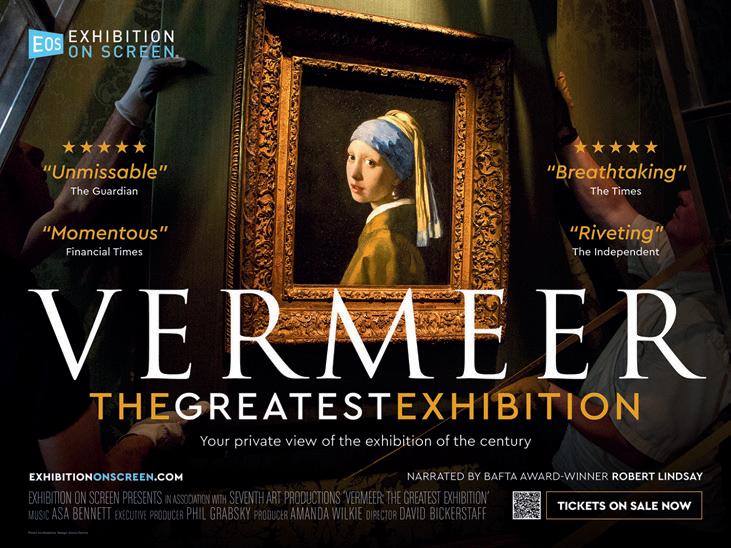
Lycan it rough

Redtwist’s Wolves casts a full moon on queer anxieties.
The roommates in Steve Yockey’s 2013 one-act “Little Red Riding Hood” redux are too young to be spending their weekends hunkered down like grannies in a cabin, but that’s exactly what their domestic situationship has devolved into. Ben (Joshua Servantez) fears the “forest” of the big city and prefers DVDs over dance floors; Jack (Gardy Gilbert) would rather go on the prowl for a good time.
Directed by Redtwist Theatre artistic director Dusty Brown, this season’s debut creates some pulpy Halloween fun while riffing on anxieties inherent to the gay community, like blurred friendship-lover lines, isolation, and hookup culture intimidation.


Much has been written about the special relationship between the horror genre and queer artists, and at Wolves’s core is a spectacularly uncomfortable,

hilarious, teeth-gritting scene of sloppily negotiated consensual nonconsent that capitalizes on that relationship beautifully. It’s a true can’t-look-but-can’t-look-away moment of horror-comedy that works in no small part because of great performances by Michael Dias as a silver daddy “wolf” (pitiful and approachable one moment, then menacing the next) and Gilbert as a naive, horny young man who goes out looking for trouble, then—to his terror—finds it.


Even at a brisk 75 minutes, though, there are too long and too frequent stretches that feel like vamp-















































































































































































ing for time. Yockey’s inclusion of a clap-in, clap-out narrator (Monique Marshaun) makes sense as a fable book reference but, in practice, severely undercuts any momentum and grabs Yockey’s play by the hind leg

whenever it seems ready to take off into a sprint. —DAN JAKES WOLVES Through 11/5: Thu-Sat 7:30 PM, Sun 3:30 PM; Redtwist Theatre, 1044 W. Bryn Mawr, redtwisttheatre.org, $30 v

OCTOBER 5, 2023 - CHICAGO READER 33
6-12 at the siskelfilmcenter.org/vermeer-greatest-exhibition THEATER
October
Wolves TOM MCGRATH/TCMCG PHOTOGRAPHY
FILM
THE PEOPLE’S JOKER
92 min. Chicago International Film Festival
Fri 10/ 13 at 10 : 30 PM, AMC NEWCITY, $15 Sun 10/ 15 at 11: 30 AM, Gene Siskel Film Center, $22 chicagofilmfestival.com/film/the-peoples-joker
warns her by saying, ‘The city is full of leather freaks and neon biker gangs and cross-dressers,’ it was like, ‘Oh my God, that sounds great. Like, please send me to that city.’”
PREVIEW
The Joker belongs to us all
The People’s Joker, Vera Drew’s copyright-challenging trans film, makes its local debut at this year’s Chicago International Film Festival.
By ANNIE HOWARD
Atelevision screen flickers between channels, as it jumps from a daytime talk show to an Alex Jones stand-in complaining about the menace of transsexuality, before landing on UCB Live . The show is a not-sosubtle send-up of Saturday Night Live , even featuring Lorne Michaels as its domineering, uncanny valley, cartoonish director. Yet in The People’s Joker , a film that otherwise treads primarily upon the grounds of the well-known but fictional world of Gotham City, Batman, and the film’s titular antihero, UCB’s musical guest, Sinéad O’Connor, is a surprising, poignant connection to our world, one that otherwise appears only in the fun house mirror world of cultural parody.
For Vera Drew, director, writer, and lead performer in the film, O’Connor’s presence was significant. Even before the Irish singer’s
untimely death in July reminded the world of her iconoclastic, defiant challenge to the Catholic Church—most famously on her 1992 SNL appearance in which she ripped up a photo of the Pope—the singer showed Drew, who grew up Catholic and witnessed the church’s abuse scandals as a kid, the importance of artistic freedom. As someone who commented “IT IS NO MEASURE OF HEALTH TO BE WELL ADJUSTED TO A PROFOUNDLY SICK SOCIETY” on her own New York Times profile, O’Connor’s words are themselves an apt descriptor of the role that the Joker has played in the Batman universe, a nihilistic outcast unable to cope in the fraying urban metropolis.
“In this world, we’re all obsessed with appearances and saying the right thing, and making sure we don’t say anything that gets us canceled or upsets either side of the aisle or whatever,” Drew says. “When you speak truth
to power, especially in art, it’s always going to be a pathway to freedom. It’s not always going to be a smooth and joyful ride, but it’s gonna always lead to the other side.”
“A smooth and joyful ride” is not how you’d describe the rollout of The People’s Joker . Launching into wider cultural awareness on the heels of a viral movie trailer—which Drew began as a quarantine-inspired, one-woman project that eventually brought in over 100 remote collaborators—the film always ran uphill against the threat of copyright infringement claims launched by Warner Brothers. That’s kept the film in legal limbo, and while Drew has successfully shown the film at festivals around the world, including one cosponsored by the studio, she’s yet to clear a proper distribution strategy for its wider release, making its two screenings at the Chicago International Film Festival a must-see experience for anyone interested in the project.
The People’s Joker tells the story of [REDACTED], a young boy (whose deadname is bleeped out every time it’s used) who longs to escape the cornfields of Smallville and become a successful comedian in Gotham. Uncertain gender feelings expressed to his uptight, scared mother land our protagonist in Arkham Asylum, where Dr. Crane administers the teenage boy a hefty dose of Smylex, a drug otherwise used to dull the complaints of unhappy housewives, leaving its users in a state of numbed-out, forced-smile falsity. It’s a fitting origin story for the Joker’s disturbing grin: dysphoric feelings of gender discomfort masked with a drug-induced giddiness.
Drew has described the film as a comingof-age story with parallels to her own, and while the people’s Joker needed to escape Smallville, Drew sought refuge in Chicago.

Born in Joliet and raised in Mokena, Drew says her childhood trips to the city saved her life, even beginning her career as a teenager in the city’s many comedy clubs before she attended DePaul University. The city was a lifeline for Drew, a reminder that there would always be more than the stifling confines of small-town thinking.
“In suburbia growing up, I didn’t know I was trans, though I had a general idea that there was something a little bit queer about me, mostly because all the bullies would call me that,” Drew says. “In the movie, when her mom
Of course, the Gotham that’s frequently seen in the Batman universe is one of despair and decay, its inequalities and rampant violence unmistakable. While the franchise obviously centers the exploits of Bruce Wayne, multibillionaire and dispenser of vigilante justice, Todd Phillips’s 2019 film Joker revealed the obvious: in a city that cannot meet its people’s basic needs, the idea of a Joker-like figure is inevitable, and “that character su ers because the state has failed him, like he can’t get the drugs or the mental health access he needs,” as Drew says. The People’s Joker only heightens these themes, further implicating trans characters who are so often made to be the villains, often against their will.
“Trans people are completely villainized in this world, and the way a lot of us are portrayed in the media is already either oversimplistic, very heteronormative, or just offensive,” Drew says. “I wanted to subvert that by making all the villains in this parody version of the Batman universe queer, especially when the text itself is pointing out that the so-called ‘good guys’ of our society are always failing us.”
Today, superheroes are more than just the good guys: in an age in which billions of dollars are spent each year making comic book adaptations, such content, whether you want to engage or not, has become e ectively inescapable. Someone like Sinéad O’Connor, who used a fleeting moment in the spotlight to challenge a world-shaping institution like the Catholic Church, could catalyze people like Drew toward honest expression. Now, deep within a media culture that offers precious little oxygen for original thinking, Drew has reimagined one of our most widely-known fictional worlds toward her own ends, a defiance that uses these familiar scripts against themselves.
“If I have to walk down the street and see five billboards for the next Batman movie, I think I have just as much ownership over these characters as Warner Brothers,” she says. “It’s been shoved down our throats for years now that these superheroes are our modern myths, and if the function is about coming of age and understanding yourself and the world you live in, people like me should be making films like this.” v
m letters@chicagoreader.com
34 CHICAGO READER - OCTOBER 5, 2023 ll
A still from The People’s Joker CHICAGO INTERNATIONAL FILM FESTIVAL
Get showtimes and see reviews of everything playing this week at chicagoreader.com/movies
NOW PLAYING
Dicks: The Musical
Dicks: The Musical strives to set a high bar for future A24 musicals. Despite its clever show tunes, raunchy jokes, Bowen Yang’s God, a musical number starring Megan Thee Stallion, and profuse gags that make you say “wow,” this movie won’t live up to its cult-classic expectations. Granted, at first, the film—based on Aaron Jackson and Josh Sharp’s two-person show Fucking Identical Twins—has charm. But its allure is diluted by what can only be described as its “randomcore” edge.
Craig (Sharp) and Trevor (Jackson) are two of a kind. They love money. They love women. But most importantly, these two love themselves. Things get complicated when the two men come face-to-face a er their companies merge, and suddenly the fiercely competitive salesmen feel threatened by one another. Amid their newfound rivalry, Craig and Trevor confront their joint loneliness in the movie’s best number, and at the end, they discover they’re long-lost identical twins (who look nothing alike) when they connect their broken heart lockets.
From this point, the musical plays out like a zany The Parent Trap remake. This time, Nathan Lane is the bisexual cosmopolitan father, and Megan Mullally is the eccentric, agoraphobic mother. As you can imagine, Lane and Mullally together almost pump life back into the movie. Still, the barrage of overwrought jokes or haphazard bawdiness is bound to make an audience tap out too early. There are only so many times a joke about their mother’s vagina falling off or bits about their father’s telepathic “sewer boys” can solicit a laugh—no further questions.
Dicks: The Musical’s unyielding endeavor to shock us diminishes what really could’ve been a timelessly hysterical film. And what feels like an extremely fun movie to make doesn’t come together as fun for anyone else: it’s an inside joke for the cast and crew. Ultimately, Dicks: The Musical’s desire for cult-classic status is its biggest downfall, because that’s not how a movie procures that title. —MAXWELL RABB 86 min. Limited release in theaters, followed by wide release
PAW Patrol: The Mighty Movie
For more than a decade now, Paw Patrol has held the
world’s children in thrall. The thinly plotted series about a group of do-good talking pups is a certified global phenomenon, now airing in 160 countries and yielding not just billions in dollars from constantly churning merch sales but also a touring live show, a spin-off series, and innumerable parental grumbles over why some tenyear-old kid named Ryder is responsible for the health and welfare of not just a bunch of dogs but also a whole regional metropolis.

That’s the whole thing about Paw Patrol, though: it’s never really made much sense, nor had any of the depth, heart, or sensibility of more interesting and beneficial kids shows like Bluey or Sesame Street. Kids love it, though, and parents love their kids (and love things that keep them quiet and happy), so when the first Paw Patrol movie came out in 2021, audiences flocked to the theaters in droves, with the movie grossing over $140 million internationally.
Now there’s a second Paw production (with a third on the docket for 2026). Paw Patrol: The Mighty Movie finds Skye, Chase, Marshall, Zuma, Rocky, Rubble, and Liberty once again tasked with keeping the residents of Adventure City safe while they work to rein in the hairbrained machinations of a megalomaniacal
mad scientist (Taraji P. Henson) hell-bent on capturing the superpowers encased in the crystal center of an earthbound meteor. Of course, things don’t always go to plan, and the pups end up with the superpowers themselves, a blessing that somehow manages to throw Skye (voiced in the movie by Mckenna Grace) into a bit of a confusing tailspin about how she’s the smallest (?) pup and how she’s never felt fully appreciated in the group or accepted in the world. That revelation leads to a bunch of back-and-forth action between the pink pup and Henson’s Victoria Vance, all of which naturally leads to (spoiler alert!) the pups prevailing. (As if there was any doubt.)
There are a few titter-inducing jokes in The Mighty Movie and a couple of “huh” cameos from famous kids like North and Saint West, but nothing about the Paw sequel is anywhere near as compelling, surprising, or even as mildly interesting as the pups’ first movie, which, let’s be honest, already wasn’t Citizen Kane. It won’t matter, of course: kids will want to go, parents will take them, and the movie will rake in the bucks both at the box office and in the toy aisle. What a doggone shame. —MARAH EAKIN PG, 92 min. Wide release in theaters v
OCTOBER 5, 2023 - CHICAGO READER 35 FILM
R READER RECOMMENDED
MUSIC
Yvonne Gage is living
her best life
A er decades working mostly in backup vocals and advertising jingles, the Chicago jazz and R&B singer has finally returned to the spotlight.
By AARON COHEN
On a recent Wednesday night, the Chicago Jazz Soul Collective played one of their frequent gigs at the Jazz Showcase. A few songs in, guest vocalist Yvonne Gage sauntered onstage, smiled, and shifted their dynamic. She sang for a few numbers, filling in for regular vocalist Dee Alexander, and her subtle performances underpinned her polished phrasing with determination. As the sextet put new twists on grooves rooted in the 1960s and ’70s, Gage personalized the music, whispering or shouting as the mood required. The applause meant more to her than most of the audience likely realized.
Gage has been singing for more than five de-
cades, and today she’s living her ideal life. This spring a remix of her song “I Feel Love” (from her 2022 album, Feel Love ) became popular in Europe. Her silken but steely tone on the up-tempo track might remind you of her early1980s R&B tunes that got played in dance clubs. Meanwhile, she now has a platform to sing the jazz standards she’s always adored. For decades, most of her performances were as a backup singer or as the faceless voice of a commercial jingle, so the gigs she’s been booking lately give her a sense of personal empowerment—the focus is finally on her talent again. When she fronts a new group of longtime colleagues at the Promontory this weekend, everyone in the room will see who she really is.
“The best performance that I can do is what is natural to me, where I don’t have to contrive,” Gage says, sitting in a restaurant near her home in the West Loop. To her, jazz singing is an act of radical transparency. “I just am; I just do it. That’s not to say I’m not R&B, because I’m that too. If I had a choice, if I had to pick one to be, it would be a jazz artist. So I’m going to keep doing what I do and keep combining the two, because I like the sound of the two of them together.”
O stage, Gage exudes the same sunny personality she did at the Jazz Showcase. Her signature black-and-gold ensemble includes elaborate yet tasteful jewelry designed by her romantic partner Undra Heard. She also pro jects an assertiveness that undoubtedly

36 CHICAGO READER - OCTOBER 5, 2023 ll
Yvonne Gage in her West Loop home CAROLINA SANCHEZ FOR CHICAGO READER
CHICAGO SOUL JAZZ COLLECTIVE FEATURING YVONNE GAGE Wed 10/4, 8 and 10 PM, Jazz Showcase, 806 S. Plymouth Ct., jazzshowcase.com, $20, $30 VIP, $15 student, 21+
YVONNE GAGE
Featuring the Abney Effect and hosted by DJ Sam Chatman. Fri 10/6, 6:45 PM, the Promontory, 5311 S. Lake Park Ave. W., promontorychicago.com, $25, $35 seated, $45 VIP, $150 six-guest couch section, 21+
helped her through many setbacks, including an unfortunate episode in the mid-80s when she ran afoul of a bunch of suits protecting their rights to Michael Jackson’s “Thriller.”
Gage grew up in Lawndale in the 1960s and 1970s, west and a little south of where she lives today. In 1975, the New York Times declared of the west side that “many consider it among the worst slum areas in the nation.” But that’s not Gage’s lasting memory. “Lawndale was good,” she says. “A lot of families on the block. A lot of community, happiness. I lived a trouble-free life in that area. It was wholesome. Unfortunately, it’s not like that now.”
Presentation Catholic Church (3908 W. Lexington) was one of the community’s cornerstones, and Gage began singing there as a girl. When gospel came to Presentation, Gage says she “learned to throw away that light, pure, angelic voice” and build a rougher sound, closer to what soul singers had created by bringing the shouts and moans of Baptist and Pentecostal services into R&B. She also noticed how her slightly older neighbors were harmonizing, and she’d soon join them.
Gage began attending Holy Name Cathedral High School, but it didn’t do anything to foster her love of singing. “I picked Cathedral because it was not an all-girls school,” she says. “The disconnect was, I went to this school and I realized they had nothing for me: no music at all, no gym. Every day when I got out of school—when everyone else was going to whatever the extracurricular activities were—I went to rehearsals with my girls. My training came from spending the day, all day, listening to Aretha Franklin, Sarah Vaughan, people who I loved. That’s where my training came from: in my living room.”
In the mid-1970s, Gage joined a vocal group called the Soulettes—they’d been together for a few years already and had released a single in 1970. Small clubs and bars lined the major streets in their neighborhood, and rules were lax enough that an underage singer could perform in them. At one such venue they met an early champion, DJ Sam Chatman, who may be best known for codifying stepping.
“The Safari club was a dive, kind of down in the basement on Madison and Pulaski,” Gage says. “People just partied everywhere. And there I was, I’m 14 years old, I’m not supposed to be there. Sam agreed that if my parents chaperoned, he’d let me perform, and that was my first performance. A little scary, but more fun than scary—and the girls are my sisters to this day.”
Producer Donald Burnside began working with the Soulettes, and while he admired all their voices, he saw Gage as a standout. The group went through a few transformations, changed their name to Love, and then recorded an album as First Love in 1982—but by then, Gage had left to pursue her own opportunities. These jobs included singing background for another Burnside client, Daryl “Captain Sky” Cameron, on the 1979 album Pop Goes the Captain . Cameron has remained a steadfast collaborator.
“Yvonne had the kind of voice that lent itself to recording—not only lead but backgrounds,” Burnside says. “Not every lead singer sounds good on backgrounds. You never heard Whitney Houston singing a lot of backgrounds. But Yvonne is multifaceted when it comes to that. She has a wonderful lead voice and lead presence, while to this day her voice just sounds great backing up other artists.”
Then as now, Gage mainly sticks to a soprano register, though she can perform the Chicago Soul Jazz Collective’s songs in Alexander’s alto range. It just takes more effort these days.
“I wish I had the range that I had when I was in my 20s, when it was e ortless to flow between one octave and another,” Gage says.
“It’s more of a struggle now, but I do have range. You can’t stay in the same spot with a song. I don’t care how sweet, somber, or whatever, you got to take it someplace.”
Powered by this versatility, Gage began releasing records under her own name. The first was a Burnside composition and production, 1981’s “Garden of Eve,” released by RFC Records and distributed through Atlantic.
A video clip of an enthusiastic Gage, decked out in her signature black and gold and lipsynching this irresistibly joyful invitation to dance, appears on the 2015 Numero Group DVD and album set Ultra-High Frequencies: The Chicago Party, which documents a shortlived 1982 television show shot at south-side venue CopHerBox II.
“Garden of Eve” made a dent on the Billboard dance charts—climbing to number 36 in early 1982—but it defies easy categorization. Popular in European clubs, the song rides on a rhythm that elides disco’s more insistent fouron-the-floor and foreshadows what became known as house music; meanwhile her singing style is old-school R&B. Gage feels that since the track didn’t easily fit into any one realm, it wasn’t fully embraced at home.
“What would you call that?” Gage asks. “It’s dance music, but it’s not house, but it kind of
is. It’s huge overseas, but here they don’t know what it is. It predated house, and I think for house people, house is house and that’s it.”
Burnside also produced, arranged, and composed most of the tracks on Gage’s 1984 LP debut, Virginity , released by local label Chycago International Music and distributed through CBS. The album combines solid string and horn arrangements with electronic keyboards and the insistent programmed dance beats of the era. Gage was most comfortable singing the ballads, and she recalls being most
MUSIC
Temperton, I guess we should be grateful he wasn’t interested in suing us. Just slapped us on the hand, and that killed the record, killed the album.”
Burnside likewise claims that CBS pressured independent promo people to bury the record, but he tells the tale di erently.
“Me being young and frisky at the time, our team asked me if I could do the song and not create copyright infringement,” he says. “We did that all the time with commercials. I knew exactly how to do it, even though I said,
uncomfortable posing for the cover photo. She’s wearing white lingerie, standing awkwardly with a white fur coat held in front of her legs.
“I remember the day we shot the cover like it was yesterday,” Gage says. “I was so embarrassed. They had people there from CBS who were overseeing it—it was their idea. They were all there, and I felt that I was naked. That part was weird to me. The album was a good idea that didn’t land well. There are things I liked, but they made a lot of mistakes with me, down to the mastering.”
The album’s biggest liability was its intended novelty hit, “Doin’ It in a Haunted House.” Because it was an answer song to Michael Jackson’s “Thriller,” it adapted the original’s squared-o beat and synth-bass licks, tweaked its famous horn sting, and even used some similar melodic phrases. Thriller had come out on Epic Records, a CBS label, and though it had already become the best-selling album of all time by 1984, the folks at CBS (and presumably “Thriller” songwriter Rod Temperton) turned out to be pretty invested in demonstrating that they would still protect their turf.
“I was so mad at Don,” Gage says. “I asked him, ‘Is it OK for us to do this? Do we have to give him credit for this?’ He said, ‘Oh, no.’ He swore up and down that it’s not the same thing. But it is, though. ‘Haunted House’ was all the rage—they booked me to do a TV show in the UK. The day before I was scheduled to go, we get a call—the show was canceled. Rod
‘Let’s give Rod Temperton credit for the song and put it out there.’ But then, ultimately, Rod Temperton’s publishing company called, were very laid-back and were like, ‘We don’t know if we have a copyright claim, but we’re calling if maybe we do.’ Their attitude was: ‘Let’s just see how the record does, and if it’s a big pie, we want to have our piece.’ But CBS Records had a totally di erent approach. CBS said, ‘Let’s just kill this.’ And they did. Pow, out of there. Over with. That was CBS just turning o the faucet.”
Gage continued to work, primarily as a backing singer, where she expanded her musical vision even as she remained in the shadows. These gigs include a 1984 tour with Ministry in support of their early synth-pop album With Sympathy . (She’d later appear on the band’s 1999 record, Dark Side of the Spoon .) Gage also accompanied older R&B and blues artists, including Tyrone Davis and Willie Clayton, both of whom helped her improve her stage presence.
During the late 90s and early 2000s, Gage also sang on R. Kelly recordings. She remembers the sessions as conducted professionally. Now that she knows about his crimes away from the studio, her thoughts are with the young women he hurt. “It’s shameful and especially sad that he’s from Chicago,” she says.
Gage had started singing television and radio advertising jingles in 1981. She did a lot of work for Chicago-based Herschel Commercial, which was founded in the mid-1970s and became a premier Black-owned production
OCTOBER 5, 2023 - CHICAGO READER 37
“I’m going to record until I can’t record any more. What are my expectations? None. To make music.”
—Yvonne Gage
ON
MUSIC
CHICAGO SOUL JAZZ COLLECTIVE FEATURING YVONNE GAGE Sat 11/4, 7:30 and 9:30 PM, Winter’s Jazz Club, 465 N. McClurg Ct., wintersjazzclub.com, $27.75, $32.75 VIP, 12+ with parent or guardian
4544
LINCOLN AVENUE, CHICAGO IL OLDTOWNSCHOOL.ORG • 773.728.6000
THURSDAY, SEPTEMBER 28 8PM
David Longstreth (of Dirty Projectors)
with Sen Morimoto In Maurer Hall
SATURDAY, SEPTEMBER 30 7PM
Joel Styzens with Herine Coetzee Koschak
and members of ATLYS In Szold Hall
SUNDAY, OCTOBER 1 7PM
Miko Marks In Szold Hall
WEDNESDAY, OCTOBER 4 8PM
Cut Worms
with Ryder The Eagle In Maurer Hall
FRI, OCTOBER 6 & SAT, OCTOBER 7 8PM
The Handsome Family with special guests Jon Langford & Sally Timms In Maurer Hall
SUN, OCTOBER 8 7PM
Blind Boys of Alabama
In Maurer Hall
WED, OCTOBER 11 8PM
This Paranormal Life
Live! In Maurer Hall
SAT, OCTOBER 14 8PM
Omara Portunodo
Farewell World Tour! In Maurer Hall
SUN, OCTOBER 15 4PM & 7PM
Kaki King In Maurer Hall
WED, OCTOBER 18 8PM
La Vent du Nord
In Maurer Hall
THU, OCTOBER 19 8PM
Hawktail & Väsen
In Maurer Hall
FRI, OCTOBER 20 8PM
Bill Frisell In Maurer Hall
continued from p. 37
company in the industry. These jobs not only provided steady paychecks but also let her stay in Chicago to raise her son, instead of submitting herself to the rigors of touring. But she never stopped wanting to perform her own music.
“The jingle business was so phenomenal, but it kept me from doing what I was supposed to be doing for a long time,” Gage says. “It was just a whirlwind: Thirty-plus years in jingles and making top dollar. Ultra Curl, Coca-Cola, 7 Up, AT&T, Klondike bars: every product in your household, I did a commercial for it.”
Gage ultimately worked in advertising for more than 30 years, but jobs for artists like her began to dry up during her last decade or so in the industry. She says that the September 11 attacks caused a drop in business, and she also believes that performers were ultimately harmed by the side effects of a 2000 labor battle between advertising companies and SAG-AFTRA (a union representing actors, broadcasters, singers, and other media professionals).
“During the strike, they learned how to advertise without paying this money to talent,” Gage says. “They did needle drops, they did licensing, animation. Then they started doing buyouts. After they realized they didn’t have to pay this kind of money, it was over.”
In the 2010s, Gage stopped working in advertising, but she’d found other means of supporting herself. She taught vocal performance at Roosevelt University for six years, beginning in 2014, where she passed along what she’d learned about stage presence and reaching higher notes. In 2015 she performed as one of the backing singers on Stevie Wonder’s Songs in the Key of Life tour. Though the closest she got to Stevie was during the concerts’ preshow prayers, Gage describes those gigs as “the highest of highs.” She sang on a few episodes of the TV show Empire, and she performed with Aretha Franklin not long before her death in 2018.
“The best show was the very first one, in Boston,” Gage says. “It was an ocean of people, and Aretha had just come back from illness. I can’t remember what song we did, and everyone fell apart—she started crying, the audience was crying. It was just a spiritual moment. It was hard working with her, but I wouldn’t trade it for the world.”
OLDTOWNSCHOOL.ORG

With the help of industry friends, Gage was able to resume recording under her own name around 20 years ago. In 2004 she self-released a self-titled R&B album that showcased softer
tunes. On tracks such as “Surrender” and an update of Sharon Ridley’s 70s ballad “Stay a While With Me,” Gage’s quiet phrasing contrasts with propulsive bass lines.
In 2018, Gage joined the band First Touch on the single “Tonight’s the Night” b/w “You Can Have It All,” released by young Chicago-born modern-funk label Star Creature Universal Vibrations—which hailed her as a “first generation soul and boogie artist.” Maurice White, an executive at Universal, financed Feel Love, which features more of her jazz inflections and includes keyboardist Mike Logan. Gage sees all these releases, taken together, as testifying to her resilience and endurance.
“You better have a straight head on in this business,” Gage says. “I’m going to record until I can’t record any more. What are my expectations? None. To make music. There was a time when I used to pine over where I wanted to go, how I wanted it to happen, and that it had to happen. But I’m grateful to be the age that I am and still viable.”
Saxophonist John Fournier, coleader of the Chicago Soul Jazz Collective, notes that Gage brings all of those life experiences to the ensemble.
“Yvonne can do whatever she wants with it
“The jingle business was so phenomenal,” says Yvonne Gage, “but it kept me from doing what I was supposed to be doing for a long time.”

and makes decisions quickly,” Fournier says. “A lot of jazz singers are wonderful, but they have a feel for jazz singing from the 1940s and ’50s. She has that in her wheelhouse, but also a lot that sounds modern. It’s just seamless— she never sounds like she’s searching.”
Ultimately, Gage yearns to lead her own group, and she’ll get a chance at the Promontory on Friday. She’s also singing again with the Chicago Soul Jazz Collective (this week at Jazz Showcase and next month at Winter’s), and she has a few spring concerts in France booked under her own name, where she’ll perform her dance hits. But whether she’s singing jazz or the light funk that’s now called boogie, Gage just wants to put the songs first.
“If you want to be an all-the-way-around performer, you have to think about every note you’re singing, and you have to go into a zone,” Gage says. “I’m standing here and all these people are looking at me, but I’m in another place. It’s important for you to convey not just vocally but physically in singing what you’re talking about and what it means to you. It’s how to have longevity in this business. People want to be moved.”
m letters@chicagoreader.com
38 CHICAGO READER - OCTOBER 5, 2023 ll
SALE
NOW!
N
UPCOMING CONCERTS AT
Commemoration
50th
10/4
of the
Anniversary of the Coup of Chile
MUSIC WEDNESDAY SERIES FREE WEEKLY CONCERTS, LINCOLN SQUARE
10/11 Raqs Al Flamenco WORLD
v
CAROLINA SANCHEZ FOR CHICAGO READER
Enjoy Jazz & Blues from Logan Center and its partners; jazz, classical, early, world, and contemporary from UChicago Presents; special guest soloists, multi-arts collaborations, world premieres, masterworks, and unusual repertoire treasures from UChicago’s Department of Music; world premiere and recently composed works by leading and emerging composers from the Chicago Center for Contemporary Composition; and much more.
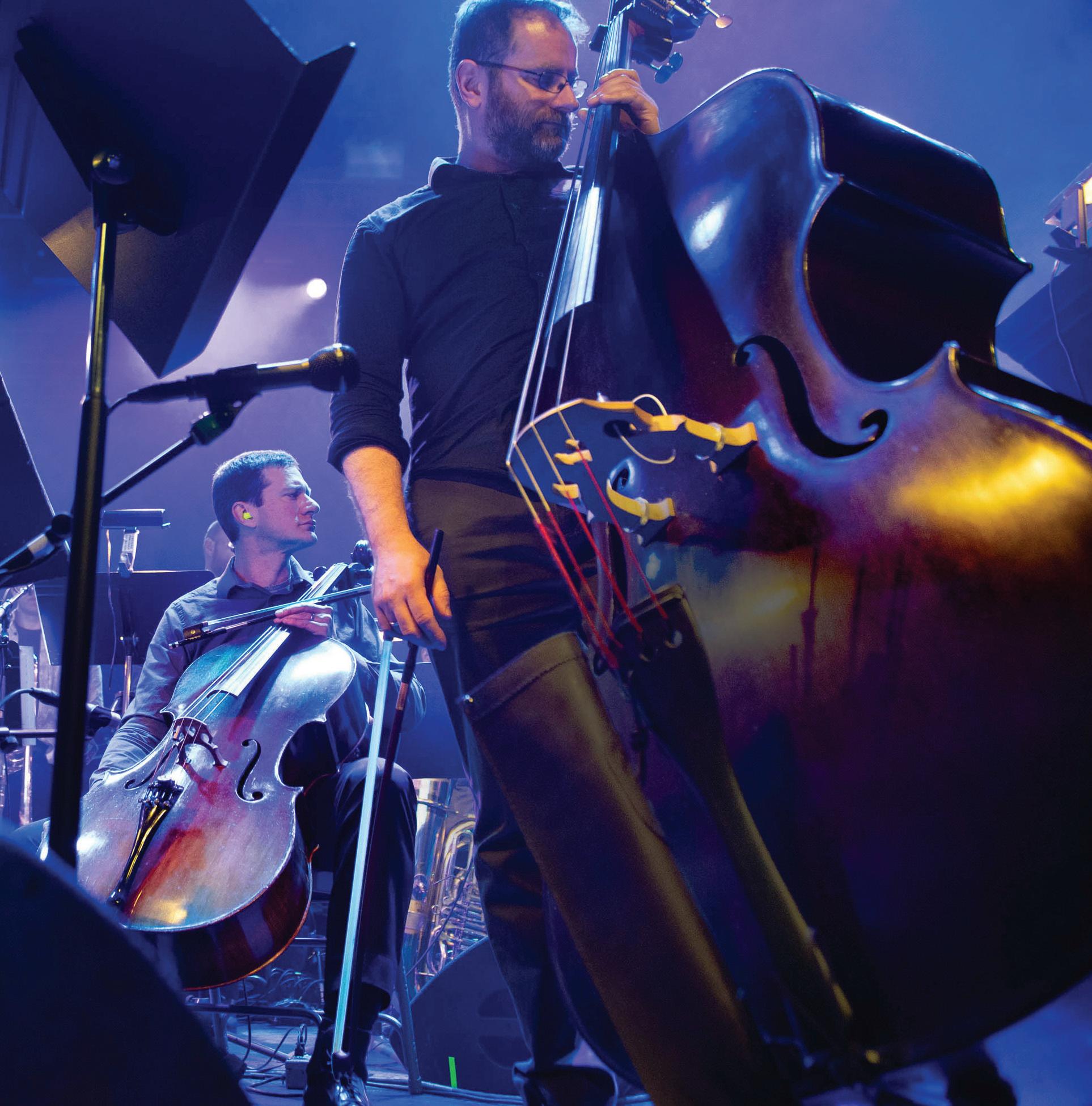
OCTOBER 5, 2023 - CHICAGO READER 39
YOU WANT TO BE HERE Logan Center for the Arts 915 E 60th St • Chicago @loganUChicago logancenter.uchicago.edu/music Alarm Will Sound with Medeski Martin & Wood at Brooklyn Steel for New York’s Winter Jazzfest 2019. Photo: Angelys Ocana / Good People Bad Habits
MUSIC@ LOGAN CENTER:
MUSIC
CHICAGOANS
Manae Solara Vaughn is a young Chicagobased multi-instrumentalist and sound engineer who put down roots in the local music scene much earlier in her life than most of her peers. Daughter of Chicago house-music royalty DJ Lady D, Solara Vaughn grew up immersed in her parents’ community of music legends. She recently left her job at Reverb, a Chicago-based online instrument marketplace, to work as an assistant engineer at Chicago Mastering Service.
Solara Vaughn plays in several bands—she drums for Tenci and for my group, which performs under the name Debbie-Marie Brown, and she plays guitar and synthesizer for Harvey Waters. She also has a solo project, but her
main focus is cultivating her band Oux, which she founded in early 2018 with her partner Indigo Hope Finamore. Oux also includes Arya Woody on bass and synthesizer and Alaska Jules on drums.

Solara Vaughn earned a BA in music theory and composition from Columbia College Chicago after spending a year at Whittier College in California, where she met Finamore. She would eventually like to offer her services as a recording engineer to local artists at as low a cost as possible, because she knows that recording can be inaccessibly expensive. “I’m trying to figure out how to give back to the community that gave me so much,” she says.
My mom grew up when the house scene was taking off, when the rave scene was real. Whatever we call raves now is not a fucking rave, at least not the way it used to be, according to my mom—I was never there. But I could feel the reverberations and the aftere ects of that culture, because I was always around my parents’ friends. They were always coming by, taking care of her, taking care of me. I never felt isolated from life. My parents made all the connections that I have benefited from now. Frank Orrall, who’s the founder of Poi Dog Pondering, he’s my godfather.
I started engineering at Columbia College Chicago. When I got to Columbia, my mom had been working there—and still is—as a career counselor. That’s why I went. Otherwise I wasn’t able to a ord college. I was proud to learn about audio and sound at Columbia, especially from Ted Cho who was my boss, a family friend, and also the guitarist of Poi Dog Pondering.
I was on the team for the department of events, production, services, or whatever. It’s called [DEPS, the Department of Exhibitions, Performance and Student Spaces]. I was lucky that I was getting experience that way. In college, you have room to fuck up, get all your mistakes out, and then you get out into the real world and you can make mistakes on the same level as everybody else.
I definitely got all of my mistakes out with Ted. I had interned at this one audio ware-
house called Lakeshore Audiovisual [LSAV] at first, and that gave me a pretty good start out. And another case of classic Chicago nepotism, because Brad De Lisio, who hired me to be an audiovisual technician intern at LSAV, used to live with my parents.
When I was working as a stagehand at college, Louder Than a Bomb would host at Columbia. It was the level where they’d pick their spoken-word semifinalists. The Chicago History Museum would have a conference once a year at Stage 2 at Columbia, and I would work that. The theater department would have an annual performance with the music department, or music students would play in pit orchestras for choirs. I got really used to not having the same thing twice.
I feel like I owe so much of my social likeness to music. Those are the only spaces I’ve been so consistently that you start to know people. That’s just where it all happens and starts.
After college, for a while, production was a very quotidian experience to me—just a way to make money. Audio is such a thankless job in so many ways, especially when you’re just starting out as a stagehand and you’re just trying to get experience. They call you green. They’re also the same 20 white guys. And then maybe a white woman as an engineer. I’m just there sitting, like, well, I need to make money.
There was one time I was working Michelada [Fest] as a stagehand and I got a text in the middle of the day, like, “Can you come substitute?” That was the first time I’d ever
40 CHICAGO READER - OCTOBER 5, 2023 ll
Manae Solara Vaughn onstage with her band Oux
TREJON D’ANGELO
OF NOTE
Manae Solara Vaughn, sound engineer, musician, and cofounder of Oux
“Oux is all about premeditation. Oux is about intention and the execution of the highest tier of artistry that I can aspire to and accomplish.”
As told to DEBBIE-MARIE BROWN
actually gotten to run sound on my own in a venue—the event took place at the Sandlot in Wrigleyville. I got a text because I had been on Facebook adding myself to as many substitute lists as possible. There were Facebook groups where Chicago engineers were looking for folks to fill in as A2s [secondary audio engineers], stagehands, or crew.
I had been working in sound for maybe three, four months at that point, around when I was 20 years old, and I’d never run a show on my own. But I just did it, and I knew how to do it. Another time I worked sound for the Lakeview 5K. I spent a lot of time at Cubby Bear, learning monitors, working monitors, and also doing front of house under my mentors there, Nick Cartwright and Melissa Adams.
I would be remiss to not mention Golden Dagger. I’ve gotten some of my highest compliments and mixed some of my best shows there. Some of the coolest artists I’ve ever seen and gotten to work with were there. I also work occasionally at Gman Tavern, 2019 till now—until some point in time nebulously in the future.
When I decided to pursue audio production, it was as a form of discipline. I was putting myself into musical boot camp so that I could have the focus, the knowledge, and the experience to own the stage. There’s a very di erent energy you bring to a stage when you know how it works. There’s a certain ownership that I feel onstage that I don’t think I would ever have felt had I not worked in audio and done sound for as long as I did. And do.
It’s hard too, because it took up a lot of time in my life. I don’t even consider engineering specifically such a big part of my identity. But in hindsight, they’re all just pit stops, and I needed to refuel at each one of them. And so it’s hard to be diminishing of them, while also acknowledging that there are so many that I’m not mentioning that I can’t remember.
I’ve always been a musician first, and I’m always going to be a musician first. It got to a point after the Dagger fire where I realized I needed to prioritize my musicianship over my engineering. I was becoming known as an engineer, and people were asking me to come and engineer for things, but I wasn’t really getting asked to play as much. And I was starting to get bitter from being behind the board.
My first instruments were my hands and my voice. I would beat on pots and pans, and I would sing. At a certain point, my parents were like, “We’re gonna put you in choir because you can sing.” And I was
like, “I don’t know I can sing, but OK.” I was in the Chicago Children’s Choir [now Uniting Voices Chicago] from when I was like six till I was ten or 11.
But I was also defiant as a child. I would say, “I’m not going to be a musician,” because my parents were broke, and I watched them be broke for years. They were broke broke. So I felt, no, I’m gonna do something that actually makes me money.
There were so many things I wanted to do musically because I saw and heard people doing them and I thought they were so cool. But I also realized that I didn’t have access to these [opportunities] in the ways I saw my peers did. My parents had this cultural capital, but not any actual capital.
When I finally decided in eighth grade, “OK, I’m going to switch from chorus to band and play the trumpet,” I received my first trumpet from Max Crawford, the trumpet player of Poi Dog Pondering, since my mom couldn’t a ord to buy me one.
It was that same time that I made this personality shift. I got into punk rock and skateboarding like the prototypical 13-year-old, and I was like, I guess I’ll learn guitar now. I had a MacBook and GarageBand, and so I just took the free lessons and I did fucking every single one of them.
I had been doing them for about four to five months by the time Christmas came around freshman year in high school. My mom was like, “OK, you’ve been practicing. I’ve seen you, I hear you, you’ve earned me spending the money on an electric guitar for you.” I wanted a white Strat like Jimi Hendrix. . . . That Christmas she got me a guitar. It was the $200 Squier version, but it was badass. Around that time I also hyperfocused on learning bass guitar, to get good enough to replace the graduating senior bassist in my high school jazz band.
I found out about this little group called DIY Chicago on Facebook, and then I found my first actual band through DIY Chicago. The band was called Vaguewaves. I had been in that band untiI I graduated high school in 2014. We played all the old DIY circuit. There was a place called Wally’s World that we played, and Old Mount Happy. We came around just after Animal Kingdom had died. There was the old-school Humboldt Park/Logan Square DIY scene. . . . Oh my God, there was Jurassic Park, the worst place ever—it was literally predatory, but we played there. It was so scuzzy.
It was so grimy everywhere I played, and it was unsafe in so many ways. But I felt safe. I felt safer there, at those kind of shows, than
OCTOBER 5, 2023 - CHICAGO READER 41
Let’s Play! Make time to learn something new with music and dance classes at Old Town School! We offer flexible schedules for all skill levels both in-person and online. oldtownschool.org Sign up for classes today at MUSIC CLASSES FOR ADULTS & KIDS LINCOLN SQUARE LINCOLN PARK SOUTH LOOP & ONLINE OTS_1_2V_ClassAd_072921.indd 1 7/23/21 2:21 PM MUSIC
MUSIC
continued from p. 41
I did at school, sometimes. Actually, all the time, because I didn’t feel safe at school, socially.
I ended up playing in this band called the Oxford Comma with my friend from Evanston, Noah. I also played in Fox Room with Noah and in Noah’s solo project as Noah Roth & the Magpies.
Anybody that was around that scene at the time would have seen Nnamdï playing everywhere, in so many di erent projects and bands. He was also putting out music all the time. I was surrounded by all of these great people who were young, putting out music all the time, and playing everywhere all the time. So I realized, oh, so in order to be a musician, you have to do this all the time. You can’t really let up.
Iwasn’t musically focused at all at my first college, Whittier College in California, until I eventually transferred to Columbia. I couldn’t a ord being at that first college, and the administration was coming down on me for not being able to a ord it.
I thought to myself, if I’m going to have to leave here at the end of the year, I might as well make a mark. Let me find the musicians, and let me make one thing happen. And that one thing was the battle of the bands the school had every year to determine which student band would play their end-of-year college fest. So I was like: Who’s the best singer on the campus? Who should be the bassist? Who’s the drummer? I found them, and we had a chillin’ seven-piece including a trumpet, saxophone, and a trombonist. We won the battle of the bands, and we opened the end-of-year college fest for T-Pain.
At the same time, I met Indigo as I was leaving campus, but we knew we had to be with each other. It was kismet in so many ways. I had flown out to Indi for winter break—a Christmas-to-New Year’s type of deal. And that was when we wrote our first song as what was going to become Oux. I was fucking around on Ableton trying to make something, and Indigo was like, “I got lyrics!” And then we just made it.
Once Indi moved to Chicago with me, we got around to finishing our EP Honeymood in summer 2019 and putting it out. All of those, I think except “Mood,” the last song on that release, were pretty much all Indi, with the exception of my production and adding a little percussion stu and some guitar. I’ve wanted to let Indi lead the bus more and more for
songwriting since then. The album that we’ve been working on since 2019 is like 11 of Indigo’s songs and two of mine.
We put out Honeymood, and then we were playing a lot of shows locally. It’s weird when you’re a duo with a laptop doing all your backing tracks and you’re both playing guitar and singing. Being a visible face of a project in tandem with them was so formative.
Over the course of the pandemic, we were playing livestreams as a duo from our living room, and it was basically the same thing. But we could put our music through the Internet speakers, so it sounded really good. Not that we didn’t sound great before, but I think it made us appeal to people in a way that we hadn’t been appealing to them before.
Oux got attention on Twitter at first, and then we got put on the [Spotify] Best NonBinary Artists of 2020 playlist at the end
of that year. That blew up one of our songs, “Queer Like Me,” to an extent—we got a lot of streams on that song. And so once we got back to being able to play live shows, we had people showing up to them. We were like, well, if we’re gonna have people show up to a show, we should have a band, with drums and a bassist.
We tried to book as much as we could, and we got asked to play some really incredible shows. We played a sold-out show with Glass Beach at Subterranean, upstairs.
We played Wicker Park Fest and Logan Square Arts Festival last year. We did Cultivate Fest this year. We also played in Virginia at William & Mary’s end-of-year college fest.
Throughout all this, I was moonlighting for a lot of folks, just playing occasional shows or being in bands for very short periods of time, and then they would fizzle out. Or peo-
ple asked me to fill in for shows, and then we would play a few. Being a gigging musician, I felt that whatever I can do to keep my chops up and keep my face out there, I’d do, and I still do.

But I’m so, so deeply invested in the future of Oux in ways that can’t be disentangled from the love of my life and my career. They’re intrinsically linked in such a deep way. I’ll be out there and be around the scene, but Oux is all about premeditation. Oux is all about intention and the execution of the highest tier of artistry that I can aspire to and accomplish.
All the sounds really start in the DAW [digital audio workstation]. It’s very much a recording-based band and project; it always begins with us fucking around in Ableton. But then we know that it can go in so many di erent directions—that can be acoustic music, that can be electronic music, that can be improvised—if you figure it out. It can be highly composed as well. I’m pulling from places of deep electronic production, synthesis, microsound, and ASMR-type musics. Crate-digging sampling!
I would like to shout out our homie Shravan Raghuram, who has seen Oux and was like, “You’re very much trying to make headphone music, but live.” That stuck with me. Our sound is a very immersive, all-enveloping type of music.
Getting myself into the discipline and profession of audio was my gateway into having Oux become what it is, because it’s so much about pushing sonic limits. It takes a certain focus that’s hard to maintain consistently. It was the drive to become an engineer that made all of this possible. I wouldn’t have known how to make the songs as good as they can be. I wouldn’t know the di erence between something good and something great.
Now I’m an assistant engineer at Chicago Mastering Service, being mentored under Greg Obis and Bob Weston. Mastering is such a unique part of the music-creation process, and also so vital—it’s the end stage. It’s also the most meticulous. Mastering is really the culmination of all of my work as both a musician and an engineer, to be able to contribute to such a pedigree of quality and musical artistry. Making music with the end goal in mind is something that I feel really misses people. It’s helped me focus more on: What does my life look like when I’m focused on completion? What does my life look like when I’m focused on finishing? v
42 CHICAGO READER - OCTOBER 5, 2023 ll
Manae Solara Vaughn performing with the band Harvey Waters RICARDO ADAME
dmbrown@chicagoreader.com
m
THE SALT SHED THE SALT SHED THE SALT
SHED THE SALT SHED THE SALT SHED THE SALT SHED THE SALT SHED THE SALT SHED THE SALT SHED THE SALT SHED THE SALT SHED THE SALT SHED THE SALT SHED THE SALT SHED

THE SALT SHED THE SALT SHED THE SALT SHED THE SALT SHED THE SALT SHED THE SALT
SHED THE SALT SHED THE SALT SHED THE SALT SHED THE SALT SHED THE SALT SHED THE SALT SHED THE SALT SHED THE SALT SHED THE SALT SHED THE SALT SHED THE SALT SHED THE SALT SHED THE SALT SHED THE SALT SHED THE SALT SHED THE SALT SHED THE SALT SHED THE SALT SHED THE SALT SHED THE SALT SHED THE SALT SHED THE SALT SHED THE SALT SHED THE SALT SHED THE SALT SHED THE SALT SHED THE SALT SHED THE SALT SHED THE SALT SHED THE SALT SHED THE SALT SHED THE SALT SHED THE SALT SHED THE SALT SHED THE SALT SHED THE SALT SHED THE SALT SHED THE SALT SHED THE SALT SHED THE SALT SHED THE SALT SHED THE SALT SHED THE SALT SHED THE SALT SHED THE SALT SHED
THE SALT SHED THE SALT SHED THE SALT SHED THE SALT SHED THE SALT SHED THE SALT SHED THE SALT SHED THE SALT SHED THE SALT SHED THE SALT SHED THE SALT

& the sniffers

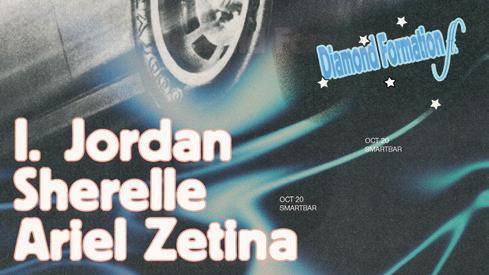


OCTOBER 5, 2023 - CHICAGO READER 43 3730 N CLARK ST METROCHICAGO.COM @METROCHICAGO SMARTBARCHICAGO.COM 3730 N CLARK ST | 21+ SAT OCT 07 Viva Acid welcomes ERIS DREW CIEL SEVRON THUR OCT 12 Inferno ft. GLAMOUR CADAVER CTRLZORA FLORES NEGRAS FRI OCT 06 HORSE MEAT DISCO SHAUN J WRIGHT SOFT KILL PELICAN NIGHTLY CLOWN CORE OCT 21 OCT 24 OCT 25 OCT 26 Laid Back | Cold Beer | Live Music @GMANTAVERN GMANTAVERN.COM 3740 N CLARK ST 21+ FRIDAY OCT 06 / 8PM / ALL AGES RAISED BY WOLVES TOUR KENNYHOOPLA + Groupthink / Footballhead TUESDAY OCT 17 / 8PM / 18+ SEXTILE + N8NOFACE SATURDAY OCT 07 / 8PM / 18+ VNV NATION + Traitrs MON OCT 16 METRO & 1833 PRESENT PERISH BLUE TOUR TOBI LOU + grouptherapy. SUN OCT 08 ARKELLS + Robert DeLong THU OCT 12 EVERYTHING EVERYTHING + Pierre Kwenders TUE OCT 10 YEULE + SASAMI SUNDAY OCT 15 / 7:30PM / ALL AGES NATION OF LANGUAGE + Miss Grit WEDNESDAY OCT 18 / 8PM / 18+ TIRZAH THURSDAY OCT 19 / 8PM / 18+ DIVINO NIÑO + Victor Internet / Heartgaze FRIDAY OCT 20 / 7:30PM / ALL AGES 8TH WONDER TOUR THE NATIONAL PARKS + Zach Seabaugh THE SALT SHED THE SALT SHED THE SALT SHED THE SALT SHED THE SALT SHED THE SALT SHED THE SALT SHED THE SALT SHED THE SALT SHED THE SALT SHED THE SALT SHED THE SALT SHED THE SALT SHED THE SALT SHED THE SALT SHED THE SALT SHED THE SALT SHED THE SALT SHED THE SALT SHED THE SALT SHED THE SALT SHED THE SALT SHED THE SALT SHED THE SALT SHED THE SALT SHED THE SALT SHED THE SALT SHED THE SALT SHED THE SALT SHED THE SALT SHED THE SALT SHED THE SALT SHED THE SALT SHED THE SALT SHED THE SALT SHED THE SALT SHED THE SALT SHED
SHED THE THE SALT SHED THE SALT SHED THE SALT SHED THE SALT SHED THE SALT SHED THE SALT SHED THE SALT SHED THE SALT SHED THE SALT SHED THE SALT SHED THE SALT SHED THE SALT SHED THE SALT SHED THE SALT SHED THE SALT SHED THE SALT SHED THE SALT SHED THE SALT SHED THE SALT SHED THE SALT SHED THE SALT SHED THE SALT SHED THE SALT SHED THE SALT SHED THE SALT SHED THE SALT SHED THE SALT SHED THE SALT SHED THE SALT SHED THE SALT SHED THE SALT SHED THE SALT SHED THE SALT SHED THE SALT SHED THE SALT SHED THE SALT SHED THE SALT SHED THE SALT SHED THE SALT SHED THE SALT SHED THE SALT SHED THE SALT SHED THE SALT SHED THE SALT SHED THE SALT SHED THE SALT SHED THE SALT SHED THE SALT SHED THE SALT SHED THE SALT SHED THE SALT SHED THE SALT SHED THE SALT SHED THE SALT SHED THE SALT SHED THE SALT SHED THE SALT SHED THE SALT SHED THE SALT SHED THE SALT SHED THE SALT SHED THE SALT SHED THE
23 amyl
WITH SPECIAL GUEST DIE SPITZ
3 LP ..................... THE SHED WITH VÉRITÉ
6 WE ARE
CONCERT
SHED
THE HOLOCAUST
16 OLD CROW MEDICINE
SHED NOV 17 SHAKEY GRAVES
SHED
RAYLAND BAXTER
18
NOV
GALANTIS
NOV
ON SALE NOW
UPCOMING SHOWS OCT
NOV
NOV
HERE
..... THE
SONGS FROM
NOV
SHOW . THE
.......... THE
WITH
NOV
& 19 ALT-J ................... THE SHED WITH MEAGRE MARTIN
22
............... THE SHED
25 THE MENZINGERS ......... THE SHED WITH MICROWAVE, CLOUD NOTHINGS AND RODEO BOYS
Chicago’s Viva Acid fest brings Eris Drew back to town
Recommended and notable shows with critics’ insights for the week of October
THURSDAY5
Rami Atassi’s Cosmic Dance Band This set features guest vocalist Pri Akhil. 8:30 PM, Constellation, 3111 N. Western, $15. 18+
Rami Atassi gets around: he’s a prolific music educator, a guitarist in local alt-rock projects the Curls and Ester, the bandleader of Blow Wind Blow, and a trusted collaborator of Chicago bassist Tatsu Aoki, with whom he recorded 2020’s criminally underrated duo album Atashi Wa Rami . But so far he’s never had the spotlight to himself, at least not on a recording. For all intents and purposes, the brand-new Dancing Together (Ropeadope)— which Atassi wrote and produced with the support of a DCASE grant—is his debut full-length. It’s the most complete look yet into his creative mind, and it’s one hell of a view. Thanks to an exuberant crew that Atassi calls the Cosmic Dance Band, Dancing Together sounds like what might happen if you had a le -field mix of psychedelic and jazz artists—Mdou Moctar, Wes Montgomery, Cave, the Natural Information Society—in your blunt rotation. The heady LP draws on desert rock, acid jazz, Arabic melodic modes, western swing, and (in album standout “Great Plains”) Carnatic music. Toronto-based singer Pri Akhil guests on that song, as she will at this Constellation record-release show.
ERIS DREW’S DEBUT ALBUM , 2021’s Quivering in Time , embeds lots of attention-grabbing details in its collagelike, psychedelic-tinged dance tracks—among them sounds of turntable scratching. There’s one near the end of “Time to Move Close,” after a slyly funky and somnolent synth melody guides listeners through six minutes of HiNRG percussive loops and several divergent synth lines that make the dreamy, bumping track feel endlessly expansive. Drew’s record scratch bursts into the song like a radio alarm clock, though it’s less of an interruption than a sign of surprises to come. In a 2021 Crack Magazine profile, writer Chal Ravens notes the importance of scratching for Drew, who came out as trans in 2015—as part of that process, she challenged not just other people’s perceptions of her but also the limits she’d placed on herself, including a reluctance to physically handle or alter the sounds of her favorite records. Drew’s life in dance music stretches back decades. She was already a committed raver in 1994, when she began mixing records
at age 18—and that same year, she moved to Chicago from the suburbs. She became a regular at Smart Bar, which eventually brought her on as a resident, and in 2012 she cofounded the club’s monthly series Hugo Ball. Her international breakthrough began with a set for Detroit gay party Club Toilet on Memorial Day weekend 2017, during the citywide dance-music festival Movement. These days, Drew lives in New Hampshire with her partner, Maya BouldryMorrison, aka Octo Octa, and together they run the label T4T LUV NRG, which released Quivering in Time . Drew brings a battery of ideas to the immersive, ever-changing album without weighing it down; it feels buoyant and full of life, with a lighthearted sensibility that’ll make you wish it lasted for hours and hours. This Smart Bar set brings Drew back to her old hometown as part of a four-day celebration of acid house, Viva Acid, that also includes workshops and discussions at Q Studios and performances at Emporium Wicker Park and Cerise. —LEOR GALIL


SATURDAY7
—HANNAH EDGAR
Though hardly autobiographical, Dancing Together draws upon Atassi’s experiences as a Syrian American growing up in small-town Ohio. The title track transplants a twanging Americana groove to shamisen and oud (played by Aoki and Ronnie Malley, respectively), while lead single “Yuma Soul’’ takes inspiration from Atassi’s grandfather’s obsession with westerns; Atassi lays down a sun-baked solo over Aoki’s bass and Joie Moon’s dumbek. Leaner numbers such as “Garden Song” (a glowing duet with harmonica player and Blow Wind Blow front man Ryan Suzuka) and “San Cristobal” (where Atassi layers a brooding slide-guitar solo over Caleb Willitz’s ambient synths) also sound full to bursting. Fall might have just begun, but I’ll be damned if Dancing Together isn’t already a strong contender for my favorite debut of the season; it’s undoubtedly one of my favorites of the year.
Eris Drew See pick of the week at le . 10 PM, Smart Bar, 3730 N. Clark, $25, $20 in advance. 21+
Get Smart! The 13 Tikis headline; Get Smart! and Jeff Lescher of Green open. 9 PM, Liar’s Club, 1665 W. Fullerton, $16.50. 21+
If it hadn’t been for the COVID pandemic, powerpoppy Kansas punk trio Get Smart! would’ve played a 40th-anniversary show—their first gig in three decades—in November 2020. That date ended up pushed back to November 2021, and luckily for us, it didn’t turn out to be a one-off affair. The band formed in Lawrence in 1980 and built a loyal local following with a mischievous, minimal style flavored by Lisa Wertman Crowe’s wiry, funky bass and Marc Koch’s pent-up guitar. In 1983 they moved to Chi-
44 CHICAGO READER - OCTOBER 5, 2023
PICK OF THE WEEK
MUSIC
ERIS DREW, CIEL, SEVRON
Sat 10/7, 10 PM, Smart Bar, 3730 N. Clark, $25, $20 in advance. 21+
DESMOND PICOTTE
5 b ALL AGES F
cago, which had bigger punk, new wave, and postpunk scenes and promised them new audiences and more potential to grow. Get Smart! soon hooked up with Enigma Records, which released their only two proper full-length albums: Action Reaction came out via Enigma imprint Fever in 1984, and 1986’s Swimming With Sharks followed on the Restless imprint in 1986. When Get Smart! broke up in 1990, they had unfinished business—specifically, a shelved third album they’d started recording in 1987 with Chicago-based punk producer Iain Burgess. In November 2020, just a few days after they’d planned to return to the stage, Get Smart! issued that unreleased material as a six-song EP called Oh Yeah No . Drummer Frank Loose propels the trio down leisurely pathways, his brisk but restrained tempos hinting at the speed the band have in reserve, and Wertman Crowe and Koch’s sweetly shabby vocal melodies emphasize the touch of lilting country in the music. Get Smart! also appear on an upcoming five-CD punk retrospective, whose continent-spanning roster includes fellow midwesterners Devo, the Pagans, the Electric Eels, and the Gizmos: in November, UK label Cherry Red will include their sawed-off punk-funk song “This Is Style” on Blank Generation: A Story of U.S./Canadian Punk & Its A ershocks 1975-1981. The reunited Get Smart! rarely play out, and if you need another reason to get yourself to Liar’s Club, think of this gig as a piece of history—a celebration of the 40th anniversary of the band’s move to Chicago. —LEOR GALIL
SUNDAY8
Marina Herlop 8 PM, Sleeping Village, 3734 W. Belmont, $18, $15 in advance. 21+
Marina Herlop’s primary interest is aesthetics. She’ll say her songs aren’t autobiographical, and the pianist’s penchant for dropping made-up language into digitally manipulated audio environments can make it difficult for listeners to ground her work in something familiar. But with enough scrutiny, you can follow clues that situate her evolving output within a number of personal anecdotes—say, growing up in Catalonia, living through a climate crisis, or falling in love with Romantic composers such as Claude Debussy. But you don’t need those facts—or any facts, really—to appreciate Herlop’s intricately brocaded songs. You’ll just experience them slightly differently if you do.
Herlop, whose stage name condenses her government surname “Hernández López,” traffics in an avant-garde art-pop tradition shared by artists such as Lyra Pramuk and Björk. Her work is as organic, precise, and beautiful as it is otherworldly, tangled, and fraught. Herlop is fascinated by music as a universal language that can express something beyond words, and her albums borrow as much from her formal training in Western classical music as from her investigations into cross-cultural classical traditions, including Carnatic music from southern India. To promote her third record, Pripyat, released last year through Berlin-based cult electronic label Pan, she used photos of herself in a barren desert, wearing a soft pink latex cheongsam and coiffed Princess Leia buns connected by chains. She insistently beckons onlookers into her inner world,
where she aspires to beauty in an imagined multicultural future where aesthetics can exist in a vacuum. This tour is in support of Herlop’s upcoming fourth album, Nekkuja, which comes out October 27.
—MICCO CAPORALE
THURSDAY12
Civic Ganser open. 9 PM, Empty Bottle, 1035 N. Western, $17. 21+
All sorts of classic American and British punk and garage rock have been revived and revived again to the point of cliché, but foundational Australian groups such as Radio Birdman, the Lime Spiders, the Scientists, and the Celibate Rifles still often go unsung outside their home country. Thankfully, rising artists from down under are connecting past to present and proving that rock ’n’ roll can still ignite the hearts of new generations of fans.
Among the most exciting of the bunch are Civic, a five-piece that emerged from Melbourne in 2017. They released three EPs before catching ears with their full-length debut, 2021’s Future Forecast , which nods to the Dead Boys and the Saints with its noisy ooze of adrenaline-soaked melodies and grimy swagger. For their second record, February’s Taken by Force (ATO), they trekked out to rural Victoria, where they spent a week recording in a town of 500 people with producer Rob Younger, better known as front man of Radio Birdman and the New Christs. That dislocating experience, combined with the band members’ ruminations on a postapocalyptic world, give the album a sense of haunted urgency. “We really felt like we were living this record,” lead vocalist Jim McCullough told NME “I know that sounds a bit lame, but I really believe it. Existing in this space for such an intense period of time . . . it was almost like it was out of a play or something.” Certainly the triumphant, surfy “Born in the Heat” and the cool, leather-cloaked “Neighborhood Sadist” have an enticing narrative quality,
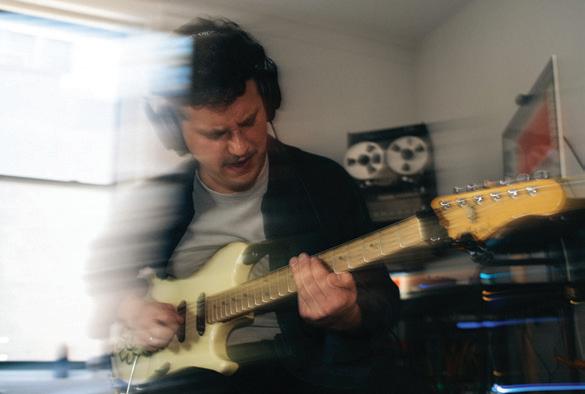
but you don’t have to hang on every word to enjoy the action. Civic show their romantic side on “Blood Rushes,” a dreamy indie-rock ode to new love, and “Taken by Force” borrows so much from Radio Birdman’s “I-94” that it nearly crosses the line from homage to remake. No matter where Civic get their inspiration, their tight songwriting and overflowing energy make them feel like the next step in a progression rather than a re-creation. This show is part of the Civic’s first full U.S. tour, and arrives days before the October 20 release of a compilation record that combines their early singles with the 2018 EP New Vietnam . Unless you’re watching Aussie pub-rock greats Cosmic Psychos rip it up at the Vic, you’re going to want to be there.
—JAMIE LUDWIG
The Chats, Cosmic Psychos The Chats headline; Cosmic Psychos, the Schizophrenics, and Gymshorts open. 6:30 PM, the Vic, 3145 N. Sheffield, $25-$48. b
It’s rare for Chicago to have even one noteworthy Australian punk show, much less two in one night— the necessity to choose between them is an excellent problem to have. While protopunk five-piece Civic play the Empty Bottle with local postpunks Ganser, Queensland upstarts the Chats headline this package tour at the Vic. Formed in 2016, the trio have developed international buzz with two albums of bare-bones, snotty punk, including last year’s Get Fucked (Bargain Bin). But given their devotion to previous generations in Australian punk and hard rock, they’d probably be the first to tell you to make a priority of seeing their tourmates, Melbourne legends Cosmic Psychos, who are in the midst of celebrating their 40th anniversary.
The group evolved out of the band Spring Plains and developed a distinctive sound that fused several loud-and-fast influences—Motor City protopunk, the heyday of the CBGB scene, 80s hardcore—into blistering, fuzzed-out punk and pub rock. Manual labor became a running motif in their songs about daily life, good times, and boozing, and their sound is heavier than the construction machinery and farm equipment that turns up in their records. Their songs are gritty as fuck and twice as fun, and their early records (released in the States on Sub Pop and Amphetamine Reptile) captured the hearts of underground rockers far and wide. They directly influenced the burgeoning grunge and alternativerock scenes in the U.S., making fans of the likes of Nirvana, Mudhoney, Pearl Jam, and L7 (whose 1994 track “Fuel My Fire” riffs on the Psychos’ “Lost Cause”), but even today many of their records sound timeless, not like products of a specific era. The band’s lineup remained consistent from 1990 through 2005, when founding drummer Bill Walsh left, and in 2006 longtime guitarist Robbie Watts passed away while on tour. Cosmic Psychos’ current lineup—founding vocalist and bassist Ross Knight, drummer Dean Muller, and guitarist John McKeering—has remained solid ever since. Their 11th studio album, 2021’s Mountain of Piss (whose cover pictures the trio’s faces on a beer-can Mount Rushmore), maintains the band’s sense of humor while nodding at their own vintage with tracks such as “Accountant Song” and “Too Old to Drink in Pubs.”
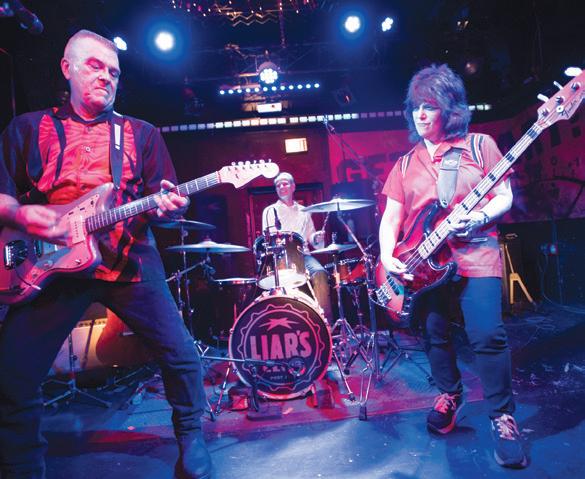 —JAMIE LUDWIG
—JAMIE LUDWIG
OCTOBER 5, 2023 - CHICAGO READER 45
MUSIC
Rami Atassi COURTESY THE ARTIST
Get Smart!
PAUL NATKIN
FRIDAY13
Astral Autumn Daze night one See also Sat 10/14. Damon & Naomi headline; the Powers/Rolin Duo and Spiral Galaxy with special guests open. 8:30 PM, Hideout, 1354 W. Wabansia, $18, $30 both nights. 21+
Steve Krakow can’t be pinned down to one pursuit or even one name, and when he plans a festival, it creates its own niche. He performs music under the name Plastic Crimewave; he writes and draws about music for the Reader and his own publication, the Galactic Zoo Dossier; and he’s been organizing eclectic events since 2004, when he launched the first Million Tongues Festival. While some of Krakow’s fests have proposed an open-minded vision of psychedelic music, the lineup of Astral Autumn Daze feels more like a response to the season than an aesthetic prescription. Across its two nights you can expect to hear mind-altering sounds, grooves moving enough to banish encroaching chills, and singers whose reflective verses lean into a vibe of seasonal melancholy.
Friday commences with locals Spiral Galaxy, a funky combo with a predilection for playing vintage Ethiopian melodies. Their usual two-piece lineup (Krakow on guitar and keyboard and Sara Gossett on flute) will be augmented by Drazek Fuscaldo (the duo formerly known as Mako Sica) on trumpet and bass, percussionist Jose Bernal, guitarist Matthew Rolin, and hammered dulcimer player Jen
Powers, so it’s anyone’s guess where the jams might wander. The Ohio-based Powers/Rolin Duo (both of whose members are joining Spiral Galaxy) specializes in cascades of string resonance and openended melody. And Damon & Naomi, who’ve been cra ing pensive, poetic songs together ever since the demise of their dream-pop trio Galaxie 500 in 1991, will come to Chicago for the first time since the 2021 release of their latest album, A Sky Record On the second night, Aaron Dooley, a bassist from Bloomington, Illinois, will perform instrumental Americana. Tekla Peterson is the one-woman synthpop alter ego of Taralie Peterson, who shares lead vocals and plays a mix of instruments in local psychfolk outfit Spires That in the Sunset Rise. Skokiebased fingerstyle guitarist Charlie Schmidt, who rarely gigs out anymore, will play the music of John Fahey, for which he’s uniquely qualified; Fahey once pranked a record label by tapping Schmidt to rerecord his tunes and pass them off as his own work. And singer-songwriter Kath Bloom, who enjoyed one brief flash of aboveground visibility in her 45-year career when filmmaker Richard Linklater used her song “Come Here” in the 1995 movie Before Sunrise, will perform her introspective reveries with gifted guitar picker David Shapiro. —BILL MEYER
Botch See also Sat 10/14. Facs and Sweet Cobra open. 8 PM, Metro, 3730 N. Clark, $50, $45 in advance. 18+
When mathy metalcore bands such as the Dillinger Escape Plan, Converge, and Coalesce reigned supreme in the late 90s and early aughts, no one
struck a balance between proggy virtuosity and hardcore aggression quite like scrappy Tacoma upstarts Botch. Formed in 1993 and disbanded in 2002, the four-piece never reached the crossover popularity of those peers, but more than anyone else they tapped into something manic and primal. With their complex syncopated rhythms, acrobatically dissonant guitar riffs, and unhinged vocal shredding, Botch were part cathartic, part impossible to wrap your mind around.
Following their breakup, Botch’s members found success with new projects. Guitarist David Knudson formed tappy technical indie-pop outfit Minus the Bear, while bassist Brian Cook went on to play in more incredible bands that I can remember—These Arms Are Snakes, Russian Circles, and Sumac come to mind. These subsequent projects helped Botch’s posthumous reputation for greatness grow; they became the best band you’d never seen, and among music critics, reinvestigations and rediscoveries of their two fulllengths, 1998’s American Nervoso and 1999’s We Are the Romans (both on Hydra Head), ran rampant.
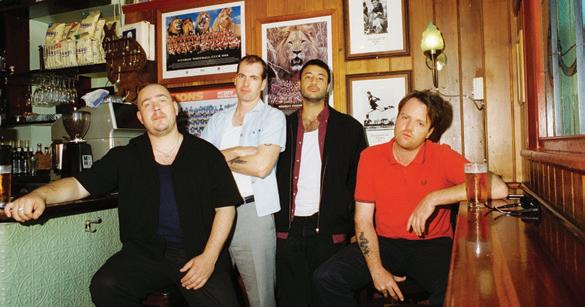
After Minus the Bear split up in 2018, Knudson began posting Instagram videos of himself dusting off Botch’s topsy-turvy guitar riffs, causing the reunion rumor mill to accelerate from zero to 60. Then last year—seemingly out of nowhere—Botch dropped their first new song in two decades, “One Twenty Two,” a grimy throwback to their outsidethe-box take on heavy metal. And just like that, Botch were back together and once again firing on all cylinders. A er a couple shows in Seattle over the winter, they hit the road this month with a fullscale reunion tour. Back in the day, they used to play all-ages gigs at the grubby but lovable Fireside
Bowl, so these two Metro dates ought to feel like a luxurious welcome back. —LUCA
CIMARUSTI
Genesis Owusu Godly the Ruler opens. 9 PM, Thalia Hall, 1807 S. Allport, $22, $30 balcony, $270 opera box (seats six). 17+

Popular music has plenty of upbeat anthems that celebrate the performer’s beauty and success— think Beyoncé’s “Irreplaceable” or Olivia Rodrigo’s “All-American Bitch.” It also has lots of downbeat paeans to the performer’s pitifulness, a la Beck’s “Loser” or Radiohead’s “Creep.” Much less common are enthusiastic, danceable tracks that boast of the singer’s ugliness and smallness, which is what makes Genesis Owusu’s music such a lumpy, boisterous joy: his brilliant 2021 debut, Smiling With No Teeth (Ourness/ House Anxiety), encapsulates this approach, celebrating imperfection as funky, busted-up defiance. Owusu’s 2023 sophomore record, Struggler (Ourness/AWAL), is a bit less distinctive and confrontational than Smiling With No Teeth. Even so, there’s no shortage of awesomeness, such as the lighthearted disco perversion of “That’s Life (A Swamp),” where he sings “Paint me, artisan, the color of sleaze / Puncture me with holes, the boy becomes breeze.” The Metamorphosis -channeling boogie “The Roach” opens with a squall of feedback and name-checks Franz Ka a, but it isn’t an exercise in existential despair. “I’m tryna break free with a penciled stanza / So are we human or are we dancer?” he raps. Liberation isn’t easy, but if you’ve been turned into an insect, Owusu insists, then you’ve got more legs to dance with.
 —NOAH BERLATSKY
—NOAH BERLATSKY
46 CHICAGO READER - OCTOBER 5, 2023
Find more music listings at chicagoreader.com/musicreviews
MUSIC
Marina Herlop ANGELO GUTTADAURO
Civic ROBYN DALY
continued from p. 45
Genesis Owusu BEC PARSONS
SATURDAY14
Astral Autumn Daze night two See Fri 10/13. Kath Bloom headlines; Charlie Schmidt, Tekla Peterson, and the International Disassociation of Aaron Dooley open. 8:30 PM, Hideout, 1354 W. Wabansia, $18, $30 both nights. 21+
Botch See Fri 10/13. Facs and Rezn open. 8 PM, Metro, 3730 N. Clark, sold out. 18+
MONDAY16
Draag Me Chanel Beads open. 9 PM, Empty Bottle, 1035 N. Western, 21+
In 2021, Twitter user Benjamin Deshawn Hoard posted a photo of himself looking glum and out of sorts while sitting on a replica of SpongeBob Square Pants’s bed. His caption read, “I Shoulda Never Smoke That Shit Now Im At Spongebob House.” That joke launched a meme, where other posters would superimpose Hoard onto increasingly absurd new backgrounds. Know Your Meme has cataloged some of the best—I particularly like the one where Hoard, having smoked that shit,

MUSIC
fi nds himself replacing bassist Matt Sharp on the cover of Weezer’s Blue Album. The wacky dislocations that make the meme funny have also provided me with a visual language to describe the feeling I get when I listen to the stylistically madcap music of Philadelphia experimental pop duo Draag Me—a delirious mixture of disorientation, sadness, and wonder.
Draag Me grew out of trippy, cockeyed Philly indie-rock band Spirit of the Beehive: vocalist and multi-instrumentalist Zack Schwartz was working on material too loose and strange for that group, and he launched Draag Me as a solo project with the hazy 2020 album I Am Gambling With My Life Since then, his Spirit of the Beehive bandmate Corey Wichlin has joined him in Draag Me, giving the music a little more structure and injecting new energy into its bonkers twists and turns. The songs on the August album Lord of the Shithouse (Doom Trip) careen downhill like an avalanche that sweeps up everything in its path—they might plow through trippy echoing synths, upbeat disco rhythms, and unsteady indie-rock singing. “Like a Nuisance” features all those elements, plus an increasingly urgent minute-long verse by Chicago rapper CRASHprez— one of a handful of guests whose sudden appearances unexpectedly reorient Draag Me’s music like a magician yanking a tablecloth out from under a full dinner setting. It’s just as shocking that Draag Me somehow stay grounded while teetering on the brink of chaos. —LEOR
GALIL v

OCTOBER 5, 2023 - CHICAGO READER 47
Tekla Peterson (aka Taralie Peterson of Spires That in the Sunset Rise) performs at Astral Autumn Daze on Saturday, October 14. COURTESY THE ARTIST
EARLY WARNINGS
UPCOMING CONCERTS TO HAVE ON YOUR RADAR
b ALL AGES
Early Warnings newsletter: sign up here

BEYOND
SUN 12/3
Mariah Carey 7:30 PM, United Center b
Gyasi 8 PM, Beat Kitchen, 17+
Geddy Lee: My Effin’ Life in Conversation 8 PM, Auditorium Theatre b
Over the Rhine 7 PM, Maurer Hall, Old Town School of Folk Music b
OCTOBER
THU 10/19
Boys Like Girls, State Champs, Summer Set, Lolo, Every Avenue 7 PM, Aragon Ballroom, 17+ Free Range, Sima Cunningham, Hazel City 9 PM, Empty Bottle
FRI 10/20
Main Squeeze, Braxton Cook, Rich Ruth 8:30 PM, Thalia Hall, 17+
FRI 10/20
Macie Stewart Mouth Full of Glass Orchestra, Damon Locks & Dana Hall 7:30 PM, Epiphany Center for the Arts
SAT 10/21
The Last Soul Summit Party featuring Soul Summit DJs 9 PM, Empty Bottle
TUE 10/24
Don Broco & the Home Team, Skyler Accord, Color 8 6 PM, the Vic b
FRI 10/27
Deadmau5, Spencer Brown, Volaris 10 PM, Radius, 18+
The Faint (DJ set), Dark Wave Disco DJs (Greg Corner and Echodroides), Rafaleux 10 PM, Smoke & Mirrors
SAT 10/28
Deadmau5, Ben Hemsley, Volaris 10 PM, Radius, 18+
Kings of Convenience 8 PM, the Vic b
Ben Ottewell & Ian Ball of Gomez 8 PM, City Winery b
Wailin’ Jennys 8 PM, Cahn Auditorium, Evanston b
SUN 10/29
Pedro Capó 7:30 PM, Park West b
Faye Webster, Upchuck 7:30 PM, Riviera Theatre b
TUE 10/31
Handlebar’s 20 Year Celebration featuring Pink Frost, Ethers, Aitis Band, Options, and others 9 PM, Empty Bottle F
GOSSIP WOLF
A furry ear to the ground of the local music scene

FOR THE PAST WEEK, Chicago’s indie-rock scene has been mourning the unexpected death of Ryan Deffet , who played guitar and sang in Space Gators and Faux Furrs . Deffet moved here from Dayton, Ohio, and enmeshed himself in the northwest-side underground scene in the 2010s; for years he organized Deff Jam, a DIY festival that presented bands from Dayton and Chicago at shows in both cities.
NOVEMBER
WED 11/1
Sampha 8 PM, the Vic, 18+
Shane Smith & the Saints, Angel White, Calder Allen 8 PM, Thalia Hall, 17+
THU 11/2
Tyla Yaweh 8 PM, Reggies Rock Club, 17+
FRI 11/3
Bruce Cockburn 8 PM, Maurer Concert Hall, Old Town School of Folk Music b
SAT 11/4
Bruce Cockburn 8 PM, Maurer Concert Hall, Old Town School of Folk Music b
Res 7 PM, City Winery b
WED 11/8
Stuck, Spllit, Spread Joy 8:30 PM, Hideout
FRI 11/10
Chicago Asian American Jazz Festival night one featuring Takashi Shallow, Devon Osamu Tipp 8:30 PM, Elastic b
SAT 11/11
Chicago Asian American Jazz Festival night two featuring Hitomi Oba 8:30 PM, Elastic b
THU 11/16
Fire-Toolz, Fruit Looops, RXM Reality, Lipsticism 8:30 PM, Hideout
FRI 11/17
Akon 7 PM, Radius b
DD Osama, Sugarhill Ddot 8 PM, Patio Theater b
SUN 11/19
Maeve & Quinn, Edith Judith 7:30 PM, Hideout
Veeze 7 PM, Avondale Music Hall b
SUN 11/26
Eem Triplin 7 PM, Avondale Music Hall b
THU 12/7
NRBQ 8 PM, SPACE, Evanston b
FRI 12/8
Bea Miller 9 PM, Bottom Lounge, 17+
SAT 12/9
Bea Miller 9 PM, Bottom Lounge, 17+
SUN 12/10
Kiki & Herb 7:30 PM, Park West b
THU 12/14
Estlin Usher 9 PM, Tack Room F
SAT 12/30
Lemonheads, Kiwi Jr. 8 PM, SPACE, Evanston b
SUN 12/31
Lemonheads, Kiwi Jr. 9 PM, SPACE, Evanston b
FRI 1/26/2024
Magic City Hippies 8 PM, the Vic, 18+
SAT 2/3/2024
Mayer Hawthorne 7:30 PM, Park West b
WED 2/21/2024
Burna Boy 7:30 PM, Wintrust Arena b

SAT 2/24/2024
Ericdoa, Bixby 6:30 PM, Bottom Lounge b
TUE 3/5/2024
Ricky Montgomery 7:30 PM, Riviera Theatre b
THU 3/7/2024
Two Door Cinema Club, Joywave 7:30 PM, Riviera Theatre b
FRI 3/8/2024
Marca MP 8 PM, Allstate Arena, Rosemont b
THU 3/14/2024
Ministry, Gary Numan, Front Line Assembly 7 PM, Aragon Ballroom, 18+ v
Footballhead main man Ryan Nolen met Deffet at the Mutiny in 2016. “He was someone who I could tell I wanted to be more like,” Nolen says. “That was pretty instant— he had this cool Britpop swagger about him. I could tell almost immediately, from his guitar playing and his performance, that he was much more cultured than I ever will be. Ryan brought the house down that night and every fucking show after that too.” In 2018, Deffet asked Nolen to play guitar in Faux Furrs. “Ryan’s my olive branch to everyone,” Nolen says. “He’s the reason why I do anything. There’s no Footballhead without Ryan.”
Nolen describes Deffet as an organized and prolific collaborator. “Ryan is one of those guys who squeezed the hell out of 24 hours in a day, but he really needed 25 to get all his passions and creativity completed,” he says. “Because he was that talented and that inspired.” Deffet finished a new Space Gators album last month, but he never sent the audio files to Doug Malone at Jamdek Recording Studio for final mixing and mastering.
Last week, a friend of Deffet’s launched a GoFundMe to benefit his parents, brother, and fiancée, and it surpassed its initial $20,000 goal within 24 hours. The outpouring of love for Deffet doesn’t surprise Nolen—he’s seen his friend light up the faces of complete strangers with his encouragement. “One of the phrases he commonly used when meeting new people, he would say, ‘Everybody’s a space gator,’” Nolen recalls. “They’d say, ‘I can’t dance, I can’t sing, I can’t play the tambourine, I can’t fucking hit a bongo.’ Ryan would want you onstage—because everybody’s a space gator.”
AFROFUTURIST WEEKEND , an annual festival presented by Elastic Arts , is always among the most anticipated events on Gossip Wolf’s music calendar. The eighth weekend in the series runs for a jam-packed five days, from Wednesday, October 4, through Sunday, October 8. Too much is happening to fit it all in this column, but even a few highlights should make a strong case! Shan-
ta Nurullah and DJ Rae Chardonnay perform at a kickoff event on Wednesday, October 4, at FourtuneHouse Art Center in Bronzeville. El La Katrina and Fabulous Freddie host an Afrofuturist Ball on Friday, October 6, that includes DJ sets, a panel discussion, and a fashion show. On Saturday, October 7, soundtrack composer and sound artist Robert Aiki Aubrey Lowe shares a bill with a trio of flutist Nicole Mitchell , filmmaker and animator Jonathan Woods (cofounder of the Afrofuturist Weekend), and drummer Grover Stewart . On the a ernoon of Sunday, October 8, Angel Bat Dawid’s Watoto Festival for kids begins with a Watoto Sound Bath from Jonn Wallen of Oui Ennui and concludes with Dawid’s “Afro Cosmic Future Musical” The People Could Fly . Sunday also features an AfriClassical Futures program that includes a concert by chamber group D-Composed. All festival events are free and open to the public, but if you want to be guaranteed entry, you should RSVP via elasticarts.org.
LOCAL PUNKS AWEFUL can’t help but remind Gossip Wolf of a bygone era, when the likes of the Ramones and the Misfits sharpened their blistering chops with a keen sense of visual identity. As the Reader’s Salem ColloJulin wrote in 2019, Aweful imagine “a better universe where one spin of a Buzzcocks record would replace everyone’s anxiety meds and photo-filter apps with grit, grime, and the truth.” The trio, which consists of singer and bassist Traci Trouble , drummer Izzy Price, and guitarist Lucy Dekay, have a knack for kicking out the jams and crafting eyecatchingly spooky music videos. They’ve been cooking up their debut album for more than a year, and on Valentine’s Day they dropped its second single, “Open Heart”—a heartbroken, razor-edged ballad whose video literally puts the entire band in an operating room during a disastrous cardiac surgery (even though only Trouble is on the table, so to speak). The single has sharpened this wolf’s appetite for their self-titled album, which is coming out on What’s for Breakfast? Records. If all goes to plan, the vinyl will be on hand when Aweful celebrate with a record-release show at the Empty Bottle on Wednesday, October 11. The night also includes two other bands endorsed by this column, openers Lollygagger and Beastii , plus a set or three from DJ Ivanna Riot —J.R. NELSON AND LEOR GALIL
Got a tip? Tweet @Gossip_Wolf or email gossipwolf@chicagoreader.com.
48 CHICAGO READER - OCTOBER 5, 2023 ll
Burna Boy COURTESY LIVE NATION
SAVAGE LOVE
SEX AND RELATIONSHIPS
The finish delegation
Everybody can win!
By DAN SAVAGE
Q: Cis bisexual guy here in his 20s. In the entire time I’ve been sexually active, I’ve pretty much been able to finish whenever I’d like.
I’ve literally never once finished too quickly. That said, the idea of being unable to hold back my orgasm and coming too quickly has always been a big turn-on for me. So much so that in more than a few past relationships and hookups, I’ve found myself inducing a premature ejaculation.
Some partners are kind and supportive about it, some seem a little annoyed or bothered. Both reactions are equally hot to me!
It doesn’t happen every time I have sex, and I’m always down to take care of my partner’s orgasm in other ways either before or after the penetrative sex has come to its brief conclusion.
I’m not so much worried about whether or not my kink is normal—but is it ethical? I haven’t told any of my hookups or long-term partners this about myself and am worried that doing so might lessen the turn-on.
But I do feel a little guilty that I could prolong the thrusting before I get to the busting—and I am pretending that I can’t for my own selfish ends. Do I owe it to them to let them know? —FINISHED AND SECRETLY THRILLED
a: First, a pet peeve: do not use the passive voice when talking about things you choose to do during sex. Unless you’re having
unintentional out-of-body experiences and returning to your body right before you ejaculate, FAST, you’ve never “found” yourself coming too soon. Inducing a premature ejaculation is an active and conscious choice you’re making for your own “selfish ends” (your words). It’s something you are choosing to do, FAST, not something that is happening to you. So don’t say, “It doesn’t happen every time.” Instead say, “I don’t do this every time.”
A lot of us use the passive voice when we talk about sex.

I can be guilty of it too. But it’s a subtle way of avoiding responsibility for our sexual choices, which is not ideal.
Moving on . . .
Your question struck me as bogus, FAST, because (well into my fourth decade of writing this column) I’m suspicious of kinks that I haven’t been asked about before. So, FAST, I emailed you directly, as you know, and peppered you with questions. Questions you were quick to answer. And you shared details about the kind of formative experiences that sometimes leave a kink in their wake. I cam to believe that you’re on the up-and-up.
So, is your kink ethical?
Well, on the one hand, you’re leading people to believe something about you that isn’t true—that you’re a premature ejaculator. You’re doing this because pity or contempt turns you on. (You must not have much of a refractory period if you’re this aroused after you come, but some men have refracto-
think sex begins with penetration and ends when the man comes, you may have opened some of their eyes to other kinds of sexual connection and pleasure, resetting their expectations and improving subsequent sexual encounters.
ry periods so brief they barely exist.) By choosing to bust quickly, FAST, you’re denying your new sexual partner the experience they were likely hoping for, i.e., a nice, long, leisurely fuck—the kind of fuck you could’ve provided them. When you induce a quick orgasm, your disappointed sex partners drop everything to reassure you that it’s OK or they express their annoyance. Both reactions turn you on, so you win either way. Essentially, you are tricking your sex partners into performing one of two kinds of emotional labor for you. They are providing you with positive attention (being kind and supportive) or providing you with negative attention (being annoyed or bothered). People who are kind will walk away feeling disappointed by the sex but feeling pretty good about themselves, as they reacted well. People who were annoyed will walk away feeling disappointed by the sex, FAST, but they might also walk away feeling disappointed in themselves, as they reacted poorly.
On the other hand, when we go to bed with someone new, we do so without guarantees about the quality or the duration of the fucking we are about to receive. And since you always make sure to get your partners off in other ways (I’m taking your word on that) your sex partners still have a good time. (No orgasm gap on your watch.) And if the people you’re disappointing have mostly slept with men who
What I think is more interesting—ethically and practically—is how you’re going to handle your kink in the context of a long-term relationship. If you present at the start as an insecure premature ejaculator who needs a lot of emotional support and reassurance, FAST, you’ll either have to walk that back when things start to get serious or spend the rest of your life busting a lie. If you pretend to have resolved the issue on your own (with therapy, meds, or practice), you’ll be denying yourself this pleasure of
coming too soon going forward. If you keep the ruse up forever, you’ll be hiding an important part of who you are, sexually, from the person you most want to share your sexual fantasies with. Of course, when you tell someone you spent the first six months disappointing them on purpose . . . and they spent the first six months comforting you for no reason . . . there’s a good chance they’ll dump you.
But if you can get through that crisis, FAST, you may be able to have your kink and an honest, open, long-term relationship—with “open” being the operative word in that sentence. With your partner you can be the boyfriend or husband who lasts as long as they want (or who comes on command, which is pretty hot), and you can pretend to be the sexual-
ly-inept premature ejaculator when you have threesomes. If your partner is willing to play along, FAST, they could react with kindness or contempt, depending on your preference that night, and then tell your very special guest star—right in front of you— that they’re there to give your partner the kind of long, slow fucking you obviously can’t. You’ll be an object of pity and/or contempt in the eyes of your third, which will turn you on, and since your partner is there to take care of your third’s needs and vice versa, no one will be deprived of anything. Everybody comes, everybody wins. v
Ask your burning questions, download podcasts, read full column archives, and more at the URL savage.love. m mailbox@savage.love
OCTOBER 5, 2023 - CHICAGO READER 49
JOBS
Sales/Biz Dev Representative-Chicago Reader
Sales representatives sell print, digital, and ad products to local businesses. Sales reps shoudl have 2 years of sales experience OR similar skills, & knowledge of media/advertising products. Ideal candidates will be familiar with CRM software & GSuite. Comp packages vary (full or part time), & include salary, commission, and health benefits. Diverse candidates encouraged to apply. This is an ongoing search. Send a resume to careers@chicagoreader. com.
Manager(s)- Multiple Openings
A.T. Kearney, Inc. has multpl openings for Manager(s) in Chicago, IL (with extensive travel and/or possible relocation in unanticipated locations throughout the U.S.) to specialize in providing management-consulting services to private and public organizations. Conduct organizational studies and evaluations and develop solutions or alternative methods to assist management in operat n more e c ently and effect ely. elecommut n is permitted. Requirement: Mastrs deg or frgn equvlnt in Economics, Business Administration, Management, Engineering, Engineering Management, Information Technology or rltd d and yr e n Economics, Business, Engineering, Management, Information Technology or rltd fld. Alternatively, the emp will accept a Bach’s deg or frgn equvlnt in Economics, Business Administration, Management, Engineering, Engineering Management, Information ec nolo y, or rltd d and 5 yrs exp in Economics, Business, Engineering, Management, Information Technology or rltd fld. Exp to include Experience leading cross-functional projects/teams; Conducts extensive primary and secondary research; drives strategic decisions for clients (E.G. Cost structure assessment, operational improvement strategy, organizational restructuring); Collaborates in an international setting to better understand or serve global needs of clients; Develops business case and cost-benefit analysis for new processes, organization or systems roll-out; Executes detailed project plans to assure successful delivery. Apply online at www. kearney.com. Reference [Job ID #IL017].
A.T. Kearney, Inc. has multpl openings for Principal(s) in Chicago, IL (with extensive travel and/or possible relocation in unanticipated locations throughout the U.S.) to specialize in providing management-consulting
services to private and public organizations. Conduct organizational studies and evaluations and develop solutions or alternative methods to assist management in o erat n more e c ently and effectively. Telecommuting is permitted. Requirement: Mastrs deg in Economics, Engineering, Management, Business, Information ec nolo y or rltd d and 4 yrs exp in Economics, Business, Engineering, Management, Information Technology or rltd fld. Alternatively, the emp will accept a Bachs deg in Economics, Engineering, Management, Business, Information Technology or rltd d and yr e n Economics, Business, Engineering, Management, Information Technology or rltd d. to nclude Financial modeling and data analytics to forecast performance; Experience leading cross-functional projects/teams; Conducting extensive primary and secondary research on corporate strategy topics; Conducting commercial due diligence, top-line transformation, or merger integration assessments; Driving strategic decisions for clients (e.g. market entry analysis and strategy, cost structure assessment, and improvement strategy); Collaborating in an international setting to better serve the global needs of clients; and Executing on detailed project plans to assure successful delivery. Apply online at www.kearney.com. Reference [Job ID #IL019].
Manager – Practice
Aligned(s) A.T. Kearney, Inc. has multpl openings for Manager – Practice Aligned(s) in Chicago, IL (with extensive travel and/ or possible relocation in unanticipated locations throughout the U.S.) to specialize in providing management-consulting services to private and public organizations. Conduct organizational studies and evaluations and develop solutions or alternative methods to assist management in operat n more e c ently and effect ely. elecommut n is permitted. Requirement: Bach’s deg or frgn equvlnt in Economics, Engineering, Management, Business, Information Technology or rltd quant fld and 3 yrs exp in Economics, Business, Engineering, Management, Information Technology or rltd fld. Exp to include Experience leading cross-functional projects/teams; Conducts extensive primary and secondary research; drives strategic decisions for clients (E.G. Cost structure assessment, operational improvement strategy, organizational restructuring); Collaborates in an international setting to better understand or serve global needs of clients; Develops business
case and cost-benefit analysis for new processes, organization or systems roll-out; Executes detailed project plans to assure successful delivery. Apply online at www. kearney.com. Reference [Job ID #IL015].
A.T. Kearney, Inc. has multpl openings for Principal – Practice Aligned(s) to work in Chicago, IL (Extensive travel and/ or possible relocation in unanticipated locations throughout the U.S.) to specialize in providing management-consulting services to private and public organizations. Conduct organizational studies and evaluations and develop solutions or alternative methods to assist management in o erat n more e c ently and effectively. Telecommuting is permitted. Requirement: Bach’s deg in Economics, Engineering, Management, Business, Information Technology or rltd d and yr rl t e n Economics, Business, Engineering, Management, Information Technology or rltd d. to nclude Financial modeling and data analytics to forecast performance; Experience leading cross-functional projects/teams; Conducting extensive primary and secondary research on corporate strategy topics; Conducting commercial due diligence, top-line transformation, or merger integration assessments; Driving strategic decisions for clients (e.g. market entry analysis and strategy, cost structure assessment, and improvement strategy); Collaborating in an international setting to better serve the global needs of clients; and Executing on detailed project plans to assure successful delivery. Apply online at www.kearney.com. Reference o I I 1 .
Reverse Flow Property Leader Reverse Flow Property Leader, HDI Global Insurance Co, Chicago, IL: Responsible for underwriting an assigned commercial book of business; directly supervise em loyee n t e r ec fic Underwriting Dept; carry out supervisory responsibilities in accordance w/ organization\’s policies & applicable laws; assign & direct work to staff; conduct performance reviews; reward & discipline employees; address employee complaints & resolve problems; allocate underwriting authority to staff, establishing their ability to accept risks, determine pricing & coverage, & address reinsurance issues; provide effective & efficient account review & guidance to home office & producing offices; reconcile premiums & monitor out-
standing premiums; timely & accurate issuance of contractual docs; works on most complex underwriting risks employing advanced diagnostic & systematic analysis to assess acceptability; dvlp specialized endorsement language as necessary; review apps & financial reqrmnts for risks requiring complex underwriting skills; determine acceptability of risk in accordance w/ co. guidelines & standards; determine appropriate pricing based on financial & competitive analysis in line w/ compliance reqrmnts; prepare quotes & answer questions from agents, ol cy older , ome o ce roduc n o ce or ot er external contacts & escalate issues to mgmt along w/ proposed solutions as necessary; negotiate w/ agents to reach positive & profitable outcomes. Must have 5 yrs exp. as a Property Underwriter or rel. occupation. Prior exp. must incl. at least 5 yrs exp. w/ ea. of following:
(i) managing Intl. Property Insurance Programs from perspective of Leading Insurer; (ii) training Jr Underwriters & Underwriting Assist. in how to work w/ Intl. Programs w/ in co. guidelines & tools;
(iii) perform technical underwriting w/ emphasis in commercial property insurance industry; (iv) analyzing complex intl. accounts & make independent underwriting decisions w/in underwriting guidelines & authorities; & (v) ensuring placing, binding & accounting of FAC Reinsurance. Must live w/in normal commut n d tance of o ce. Individual may work from home or office. Apply at: https://recruiting. paylocity.com/recruiting/ jobs/All/99a7857a-705a-
1f ff 8 d 8 HDI-Global-Insurance-Company__;!!Hj9Y_P0nvg!XTLcJE80bnGL39qLibZ9-cJZmeDo a a c e GOdYm8CeERMKvF1-uC9zE-LQ2LW0IWAFnn_uSr797aih30aXof n KNU2DGiU$
Engineer III Engineer III: Req. Bach in EE + 3 yr exp or Masters + 1 yrs. Use Bluebeam Revu, Protection & Control Design, & WinIGS to design for substations. F/T. Leidos Engineering LLC. Chicago, IL. CV to akash.k.kapadia@ le do .com ref. 1 . Principals only. No calls/ visa sponsorship.
Manager, IT Baxter Healthcare Corporation is seeking a Manager, IT in Deerfield, IL to be an IT professional responsible for the feasibility, analysis, detailed design and implementation of solutions based on business, tech-
nology, and regulatory need; Lead and manage the overall delivery of the technical solutions and resources, including the supporting technical validation testing and documentation. 100% remote position. Can live anywhere in the U.S. 5% international and domestic travel required. Full time. 1 , 8 1 8, er year. ual fied a l cant can apply directly to the Baxter Website at: jobs. baxter.com. Please search job # JR-113105. EOE (Buffalo Grove, IL) Yaskawa America, Inc. seeks Product QC Engineer w bach or for deg e u n or rel d yr e n o offer or n incl exp w motor drvs, sys integr & QC funct; & PLC & Arduino prgrmng. Apply to HR, 2121 Norman Drive South, Waukegan, IL 8 or .ya a a. com/about-us/careers
Tate & Lyle Solutions USA LLC in Hoffman Estates, IL seeks Scientists–Technical Service, Confectionary w/Bach or for deg equiv in Food Sci, Food & Nutr Sci, Chem, n or rltd d yr e in job offer or as Scien or Applic Scien in food ind in confect applic incl food formul, food applic, food ingred, food sci & mng cust prjcts. Freq trvl reqd. Telecom perm. May rsde anywhr in US. Apply online at https://careers. tateandlyle.com/global/ en or to HR, 5450 Prairie Stone Pkwy, Hoffman tate , I 1 .
Data Engineer Cylon Technologies, Inc. (Chicago, IL) seeks Data Engineer. Design strategies for enterprise databases, data warehouse systems, & multidimensional networks. Req: MS in Info Sys or rel/equiv. 2 yrs exp as Data Engr or rel. 2 yrs exp w/ SQL Azure, Azure Data factory (ADF), Azure data bricks, Azure synapse, SSIS, SSRS ERWIN, Snowflake, Tableau, Python, Big Data, AWS, & Redshift req. Travel or relocation to various unanticipated worksites throughout US req. Telecommuting allowed. Send resumes: james@ cylontechnology.com
Accountant Examine, anlyz., & interpret acctg. rcrd . to re . fin. tmt ., give advice or audit & eval. stmts. prep\’d. by others. Install or advise of sys. of rcrd\’ . co t or ot er fin. & budgetary data. Req. Bach. in Accounting, Finance, Commerce, Business Admin. or rltd. , . , . yr. Send resume to: Small Business AccounTax, Ltd., 8 eter on, te. 1, ca o, I .
Lead SQL Data Engineer
(Burnham, IL): Design & develop ETL pipelines integrate data, excel, flat files, REST API into MSSQL Server. T-SQL Database, SSRS, SSIS, MS SQL Server 2017, MS Access, VBA MySQL, Azure. BS Math Sciences tat or e + mo e data analyst. Email CV + sal req to tdeblock@ mrbults.com.
Software Development Engineer MetalSoft Cloud, Inc. Chicago, IL. Develop software for datacenter automation. Design components & subsystems in microservice-oriented architecture. Develop & test using frameworks NestJS, Flask, React & others. Troubleshoot, debug, upgrade software. Req: Bachelor’s degree, or foreign equiv, in comp sci, software eng, or related field + 1 yr e nclud n automating physical server provisioning using t e edfi standards & physical network switch management using the RESTCONF, NETCONF & YANG standards. Mail resume to MetalSoft Cloud, Inc, HR Dept, 20 N. Wacker Dr., 12th Fl, Chicago, IL .
Property Underwriting Team Leader Property
Underwriting Team Leader, HDI Global Insurance Co., Chicago, IL: Manage commercial book of business for large complex property. Manage team of 5 Underwriters & 1 Associate underwriter, assign underwriting authority, and responsible to set goals like renewal retention, rate changes, & new business goals. Responsibilities incl. interviewing, hiring, & training employees; planning, assigning, & directing work; appraising performance; rewarding & disciplining employees; & addressing complaints & resolving problems. Underwriting authority consist along other items, acceptable occupancies (SIC codes), limits for overall capacity provided, authority for limits on NAT CAT exposure like EQ, Flood, & Windstorm. Develop underwriting strategy together w/ sr. mgmt for large complex property & communicate to direct reports & ensure compliance. Lead the team & is referral point of contact when risks are outside of authority of the underwriters. Coordinates the referral to sr. mgmt in case where a risk is outside of authority. Must have Bach. in Insurance, Risk Mgmt, Math, Economics, Stats, Finance, or rel. field or or e . e u alent) & 5 yrs of exp. in underwriting, evaluating, appraising, & pricing customer property insurance. Of exp. req\’d, must have 5 yrs of exp. in ea. of following: (i) managing large complex global property underwriting & handling
of global int\’l fronting programs, in excess of annual rem um accounts; & (ii) applying nat onal local fil n re guidelines. Exp. may be gained concurrently. Int\’l & national travel req\’d 15% of the time. Apply at: https://recruiting. paylocity.com/recruiting/ jobs/All/99a7857a-705a1f ff 8 d 8 HDI-Global-Insurance-Company__;!!Hj9Y_P0nvg!XTLcJE80bnGL39qLibZ9-cJZmeDo a a c e GOdYm8CeERMKvF1-uC9zE-LQ2LW0IWAFnn_uSr797aih30aXof n KNU2DGiU$.
Software Quality Assurance Tester Software Quality Assurance Tester needed to develop & execute software tests to identify software problems & their causes. Identify, analyze, & document problems or content. Design test plans, scenarios, scripts, or procedures. All duties will be performed using Facets, EDI, & Oracle DB. Work location will include Chicago, IL & also at various unanticipated locations in the U.S., as assigned, which may require relocation. The reume mu t ec fically l t all post- secondary educ, training, or exp & must show if the applicant has any of the mentioned skills or tools. Mail resumes to Quinnox, Inc., Attn: EVP - HCM, 1 South Wacker Drive, Ste # 3150, Chicao, I .
Operations Manager
Operations Manager: Chicago IL. Direct, coord activities of bakery to max rofit . lan, de elo or policies & goals. Coord activities. Coord marketing, sales, advertising. Comm w/clients, employees. Resp for marketing. Plan, manage budget. Analy e financ al . re doc for accountant. Bachelor in any business-related field. yr e . e Ideal Bakery Enterprises, Inc; chrisk@idealbakery.net
Application Development & Solution Architect Kraft Foods Group Brands LLC seeks Application Development and Solution Architect to work in Chicago, IL & be responsible for the Global deployment & support of EDI solution to 3rd party logistics providers. Degree & commensurate exp. req\’d. Apply online at keyword R-74859 at careers.kraftheinz.com
Electrical Engineer exp U.S. Services Inc. is seeking an Electrical Engineer in Chicago, IL to execute all reqd aspects of electrical engineering for project delivery using a solid understanding of engineering fundamentals & advanced concepts. Up to 40% remote work allowed. 20% domestic & int’l travel reqd. Co HQ
50 CHICAGO READER - OCTOBER 5, 2023 ll
WANT TO ADD A LISTING TO OUR CLASSIFIEDS? Go to classifieds.chicagoreader.com
CLASSIFIEDS JOBS RESEARCH PROFESSIONALS & SERVICES MATCHES AUDITIONS COMMUNITY PUBLIC NOTICE ADULT SERVICES
in Chicago, IL. Apply at www.exp.com, search for job# 106995


Transportation Supervisor Transportation Supervisor: Plan, direct, coord transp, storage, distribution in acc w/ org policies & gov laws or regs. Sup activities of workers engaged in receiving, shipping goods. Plan, org, manage work of subordinate staff. Direct inbound/outbound logistics ops: transp or warehouse activities, safety perf, logistics quality mgnt. Resp for shipping & routing of trucks, incl sched drivers. 2 yrs exp. HS. Res: Go To Logistics, Inc. 2233 N West St, River Grove IL 60171
RESEARCH
Have you had an unwanted sexual experience since age 18? Did you tell someone in your life about it who is also willing to participate?
Women ages 18+ who have someone else in their life they told about their experience also willing to participate will be paid to complete a confidential online research survey for the Women’s Dyadic Support Study. Contact Dr. Sarah Ullman of the University of Illinois at Chicago, Criminology, Law, & Justice Department at ForWomen@uic.edu, 312-996-5508. Protocol #2021-0019.
PROFESSIONALS & SERVICES
CLEANING SERVICES












CHESTNUT ORGANIZ-

ING AND CLEANING
SERVICES: especially for people who need an organizing service because of depression, elderly, physical or mental challenges or other causes for your home’s clutter, disorganization, dysfunction, etc. We can organize for the downsizing of your current possessions to more easily move into a smaller home. With your help, we can help to organize your move. We can organize and clean for the deceased in lieu of having the bereaved needing to do the preparation to sell or rent the deceased’s home. We are absolutely not judgmental; we’ve seen and done “worse” than your job assignment. With your help, can we please help you? Chestnut Cleaning Service: 312-332-5575. www. ChestnutCleaning.com

MATCHES

All romantic dates women wanted All romantic fun dates all requests 24.7 Call (773) 977-8862 swm
MJM SEEKS JEWISH FEMALE WEEKEND

PLAYMATE MJM 52
SEEKS JEWISH FE-





























































MALE 50+ WEEKEND
PLAYMATE HOT OIL AND ORAL MASSAGE SPANKING BONDAGE ANTIQUES DRINKS CAN HOST CALL/ TEXT-224-292-9899.

TWO DOM MALES SEEKING TWO SUBMISSIVE WHITE FEMALES 40’s-50’s TWO DOM MALES MJM SINGLE ASIAN 50\’s SEEKING TWO WHITE SUBMISSIVE FEMALES 40\’s 50\’s BONDAGE PUNISHMENT SPANKING ORAL HOST CALL/ TEXT-224-292-9899.
AUDITIONS
Free audition notices!

The Chicago Reader is offering free auditions in our classifieds through Sept. 1. Create an account and your listing at chicagoreader.com/auditions
Looking for musicians





Punk’s not dead. Starting a punk band in Highland Park, IL. Looking for Bass, Gtr, and Vcls. Preferably a female singer. I have a basement and P.A. Call 773-7461158. Ask for Danger.
APTP Seeks 18-25 yearold performers & storytellers for new immersive work: Port of Entry
Audition Posting HERE
Hot cool female wanted for pics clips etc Fun cool clean safe discreet secret Call 773-977-8862
COMMUNITY
FTM4M, 35 Seeks M4M Gym Partner Hi, I’m looking for a gym partner to spot with, and to be safe in the gym with while working out. NOT LOOKING FOR A HOOKUP. I’m fat, FTM (trans man), Mexican who is very shy and very introverted. NO TRANSPHOBES NEED APPLY, ESPECIALLY CIS STRAIGHT MEN. Must have Planet Fitness card. Text only 872-529-0333.
Prayer To The Blessed Virgin Prayer To The Blessed Virgin (Never known to fail.) Oh, most beautiful flower of Mt. Carmel, fruitful vine, splendor of Heaven, Blessed Mother of the Son of God, Immaculate Virgin, assist me in my necessity. Oh, Star of the Sea, help me and show me, herein you are my mother. Oh, Holy Mary, Mother of God, Queen of Heaven and Earth! I humbly beseech you from the bottom of my heart to succor me in this necessity. There are none that can withstand your power. Oh, show me herein you are my mother.
Oh Mary, conceived without sin, pray for us who have recourse to thee (3x). Holy Mother, I place this cause in your hands (3x). Holy Spirit, you who solve all problems, light
all roads so that I can attain my goal. You who gave me the divine gift to forgive and forget all evil against me and that in all instances in my life you are with me. I want in this short prayer to thank you for all things as you confirm once again that I never want to be separated from you in Eternal Glory. Thank you for your mercy toward me and mine. The person must say this prayer 3 consecutive days. After 3 days, the request will be granted. This prayer must be published after the favor is granted.
Mid 40s WM seeking woman Mid 40s white male seeking woman for friendship, or relationship. Discrete affairs is fine. I\’m fun, funny and have a positive zest for life. Live/work downtown. Stay in shape. Send your age and a pic. If nothing else, we can be cool friends or just hangout for coffee. 18+ only. You are non-narcissistic, beautiful inside and out, adventurous. Smart women are a plus! Open to casual affairs. No addicts. No deadbeats. Send e-mail to: shadowshadow788@yahoo.com
PUBLIC NOTICE
Notice of Public Sale of Personal Property Notice is hereby given that pursuant to Section 4 of theSelf-StorageFacility Act, State of Illinois, Chicago Northside Storage- Lakeview/Western Ave Storage LLC will conduct sale(s) atwww.storagetreasures. com by competitive bidding starting on October 18th and ending on October 25th @ 12:00 pm on the premises wherethe property has been stored, which are located at ChicagoNorthsideStorage 2946 N Western Ave. Chicago, IL 60618. 773305-4000.In the matter of the personal property of the individual listed below,Chicago Northside Storage - Lakeview. Joshua Medina H14,Thomas Mojica P23, Brandon Condict F10, William Garretson Z09, Katherine Mather C44, Salvador Perez D03, Cordario Tobler P36, Jesus santos N34. Purchases must be made with cash only and paid at the timeof sale redemption. All goods are sold as is and must be removed at thetime of purchase. The sale is subject to adjournment.
ADULT SERVICES
Danielle’s Lip Service, Erotic Phone Chat. 24/7. Must be 21+. Credit/ Debit Cards Accepted. All Fetishes and Fantasies Are Welcomed. Personal, Private and Discrete. 773-935-4995
OCTOBER 5, 2023 - CHICAGO READER 51
SHOP LOCAL BOOKS A premier contractor serving Chicago and the surrounding areas since 1976. We o er remodeling, repairs, maintenance work, spray foam installation, and much more. Contact for more info! (773) 528-1671 | thebuildingdoc@hotmail.com | garyjbuilder.com
To advertise, e-mail ads@chicagoreader.com Let us take you from GRIME to SHINE! (219) 219-0049 Trash Cans, Recycle Bins, Dumpsters, Driveways, Sidewalks, Siding, Graffiti & More! Mobile Unit - We come to you. • High-pressure, high-heat power washing to clean & sanitize • Commercial & residential pressure washing • Eco-friendly cleaning • One-time, monthly or quarterly cleanings Calling all authors! Get a discounted price on a year-long Platform ad for your book! Contact us at ads@chicagoreader.com for information! BOOK! ADVERTISE YOUR Local Goods & Services platform the platform
HOME IMPROVEMENT








































11 ~13 MON JOSH THOMAS LETS TIDY UP 10 ~4 WED DEVENDRA BANHART LE REN 10 ~5 THU GENERATIONALS MMEADOWS 10 ~9 MON ROC MARCIANO 10 ~14 SAT LOW CUT CONNIE MATTHEW LOGAN VASQUEZ 10 ~18 WED SHE PAST AWAY SYDNEY VALETTE 10 ~2 MON CHAI WE THE CHAI TOUR! special guests font 10 ~13 FRI GENESIS OWUSU GODLY THE RULER 10 ~12 THU DRUGDEALER IMMATERIAL POSSESSION 10 ~15 + 10 ~16 THE CALIFORNIA HONEYDROPS BYE BYE BABY TOUR 10 ~25 WED WILLIAM BASKINSKI CLAIRE ROUSAY 10 ~19 THU BRANDY CLARK SISTASTRINGS 10 ~20 FRI THE MAIN SQUEEZE BRAXTON COOK ~ RICH RUTH 10 ~24 TUE RAWAYANA ORESTES GOMEZ 10 ~26 THU DEEPER MIA JOY ~ LAWN 10 ~27 10 ~28 SANCTUM DARK MUSIC FESTIVAL 10 ~30 MON ELOISE JAMES SMITH 10 ~31 TUE BLONDE REDHEAD 11 ~1 WED SHANE SMITH & THE SAINTS ANGEL WHITE ~ CALDER ALLEN 11 ~11 SAT SLOW PULP BABEHOVEN 11 ~16 THU JOSH JOHNSON 11 ~17 FRI THE WOOD BROTHERS A BENEFIT CONCERT FOR BEYOND HUNGER 11 ~18 SAT CHRISTONE “KINGFISH” INGRAM 11 ~5 SUN SLAUGHTER BEACH, DOG BONNY DOON 11 ~9 THU DEER TICK ABBY HAMILTON 10 ~17 TUE AMIGO THE DEVIL TEJON STREET CORNER THIEVES NATE BERGMAN 11 ~10 FRI RITT MOMNEY THE SLAPS 11 ~3 FRI NIA ARCHIVES UP YA ARCHIVES USA TOUR LOW TIX LOW TIX LOW TIX LOW TIX LOW TIX THALIA HALL | 1807 S. ALLPORT ST. PILSEN, USA | THALIAHALLCHICAGO.COM COMING SOON
THALIA
SIGN UP FOR OUR NEWSLETTER AT THALIAHALLCHICAGO.COM
TO
HALL






















































































































































































































































































 By BEN JORAVSKY
By BEN JORAVSKY


























 By GONZALO GUZMAN
By GONZALO GUZMAN









































 —JAMIE LUDWIG
—JAMIE LUDWIG


 —NOAH BERLATSKY
—NOAH BERLATSKY















































































